

Food Tourism, a tasty way to travel
Food tourism is a relatively new term, but there are already several definitions to describe it. In the same context, it is also common to find the terms Culinary Tourism and Gastronomy Tourism .
At Food’n Road, we define Food Tourism as activities that provide experiences of consumption and appreciation of food and beverages , presented in such a way that values the history, the culture, and the environment of a particular region.
Explore the cuisine beyond the plate
Exploring different cuisines has always been associated with moments of leisure and travel, but the concept of food tourism has recently evolved to encompass activities beyond the plate. These are tourist and entertainment activities that place culinary traditions as a pillar of regional identity and cultural heritage and value the relationship between food and society.
And this change is great, as it creates the possibility for people to approach food at different levels of the value chain and learn from those who produce it. In this way, it is possible to expand economic development to different layers of society and offer more personal and authentic experiences to the traveler .
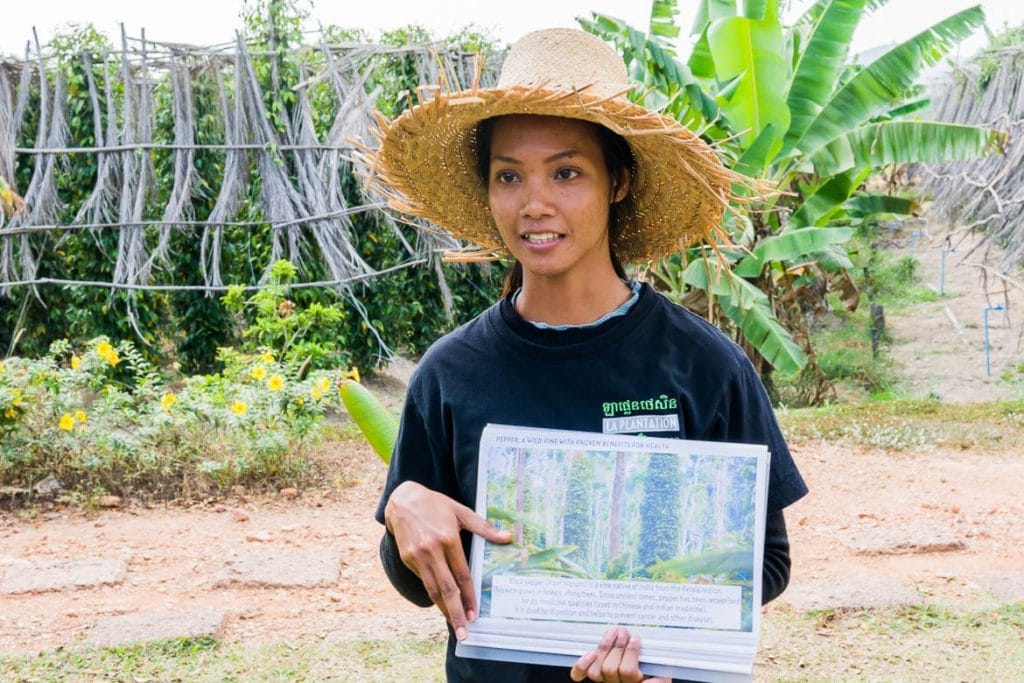
Activities of Food Tourism
Food tourism is much more than a list of restaurants or only high-cost activities with refined gourmet perception. It is also not focused only on agritourism. Nor does it require distant travels. It is related to all activities that use food as a means of connection between people, places, and time .
Food tourism is composed of activities that provide experiences of consumption and appreciation of food and beverages, presented in such a way that values the history, the culture, and the environment of a particular region. Food’n Road
Examples of Food Tourism activities:
- Take a street food tour;
- Tasting of local dishes and beverages;
- Follow regional product routes (e.g., travel on wine or coffee routes);
- Eat at traditional restaurants;
- Share meals with local people;
- Participate in food events and festivals;
- Visit local markets;
- Learn about the production of food by visiting farms and artisan producers;
- Participate in cooking classes;
- Visit exhibitions that explain the history of local cuisine;
- Culinary expeditions with chefs and specialists.
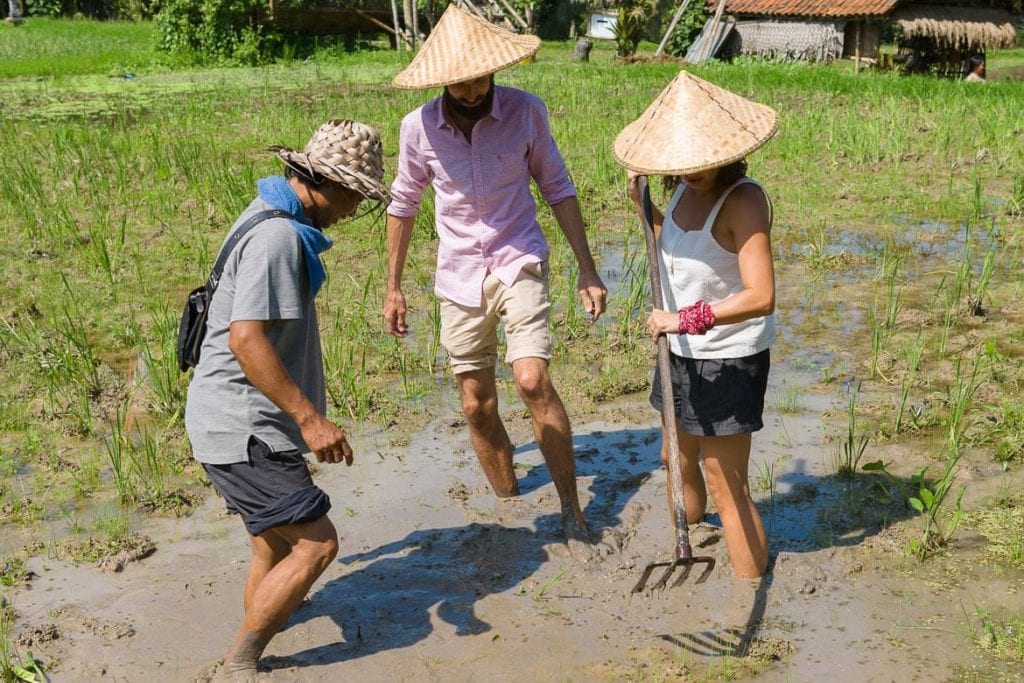
The list is huge, and there are several models of gastronomy-related activities. It is a creative market because it embraces different representatives of the food, beverage, and hospitality industry. We are talking about: restaurants, farms, markets, artisan producers, hotels and hostels, street food vendors, chefs, galleries, and everything related.
Read more: The main types of activities in food tourism
What are the benefits of Food Tourism and why we support it!
Food tourism with a focus on cultural immersion is a strong ally for economic and social development , in addition to being unique and memorable for the traveler .
When done in the right way, food tourism, built together with the local community and respecting its identity, is a tool for changing two scenarios: the negative impacts of tourism (we explain better below) and the detachment between people and real food.
Food Tourism is related to all activities that use food as a means of connection between people, places and time. Food’n Road
Tourism is not always associated with sustainable development. Many destinations are experiencing difficulties with regional and seasonal asymmetries. In other cases, local communities have been affected by massive tourism through gentrification, rising prices, and often attracting tourists with little awareness of their behavior and demands on the local community.
The scenario is quite different with a type of tourism that motivates people to know the countryside, diversified with food seasonality, and attracting people who seek to understand and relate in a more personal and respectful way to the local culture .
Read more about the benefits of Food Tourism
To strengthen this type of tourism, is it necessary to connect people in a more integrated way with the destination, and food does it very well!
At Food’n Road, we want to be agents of change, engage people to reflect about food beyond the plate, and contribute to responsible tourism development. We believe that every reflection starts with reliable information and is intensified with good experiences. Thus, food tourism is an excellent tool to initiate this change.
Did you like the idea? So find out now how to make a Food Trip !
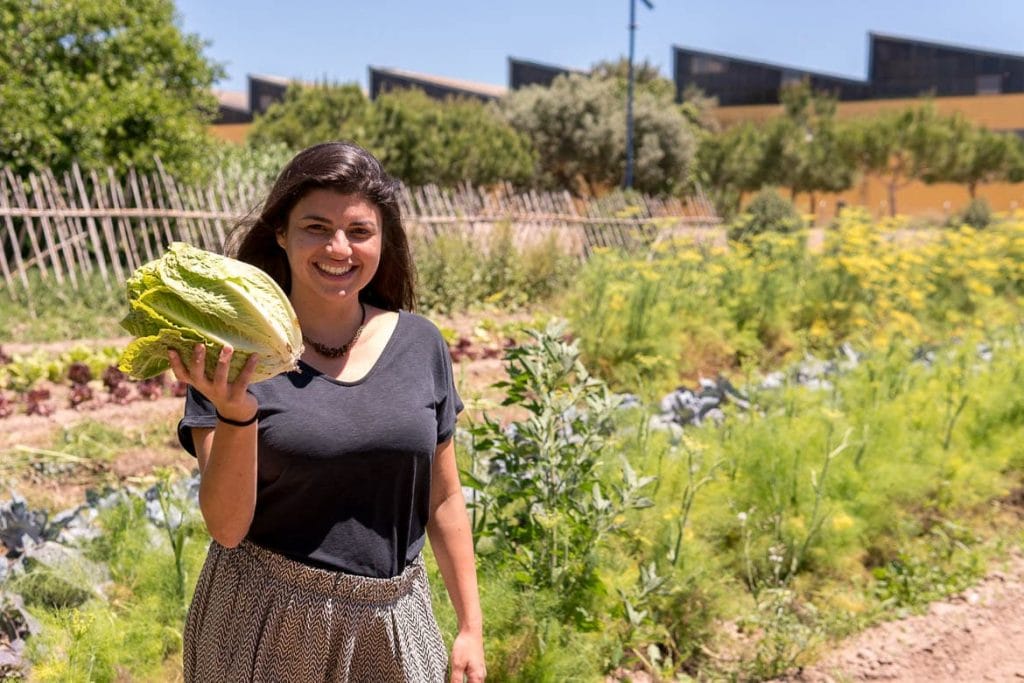
- .wp-block-kadence-advancedheading mark{background:transparent;border-style:solid;border-width:0}.wp-block-kadence-advancedheading mark.kt-highlight{color:#f76a0c;}.kb-adv-heading-icon{display: inline-flex;justify-content: center;align-items: center;}.single-content .kadence-advanced-heading-wrapper h1, .single-content .kadence-advanced-heading-wrapper h2, .single-content .kadence-advanced-heading-wrapper h3, .single-content .kadence-advanced-heading-wrapper h4, .single-content .kadence-advanced-heading-wrapper h5, .single-content .kadence-advanced-heading-wrapper h6 {margin: 1.5em 0 .5em;}.single-content .kadence-advanced-heading-wrapper+* { margin-top:0;} .wp-block-kadence-advancedheading.kt-adv-heading_c4edf0-15, .wp-block-kadence-advancedheading.kt-adv-heading_c4edf0-15[data-kb-block="kb-adv-heading_c4edf0-15"]{padding-bottom:0px;margin-top:-20px;margin-bottom:0px;font-size:14px;font-style:normal;}.wp-block-kadence-advancedheading.kt-adv-heading_c4edf0-15 mark, .wp-block-kadence-advancedheading.kt-adv-heading_c4edf0-15[data-kb-block="kb-adv-heading_c4edf0-15"] mark{font-style:normal;color:#f76a0c;padding-top:0px;padding-right:0px;padding-bottom:0px;padding-left:0px;} We promote Food Tourism as a tool for connection and local development. Company Who we are
Food Tourism: What It Means And Why It Matters

Kristen Fleming holds a Master of Science in Nutrition. Over her 8 years of experience in dietetics, she has made significant contributions in clinical, community, and editorial settings. With 2 years as a clinical dietitian in an inpatient setting, 2 years in community health education, and 4 years of editorial experience focusing on nutrition and health-related content, Kristen's expertise is multifaceted.
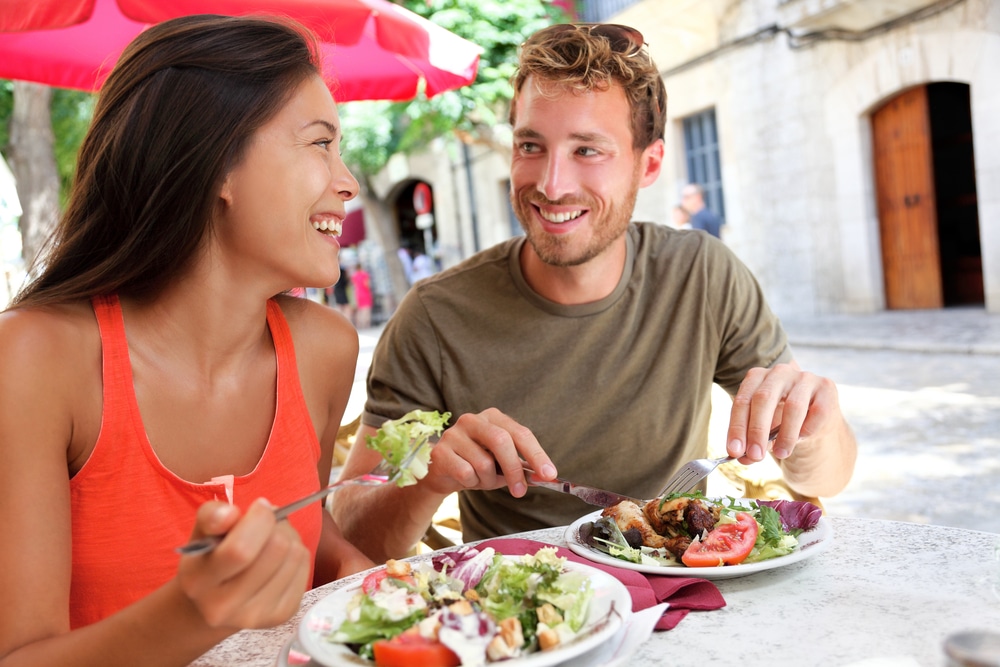
Food. Many love to eat it, some love to cook it, and others simply love to talk about it. It is no secret that food plays a significant role in our lives. And while we all have our own unique relationship with food, there is one thing that we can all agree on – food is an experience .
Food tourism is the act of traveling for the purpose of experiencing food. This can be anything from going on a wine tour to visiting a local farmer’s market. Food tourism has become a popular way to travel in recent years as it provides people with an opportunity to connect with the local culture through food.
Would you be interested in learning more about food tourism? Keep reading to find out what it is, why it matters, and some tips on how to get the most out of your food tourism experience.
What Is The Meaning Of Food Tourism?
Travelers often seek out destinations that offer them a chance to sample the local cuisine. This type of tourism is known as food tourism. It’s also called culinary tourism or gastronomy tourism.
Food tourism can take many different forms. It can be as simple as trying a new dish while on vacation, or it can involve planning an entire trip around visiting different restaurants and food festivals ( 8 ).
Some people even choose to study culinary tourism, which is a field that combines the elements of anthropology, sociology, and economics to understand how food can be used as a tool for cultural exchange ( 2 ).
No matter how you define it, food tourism is a growing trend all over the world. And it’s not just about trying new foods – it’s about understanding the culture and history behind them.

What Are The Characteristics Of Food Tourism?
Food tourism includes any type of travel that revolves around experiencing food ( 6 ) ( 7 ). This can range from eating street food in Thailand to taking a cooking class in Italy.
Some of the most common activities associated with food tourism are:
Visiting Local Markets
Local markets are a great way to get a feel for the local cuisine. They also offer an opportunity to buy fresh, locally-sourced ingredients.
Trying Street Food
Street food is a staple in many cultures and a great way to sample the local cuisine. It is often less expensive than sit-down restaurants and offers a more authentic experience.
Attending Food Festivals
Food festivals are a great way to try a variety of local dishes in one place. They also offer the opportunity to learn about the culture and history behind the food ( 10 ).
Taking Cooking Classes
Cooking classes are a great way to learn about the local cuisine and how to cook traditional dishes. One may learn new cooking techniques, as well as about the culture and history behind the food.
Touring Wineries And Breweries
A common misconception is that food tourism only includes food and not beverages. However, touring wineries and breweries is a great way to learn about the local culture and taste the local products.
At a winery, one can learn about the wine-making process and taste the different types of wine produced in the region.
At a brewery, one can learn about the brewing process and taste the different types of beer produced in the region.
Some regions may be known for a certain type of spirit, and you can visit distilleries for those as well.
Read More: No Carb No Sugar Diet Meal Plan: Is It Healthy For Weight Loss?

Eating At Michelin-Starred Restaurants
Fine dining is another aspect of food tourism. Michelin-starred restaurants are known for their excellent food and service.
While at it, one can also learn about the chef, the history of the restaurant, and the thought that goes into each dish.
Touring Food Factories
Food factories offer a behind-the-scenes look at how food is produced. This can be anything from a chocolate factory to a pasta factory.
Touring food factories is a great way to learn about the production process and see how the food is made.

What Are The Benefits Of Food Tourism?
Food tourism can have a positive impact on both the traveler and the destination.
Benefits For The Traveler
Food tourism is becoming increasingly popular, and with good reason.
For travelers, it ( 5 ):
- Offers the opportunity to try new foods and experience new cultures.
- Is a great way to learn about the history and culture behind the food.
- Can be a more authentic and immersive experience than other types of tourism.
- Is a great way to support local businesses and the local economy.
- Can be a great way to meet new people and make new friends.
Benefits For The Destination
Food tourism can also have a positive impact on the destination.
For destinations, food tourism:
- Can help to promote the local cuisine and culture.
- Is a great way to attract visitors and boost the local economy.
- Can help to create jobs and support local businesses ( 1 ).
- Can help to improve the image of the destination.
- Can help to preserve traditional foods and recipes.
BetterMe app is a foolproof way to go from zero to a weight loss hero in a safe and sustainable way! What are you waiting for? Start transforming your body now !
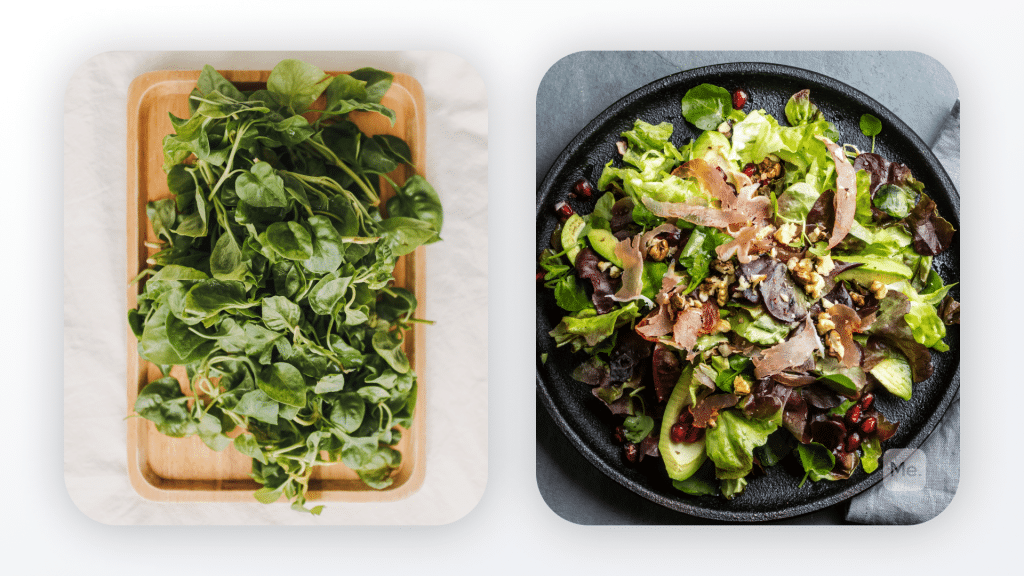
What Are The Challenges Of Food Tourism?
While food tourism can have many positive benefits, there are also some challenges that need to be considered. These include:
1. Ensuring Food Safety And Hygiene Standards Are Met
Food safety is a major concern when traveling, and food-borne illnesses can ruin a trip ( 11 ). It is important to research the restaurants and markets before eating anything .
Using your common sense and following basic hygiene rules (such as washing your hands) can also help to reduce the risk of getting sick.
2. Ensuring Food Is Ethically And Sustainably Sourced
With the rise of food tourism, there is a danger that destinations will start to mass-produce food for tourists, rather than focus on quality. This can lead to unethical and unsustainable practices , such as using forced labor or over-fishing ( 3 ) ( 4 ).
3. Managing The Impact On The Environment
Food tourism can have a negative impact on the environment if it is not managed properly. For example, if too many people visit a destination, it can lead to pollution and damage to the local ecosystem ( 9 ).
4. Ensuring Fair Working Conditions For Those Involved In The Food Industry
The food industry is often characterized by low pay and long hours. This can be a problem for those working in the industry, as they may not be able to earn a decent wage or have enough time to rest.
5. Addressing The Issues Of Food Waste And Overconsumption
Food tourism often involves trying new and different foods . However, this can lead to food waste if people do not finish their meals or if they order more than they can eat.
It is important to be aware of the issue of food waste and to try to minimize it where possible.

Where Is Food Tourism Most Popular?
Food tourism is particularly popular in countries with strong culinary traditions. Below are several examples of such destinations, along with a description of what they offer food tourists .
Porto (Portugal)
Porto is known for its port wine, which is produced in the surrounding Douro Valley. The city also has a number of traditional restaurants serving Portuguese cuisines such as bacalhau (codfish) dishes and francesinha (a sandwich with meat, cheese, and ham).
Lisbon (Portugal)
Lisbon is another Portuguese city with a strong culinary tradition . The city is known for its seafood, as well as for pastries such as the Pasteis de Belem (a type of custard tart).
Palermo (Italy)
Palermo is the capital of Sicily, an island with a rich culinary tradition. The city is known for its street food, which includes dishes such as arancini (fried rice balls) and panelle (fried chickpea fritters).
Vientiane (Laos)
Vientiane is the capital of Laos, and its cuisine reflects the influence of both Thai and Vietnamese cuisine. The city is known for dishes such as laab (a type of meat salad) and khao soi (a noodle soup).
San Sebastian (Spain)
San Sebastian is a Basque city located in northern Spain. The city is known for its pintxos (small plates) and for Basque dishes such as txakoli (a type of white wine) and cod with pil-pil sauce.
Paris (France)
Paris is one of the most popular food tourism destinations in the world. The city is known for its fine dining, as well as for its more casual bistros and cafes.
Paris is also home to a number of markets, such as the famous Les Halles market, where food tourists can sample a variety of French specialties.
Read More: What Is The Ideal Ketosis Level For Weight Loss? How To Monitor Ketones

New York City (USA)
New York City is another popular food tourism destination. The city offers a wide range of cuisines, from traditional American dishes to the cuisine of its many immigrant communities.
New York is also home to a number of famous restaurants, such as the Russian Tea Room and the Rainbow Room.
Tokyo (Japan)
Tokyo is a city with a rich culinary tradition. The city is known for its sushi and ramen, as well as for its more traditional dishes such as tempura and yakitori. Tokyo is also home to a number of Michelin-starred restaurants, making it a popular destination for food tourists.
Tips For Food Tourism
If you’re interested in trying out different cuisines while traveling, there are a few things you can do to make the most of your food tourism experience.
Do Some Research Before You Go
Read up on the cuisine of the place you’re visiting, and try to find out what dishes are particularly popular. This will help you narrow down your options and make sure you don’t miss out on any must-try dishes.
Don’t Be Afraid To Ask For Recommendations
When you’re in a new city, ask the locals where they like to eat. They’ll be able to point you in the direction of some great places to try.

Be Open To New Experiences
When you’re trying out new cuisine, don’t be afraid to experiment. You might find that you like something that you never would have thought to try before.
Respect Local Customs And Traditions
When you’re traveling, it’s important to remember that not everyone does things the same way as you do. Be respectful of local customs and traditions, and try not to offend anyone.
Enjoy Yourself!
Food tourism should be about enjoying new experiences and trying new things. So relax, and enjoy the ride.
The Bottom Line
Food tourism is a growing trend, and there are many destinations around the world that offer something for everyone. Whether you’re looking for fine dining or street food, it’s sure there’s a place that will suit your taste.
DISCLAIMER:
This article is intended for general informational purposes only and does not address individual circumstances. It is not a substitute for professional advice or help and should not be relied on to make decisions of any kind. Any action you take upon the information presented in this article is strictly at your own risk and responsibility!
- A study on the importance of Food Tourism and its impact on Creating Career 2017 (2017, researchgate.net)
- Culinary Tourism (2014, link.springer.com)
- Darker still: Present-day slavery in hospitality and tourism services (2013, researchgate.net)
- Disentangling tourism impacts on small-scale fishing pressure (2022, sciencedirect.com)
- Food and tourism synergies: perspectives on consumption, production, and destination development (2017, tandfonline.com)
- Foodies and Food Events (2014, tandfonline.com)
- Food tourism value: Investigating the factors that influence tourists to revisit (2019, sagepub.com)
- Global report on food tourism (2012, amazonaws.com)
- Re-evaluating the environmental impacts of tourism: does EKC exist? (2019, link.springer.com)
- Reviving Traditional Food Knowledge Through Food Festivals. The Case of the Pink Asparagus Festival in Mezzago, Italy (2020, frontiersin.org)
- The Importance of Food Safety in Travel Planning and Destination Selection (2008, tandfonline.com)
I've struggled to maintain programs…
Our Journey
It Works! This program is working for me!

Does Matcha Have Caffeine?

Why Am I Craving Chocolate? The Reasons Beyond the Sweet Tooth and How to Fix It

Top 10 Healthy Alternatives to Sodas With Many Flavor and Ingredient Varieties

What are Rolled Oats? Explore the Benefits and Hearty Recipes

From TikTok to Table: The Rise and Risks of the Oatzempic Craze

Choose a Healthy Alternative to Chips to Lose Weight or Follow a Healthier Eating Plan

- For Business
- Terms of Service
- Subscription terms
- Privacy Policy
- Money-back Policy
- e-Privacy Settings
- Your Privacy Choices

Culinary tourism: The growth of food tourism around the world
Disclaimer: Some posts on Tourism Teacher may contain affiliate links. If you appreciate this content, you can show your support by making a purchase through these links or by buying me a coffee . Thank you for your support!
Culinary tourism is a popular type of tourism throughout the world, but what exactly is culinary tourism? Is it different from food tourism? Why is culinary tourism important? And where are the best places to travel for culinary tourism? Read on to find out…
What is culinary tourism?
Importance of food tourism, culinary tourism activities, culinary tourism in bangkok, culinary tourism in tokyo, culinary tourism in honolulu, culinary tourism in durban, culinary tourism in new orleans, culinary tourism in istanbul, culinary tourism in paris, culinary tourism marrakesh, culinary tourism in mumbai, culinary tourism in miami, culinary tourism rio de janeiro, culinary tourism in beijing, food tourism- further reading.
Culinary tourism, also often referred to as food tourism, is all about exploring food as a form of tourism. Whether that be eating, cooking, baking, attending a drinks festival or visiting a farmers market – all of these come under the concept of culinary tourism. It’s something you don’t even really need to travel to do. Heading to your nearest big city or even the next town over, specifically to eat at a certain restaurant, classes as food tourism! And food tourism has taken a new twist since the COVID pandemic too, when many people would cook or eat a variety of different foods from around the world in attempt to bring an element of travel to their own home! Who said you need to travel far to be a culinary tourist, huh?
Food tourism is a vitally important component of the travel and tourism industry as a whole. When booking a trip, people tend to consider a variety of factors – and food is high on the list of priorities. The World Food Travel Association says that money spent on food and drink while travelling accounts for 15-35% of all tourism spending. Culinary tourism is important in that it generates so much money for local economies.

Culinary tourism is also an important branch of tourism in that it can promote local businesses, as well as help to shine a light on different cuisines. For so many cultures, their cuisine is a huge part of who they are. Culinary tourism helps to celebrate this, by attracting interested tourists who are keen to try something new and share it with the world. In this way, it definitely helps to boost community pride and is a great example of cultural tourism .
This type of tourism is also important to tourists. It provides a chance to try new foods and flavours, and discover new cultures through their taste buds. Visitors who engage in food tourism come away with new recipes to try, new foods to introduce their friends to, and memories that they will always associate with their sense of taste.
There are many activities which come under the remit of culinary tourism, or food tourism. I mentioned some above, but let’s take a closer look.
- Eating and drinking out: going to restaurants, cafes, bars, pubs, tea shops and so on. These are all examples of culinary tourism.
- Food/beverage tours: you can book onto organised food and drink tours when visiting a new city. These are run by guides who will take you to various foodie spots throughout the city – usually small businesses – to try local delicacies.
- Farmers markets: visiting a farmers market at the weekend to buy fresh produce is seen as a form of food tourism.
- Cooking classes: another activity you can get involved with on your travels is a cooking or baking class. You’ll often make, again, a local delicacy whether that be pierogi in Poland or pasta in Italy . Tasting sessions: brewery tours and vineyard visits (and other similar excursions) where you get to take a look at how something is made and then try it for yourself are another form of culinary tourism.
Best cities for food tourism
Most cities, major or otherwise, have excellent examples of food tourism. In fact – this goes right down to tiny towns and villages, some of which have incredible restaurants or bars that are real hidden gems. Below you’ll find some of the world’s best cities for culinary tourism, however, with examples of the sort of thing you can do there!

Thai food is some of the best food around, and Bangkok has a lot of restaurants suited to all budgets. Eating out in Bangkok is a brilliant example of culinary tourism. One of the best things you can do here is try the local street food! Wang Lang Market is one of the most popular places for street food, with fresh food filling the lanes from snacks to full-on meals. Silom Soi 20 is another great spot in central Bangkok, perfect for the morning.
Looking for somewhere really unique to eat in Bangkok? Head to Cabbages and Condoms , a themed cafe decorated with (you guessed it) condoms. The restaurant say they were ‘conceptualized in part to promote better understanding and acceptance of family planning and to generate income to support various development activities of the Population and Community Development Association (PDA)’.

Tokyo is a very popular city, and one of the best ways to experience food tourism here is to book onto a food tour. Tokyo Retro Bites is a fantastic one, giving you a feel of old-style Tokyo at the quaint Yanaka Market. This is a walking tour which includes drinks and 5 snacks, lasting 2 hours. It starts at 11.30am meaning it’s a great chance to have lunch somewhere a bit different!

This beautiful Hawaiian city has so many fun places to eat (and drink!) while visiting. One of the best things to do in terms of culinary tourism is to eat somewhere you wouldn’t be able to eat at home – and try new flavours or dishes. Honolulu is the perfect place to do this. Some interesting eateries include:
- Lava Tube – based in Waikiki, this 60s-kitsch style bar offers pina coladas served in giant pineapples, $5 Mai Tais, delicious food and plenty of fun decor.
- Suzy Wong’s Hideaway – this is described as a ‘dive bar with class’ and is a great bar to visit to watch sports games.
- MW Restaurant – this is a really famous and creative place to eat in Honolulu – the mochi-crusted Kona Kanpachi comes highly recommended and helped shoot the chef, Wade Ueoka, to fame.

Hailed as the world’s best food city, a list of places for food tourists to visit has to include Durban in South Africa . Bunny Chow is a local delicacy that you cannot miss while visiting Durban. It is now available elsewhere, but the original is usually the best so be sure to try some while in the city. The dish is half a loaf of bread hollowed out and filled with curry – delicious. This article shares 5 fantastic spots to get Bunny Chow in Durban !

As one of the culinary capitals of the US, New Orleans is incredibly popular with foodies. The city is a hotspot for food tourism, thanks to the various cultural roots here: Cajun, Creole and French. There is a whole range of tastes to try. You could spend your time here *just* eating and still not scratch the surface when it comes to the amazing restaurants, cafes and eateries in NOLA. Some foods you have to try include:
- Po’boys: fried shrimp, generally, but sometimes beef or other seafood – served on a fresh crusty roll.
- Gumbo : this is a stew, again usually containing seafood, alongside bell peppers, onion and celery.
- Crawfish etouffee: a French crawfish stew served over rice.
- Muffuletta: a Silician-American sandwich served on a specific type of bread.
- Side note, you can do a haunted pub crawl in NOLA . Would you?!

Being split across two continents, it is no surprise that Istanbul as a city has a huge range of delicious food-related activities. From kebabs sold on the street to 5 star restaurants serving the finest hummus, Istanbul is a fantastic destination for food tourism. Book onto the ‘Two Markets, Two Continents’ tour – you’ll visit two markets, as the name suggests, on the two continents. The tour includes a Bosphorus ferry crossing between the two districts of Karaköy (Europe) and Kadiköy (Asia). You’ll enjoy breakfast, tea and coffee, meze, dessert and so much more during this 6.5 hour tour .

The city of love – and the city of bakeries! Fresh baguettes, simple croissants, delicious eclairs… the list goes on. There are so many of them dotted around, whether you want something to grab and snack on while you head to the Eiffel Tower or if you want a sit down brunch, you’ll find one that suits you perfectly.
And that’s not all. Paris, also famous for its snails, soups and frogs legs, has so many fine dining opportunities. You’ll be spoilt for choice in terms of Michelin star restaurants: Boutary, ASPIC, 114 Fauborg and so many more. There are also some fantastic food tours in Paris . If you have the cash to splash out, fine dining in Paris is a brilliant culinary tourism activity…

Moroccan food is delicious. And you can try making it yourself during a cooking class in Marrakech ! Visit a traditional souk and try your hand at some tasty recipes – you never know, you might have a hidden talent. Some tours even include shopping for ingredients, so you can visit a traditional market too; these are a sensory dream with so many smells, colours, sounds and sights.

India is another country where street food is king. Mumbai has plenty to offer, and one culinary tourism activity you can do is to spend an afternoon trying as many dishes as possible while simply wandering through the city. If you’ve never tried a vada pav before, this is the place to do so: it’s essentially deep fried mashed potato in a bun with various chutneys, and it is exquisite. Many people are surprised to learn that one of the most popular British foods – chicken tikka masala is not commonly found in India, but fear not, there are many other dishes that are just as goods or if not better!

Miami is known for its food – and Cuban food is a big deal here. Take a traditional Cuban cooking class , or head to one of the many, many Cuban restaurants here . There is something for every budget, and your tastebuds will certainly thank you. It is also close to Key West, a wonderful place to visit for a day or two. They’re big on sea food here, and walking tours which incorporate seafood are high on the list of recommended things to do in beautiful Key West.

You cannot go to Rio and not try cahaça. This is Brazilian brandy made from sugar canes, and it is a big deal over here. Culinary tourism isn’t limited to food – it includes drink too, so head to one of Rio’s many bars and try a caipirinha. You can even book an organised pub crawl , which includes free shots and drinks, around the city. This is perfect if you want to explore at night knowing you’ll be safe and always have transport on hand.

Peking duck is the highlight of Beijing food. Quanjuede is world-famous for its Peking duck, and it’s not too expensive. There are branches worldwide now, though, and much of culinary tourism is about experiencing something you won’t be able to elsewhere. Speak to the locals when you’re there and ask where their favourite place is for Peking duck. That way you’ll know you are supporting a great local business; as mentioned, food tourism is great for boosting the economy this way!
If you have enjoyed this article about culinary tourism, or food tourism, then I am sure that you will love these too!
- What is pilgrimage tourism and why is it important?
- What is red tourism and why is it growing so fast?
- Overtourism explained: What is it and why is it so bad?
- Enclave tourism: A simple explanation
Liked this article? Click to share!
Culinary Tourism
- Living reference work entry
- First Online: 01 January 2014
- Cite this living reference work entry

- Lucy M. Long 3
4112 Accesses
16 Citations
Cultural tourism ; Food tourism ; Gastronomic tourism ; Sustainable tourism
Introduction
Culinary tourism is the focus on food as an attraction for exploration and a destination for tourism. Although food has always been a part of hospitality services for tourists, it was not emphasized by the tourism industry until the late 1990s. It now includes a variety of formats and products – culinary trails, cooking classes, restaurants, farm weekends, cookbooks, food guides, and new or adapted recipes, dishes, and even ingredients. While most culinary tourism focuses on the experience of dining and tasting of new foods as a commercial enterprise, it is also an educational initiative channeling curiosity about food into learning through it about the culture of a particular cuisine, the people involved in producing and preparing it, the food system enabling access to those foods, and the potential contribution of tourists to sustainability.
Culinary tourism involves numerous issues; many...
This is a preview of subscription content, log in via an institution to check access.
Access this chapter
Institutional subscriptions
Boniface, P. (2003). Tasting tourism: Travelling for food drink . Burlington: Ashgate.
Google Scholar
Chambers, E. (2010). Native tours: The anthropology of travel and tourism (2nd ed.). Long Grove: Waveland Press.
Gmelch, S. B. (2010). Tourists and tourism: Reader (2nd ed.). Long Grove: Waveland Press.
Hall, C. M., & Sharples, L. (2008). Food and wine festivals and events around the world . London: Butterworth-Heinemann.
Hall, C. M., Sharples, L., Mitchell, R., & Macionis, N. (2003). Food tourism around the world: Development, management and markets . London: Butterworth-Heinemann.
Heldke, L. (2003). Exotic appetites: Ruminations of a food adventurer . New York: Routledge.
Heldke, L. (2005). But is it authentic? Culinary travel and the search for the ‘Genuine Article.’. In K. Carolyn (Ed.), The taste culture reader: Experiencing food and drink (pp. 385–394). New York: Berg.
Hjalager, A.-M., & Richards, G. (Eds.). (2002). Tourism and gastronomy . London: Routledge.
Long, L. (2004). Culinary tourism: Eating and otherness . Lexington: University Press of Kentucky.
Long, L. M. (2010). Culinary Tourism in and the Emergence of Appalachian Cuisine: Exploring the “Foodscape” of Asheville, NC. North Carolina Folklore Journal 57.1 (Spring-Summer), pp. 4–19.
Meethan, K. (2001). Tourism in a global society: place, culture, consumption. Basinstoke: Palgrave.
Ritzer, G. (1993). The McDonaldization of society: An investigation into the changing character of contemporary social life. London: Pine Forge Press.
O’Connor, K. (2008). The Hawaiian Luau: Food as tradition, transgression, transformation and travel. Food, Culture, and Society, 11 (2), 149–171.
Wilk, R. (2006). Home cooking in the global village . Oxford: Berg.
Wolf, E. (2006). Culinary tourism: The hidden harvest . Dubuque: Kendall/Hunt.
Zilensky, W. (1985). The roving palate: North America’s ethnic restaurant cuisines. Geoforum, 16 (1), 51–72.
Article Google Scholar
Food, Culture, and Society: An International Journal of Multidisciplinary Research. New York: Bloomsbury Publishing.
Journal of Sustainable Tourism . Taylor & Francis.
Download references
Author information
Authors and affiliations.
Center for Food and Culture, 1001 East Wooster Street, Bowling Green, OH, 43403-0001, USA
Dr. Lucy M. Long
You can also search for this author in PubMed Google Scholar
Corresponding author
Correspondence to Lucy M. Long .
Editor information
Editors and affiliations.
Michigan State University Dept. Philosophy, East Lansing, Michigan, USA
Paul B. Thompson
University of North Texas Dept. Philosophy & Religion Studies, Denton, Texas, USA
David M. Kaplan
Rights and permissions
Reprints and permissions
Copyright information
© 2013 Springer Science+Business Media Dordrecht
About this entry
Cite this entry.
Long, L.M. (2013). Culinary Tourism. In: Thompson, P., Kaplan, D. (eds) Encyclopedia of Food and Agricultural Ethics. Springer, Dordrecht. https://doi.org/10.1007/978-94-007-6167-4_416-1
Download citation
DOI : https://doi.org/10.1007/978-94-007-6167-4_416-1
Received : 13 May 2013
Accepted : 13 May 2013
Published : 11 February 2014
Publisher Name : Springer, Dordrecht
Online ISBN : 978-94-007-6167-4
eBook Packages : Springer Reference Religion and Philosophy Reference Module Humanities and Social Sciences Reference Module Humanities
- Publish with us
Policies and ethics
- Find a journal
- Track your research
- Skift Research
- Airline Weekly
- Skift Meetings
- Daily Lodging Report
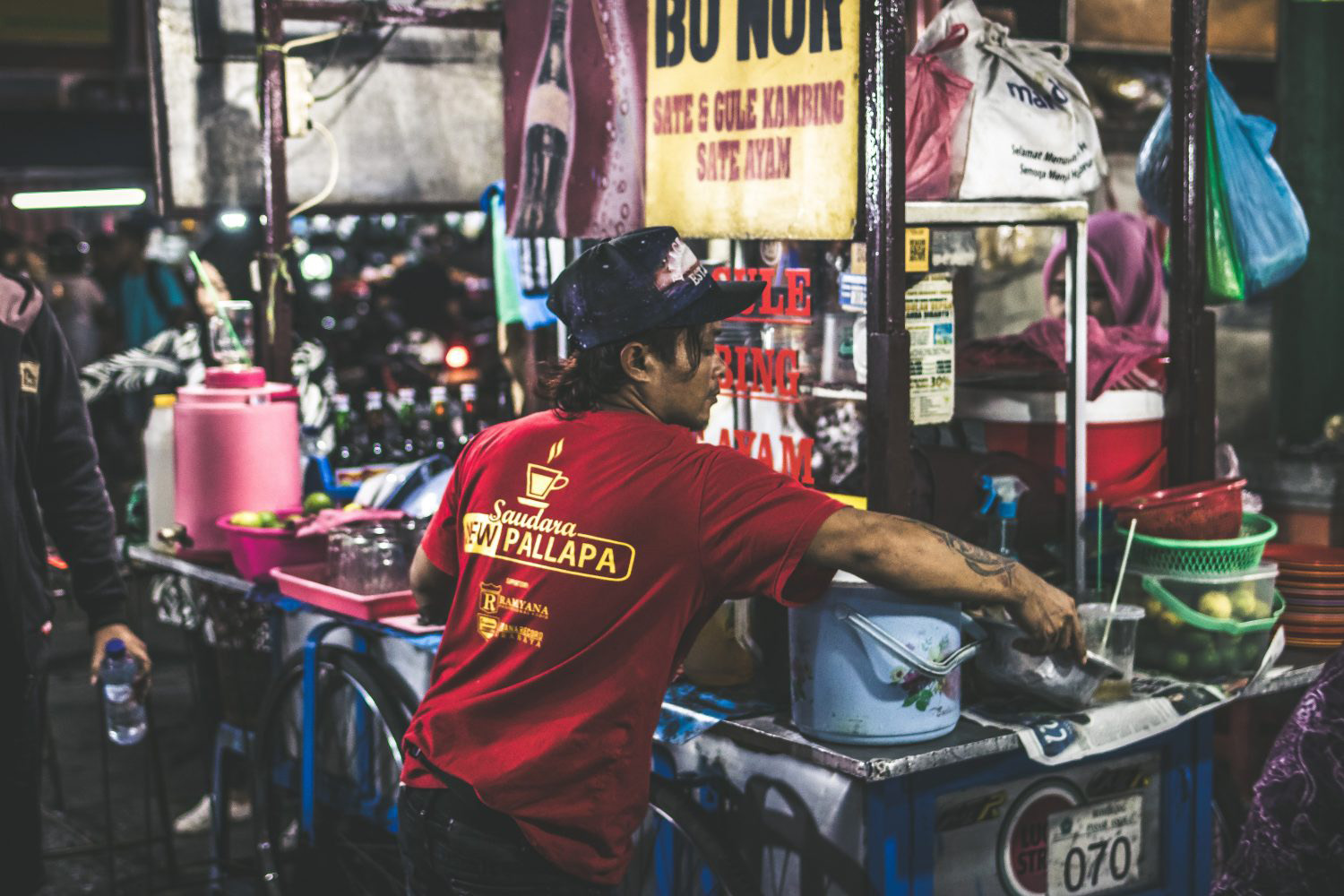
The New Era of Food Tourism: Trends and Best Practices for Stakeholders
Related reports.
- State of Travel 2023: Travel in 250 Charts July 2023
- Destination Marketing Outlook 2022 January 2022
- Sustainability in Travel 2021: Quantifying Tourism Emissions for Destinations June 2021
- EU Traveler Profile and Key Statistics: The Impact of COVID-19 January 2021
Report Overview
Over the past few years, food tourism has been a buzzy trend in the travel industry. Not only is it appealing to a large population of travelers, but it also has the potential to boost in-destination spending, and therefore, positively benefit local economies and small businesses. Despite the buzz, the conversation around food tourism has hardly changed since it first started to spread years ago. Not to mention, there is still some confusion about what food tourism really is and how destinations and other stakeholders can get involved.
In this report, we focus on addressing four questions under the food tourism umbrella: How big and important is the food tourism market? What are the new trends related to food tourism? Who should be be involved in and benefit from food tourism? What are the best practices for various stakeholders? We attempt to answer these questions drawing from the second, expanded iteration of our proprietary food tourism consumer survey. Then, we turn toward breaking down the new definition of food tourism into five components, drawing mostly from a number of in-depth interviews with industry stakeholders and experts. These perspectives then contribute to the final section of the report, in which we have identified 10 best practices for food tourism stakeholders.
Survey Methodology:
Skift Research’s Food Tourism Survey 2019 collected responses from 2,000 respondents who live in the U.S. The survey was fielded to internet users age 18 and over. Respondents were asked whether they’ve taken a leisure trip in the past 12 months that included at least one-night’s paid stay and was 50 miles or more from home. We refer to this group as “recent travelers” (N=1,373) to compare to the total population (“all respondents”, N=2,000). The survey was fielded by a trusted third-party consumer panel provider.
What You'll Learn From This Report
- What food tourism means and how it has evolved over time
- Who the stakeholders are in food tourism
- A comprehensive look at who food tourists are today, how they behave, and what they prefer
- Skift Research estimates for food and beverage expenditure by U.S. travelers
- Size of U.S. food tourist population
- The kinds of food and beverage based activities food tourists are most likely to participate in
- The percentage of food tourists who have taken a vacation with a food and beverage experience as the main purpose for the trip
- A five-part breakdown of the new definition of food tourism
- 10 best practices for food tourism stakeholders today
Executives Interviewed
- Benjamin Ozsanay - CEO & Co-Founder, Cookly
- Camille Rumani - COO & Co-Founder, Eatwith
- Didier Souillat - CEO, Time Out Market
- Erik Wolf - Executive Director, World Food Travel Association
- Helena Williams, Ph.D. - Researcher, Tourism & Hospitality, Texas Tech University and CEO, Gastro Gatherings
- James Imbriani - Founder, Sapore Travel
- Javier Perez-Palencia - CEO and Chair of the Board, FIBEGA Miami 2019 International Gastronomy Tourism Fair
- Joanne Wolnik - Tourism Development Manager, Ontario’s Southwest
- Michael Ellis - Chief Culinary Officer, Jumeirah Group
- Robert Williams, Jr. PhD. - Susquehanna University and Senior Partner, Mar-Kadam Associates
- Trevor Jonas Benson - Director of Food Tourism Innovation and lead consultant, Grow Food Tourism at the Culinary Tourism Alliance
Executive Summary
In 2016, Skift Research published a report called Food Tourism Strategies to Drive Destination Spending . This was at a time when “food tourism” was taking off as a buzzy trend in the travel industry. Now, almost three years later, we’re taking a look at where food tourism is today, how it’s changed, and best practices for stakeholders.
Food tourism is often approached with the destination in mind, as Skift Research did in 2016, and developing and promoting it is often cast off as the sole responsibility of destination marketing organizations (DMOs) or regional tourism offices (RTOs). Clearly, these organizations have important roles to play, but they don’t exist alone when it comes to food tourism. In the new era of food tourism, many stakeholders have the opportunity to help develop, promote, and eventually benefit from this type of tourism.
In this report, we lay out what food tourism is today and how it has changed from years past. We build this definition from an in-depth understanding of who food tourists are today, drawing from the second, expanded iteration of our proprietary food tourism consumer survey. After providing a comprehensive look at the consumer side of the equation, we turn toward breaking down the new definition of food tourism into five components, drawing mostly from a number of in-depth interviews with industry stakeholders and experts. These perspectives then contribute to the final section of the report, in which we have identified 10 best practices for food tourism stakeholders.
Food Tourism Demystified and Defined
Terminology.
These are a few commonly used terms that encompass food and beverage tourism experiences:
- Culinary tourism: Some sources prefer using this term because it more clearly encompasses beverage-based experiences in addition to food-based.
- Gastronomy tourism: Similarly to “culinary tourism,” some sources prefer this term because of its all-encompassing connotation. This term is most commonly used in Europe.
- Food tourism: As of 2012, the World Food Travel Association (WFTA) began using the term “food tourism” or “food travel” to describe “the act of traveling for a taste of place in order to get a sense of place,” or put differently, “the act of traveling to experience unique food and beverage products and experiences.” Rather than the type of experience being the differentiator, what matters is the uniqueness of the experience itself and how it is particular to the destination.
For this report, we will follow the lead of the WFTA, which stopped using “culinary tourism” in 2012 when its research indicated that English speakers tend to associate this term with exclusivity and elitism, neither of which should be inherent to food tourism. “Gastronomy tourism” can also be interpreted this way, especially to English speakers outside of Europe. For these reasons, we chose to stick with food tourism, as we believe it better reflects the variety of food- and beverage-based travel experiences we will discuss in this report.
So then what counts as food tourism? This is where the lines can get blurry. Almost all tourists need to eat at an eating place while traveling, so almost all contribute to the local food economy in some way. Broadly speaking, these can all be counted as food tourism.
A bit narrower than that, some sources define food tourism as food and drinking activities that are unique to a region/destination and include aspects beyond simply eating or drinking. With this in mind, food tourism experiences most commonly include cooking classes with locals, food and drink tastings, having meals in locals’ homes, eating at local restaurants or street food vendors, food and drink tours and trails, collecting ingredients or participating in harvesting local produce, visiting farms or other types of food producers, visiting food markets or fairs, and visiting food manufacturers such as distilleries, factories, and wineries.
An even narrower scope through which to look at food tourism is whether it is deliberate food tourism or incidental food tourism. Deliberate food tourism only includes food and drinking activities that are the main motivator for a traveler to go to a destination, while incidental are those that travelers participate in, but were not the main purpose of the trip. We will discuss these terms in more detail from the consumer perspective later in the report.
Each of the above ways of describing food and beverage related tourism is correct. Variations in data on food tourism can often be due to different definitions and scopes used for the research. Later in this report, we will provide data on these three ways of counting food tourism.
Stakeholders
Another important part of food tourism to mention here is the variety of stakeholders that are involved. Developing and promoting food tourism is often discussed as responsibilities of destination marketing organizations (DMOs) or regional tourism offices (RTOs). However, this report will emphasize that there are multiple stakeholders that can, and should, have a part in building and participating in a region’s food tourism space. Of course, DMOs and RTOs can and should play important organizational and planning roles, but tour providers and operators, traditional travel agencies, online travel agencies and booking platforms, peer-to-peer platforms, hotels, local restaurateurs, and more have the opportunity for involvement in food tourism.
While this lays out the basic elements of food tourism that we’ve built this report around, it’s very likely that we will need to revisit what we’ve summarized in the near future. The term, scope, and even stakeholders will constantly evolve as destinations, cultures, and trends change over time. Later in this report, we will examine the nuances of what defines the new era of food tourism that exists today compared with a few years ago. But first, we will take a look at the current state of the food tourism space for context.
The State of Food Tourism Today
Food tourism is a lucrative market.
Just how big is the food tourism market? As we laid out above, there are three ways to size up the food tourism market. In the broadest sense, it includes all food and drink based activities that travelers partake in, whether it’s eating at a chain restaurant, taking a food tour, or visiting a local brewery.
To get a sense of food tourism’s contribution to local food economies in this broad sense, Skift Research looked at all food and beverage expenditure by U.S. travelers for domestic and international travel. We analyzed data from the U.S. Bureau of Labor Statistics Consumer Expenditure Survey to determine how much money American travelers actually spend on food and drink while traveling. While this data includes spending on all food and drink while traveling (i.e. not just the local, unique experiences that many consider “food tourism”), it nonetheless gives us an idea of the potential economic impact food tourists can have and how it has changed over time.
Our estimates show that U.S. travelers spent $58 billion on food and drink while traveling in 2017 (the last year for which data was available at the time of writing). This represents a 5.8% compound annual growth rate from 2012.
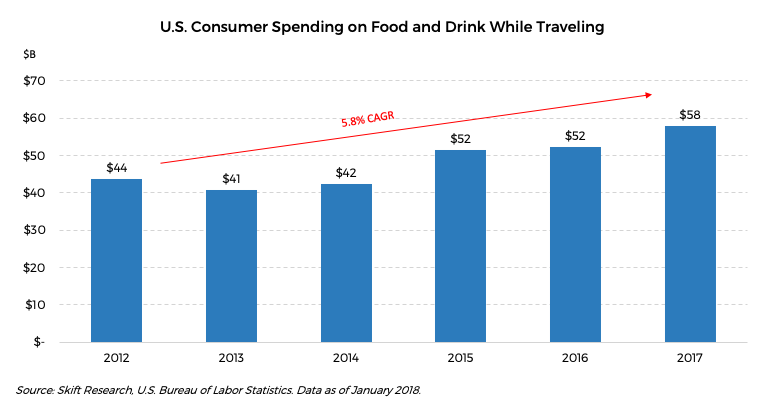
To look at this another way, we calculated the share of total travel expenditures spent on food and beverage by U.S. travelers. Here, we see an overall upward trend from 2012 to about 25%, where it has more or less hovered since 2015. This falls in line with the WFTA’s estimate from its 2016 Food Travel Monitor that global travelers spent about 25% of their travel budget on food and beverages, and this can be as high as 35% in certain destinations or for especially food-centric travelers
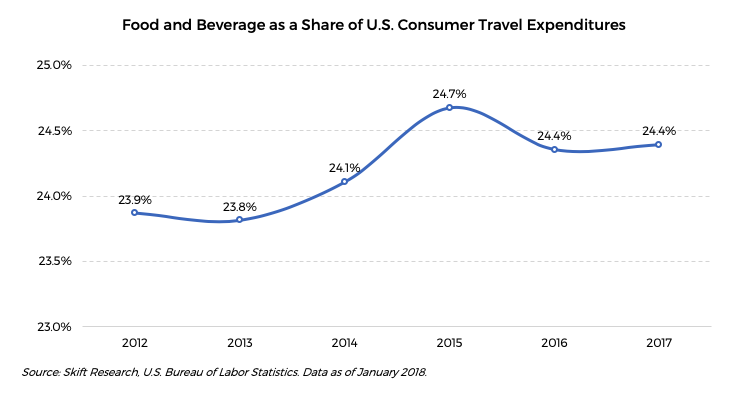
We then turn our attention to a narrower, more local scope of food tourism. While researching for this report, we found that despite the rising popularity and interest in food tourism across many related sectors, there is very little data on a clearly defined food tourism segment. We conducted our own survey for the purpose of providing some necessary context to the trends.
According to our food tourism survey, 96% of respondents have participated in some kind of experience that would fall under this slightly narrower food tourism umbrella (i.e., dining out at restaurants that serve local cuisine is included). This increases slightly to 98% for those respondents who have traveled for leisure in the past 12 months, who we call “recent travelers.” This falls in line with the WFTA’s 2016 Food Travel Monitor finding that 93% of travelers could be considered “food travelers” at some time, based on their participation in food or beverage experiences. This estimation, however, does not include travelers who only dine out in-destination.
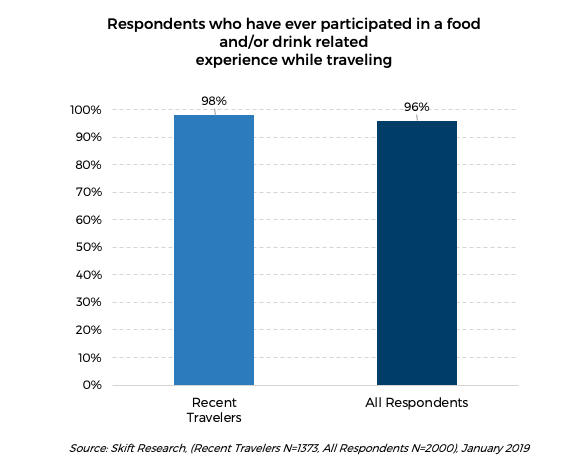
For more nuance, the chart below shows the type of food and/or drink related experiences that our respondents have participated in while traveling, divided again by recent travelers and the average for all respondents. Unsurprisingly, most respondents have dined out at a restaurant that serves local food while traveling, with about 80% of recent travelers reporting this.
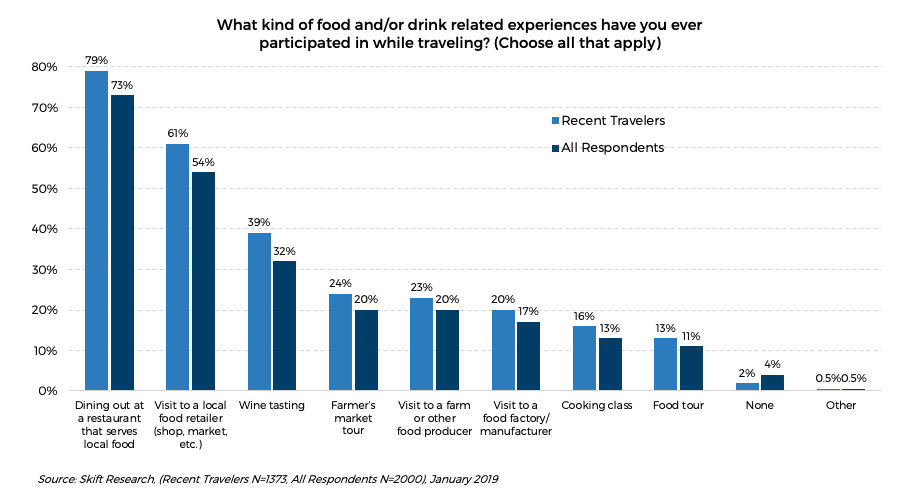
Next, we focus in on the narrowest scope of food tourism. We asked our respondents whether they’ve ever gone on vacation with a food and/or drink related travel experience as the main purpose of the trip. Among all respondents, one-third responded that they have. For respondents who have traveled in the last 12 months, 42% said so. This is a very significant number for relevant stakeholders who work to use food experiences to attract tourists.
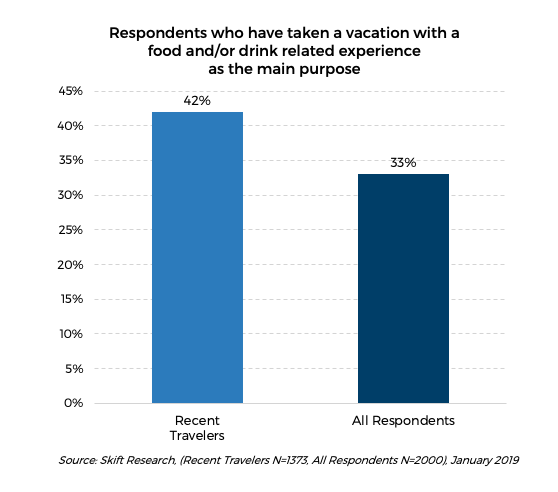
When looking at the specific types of experiences that these travelers planned their trips around, wine tasting claims the first spot, with 52% of respondents saying they’ve gone on trips with that activity as the main purpose. We will discuss more details later in the report.
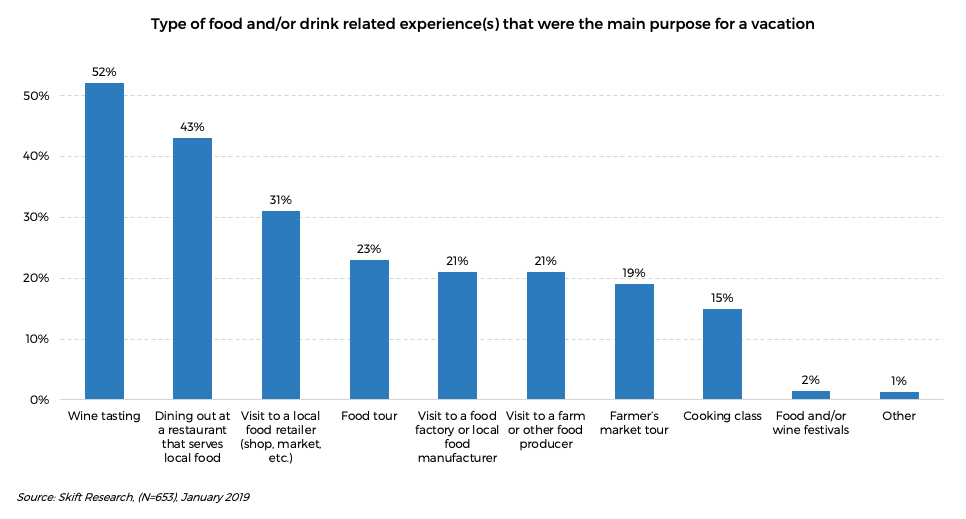
Food Tourism Experiences Grow in Popularity
Food and drink experiences have long been an important part of travel. However, food tourism is reaching new levels of popularity and is manifesting in more exciting ways than ever. Data from TripAdvisor , for example, showed that food tours and cooking classes were among the top-five fastest growing tour categories in 2017, each with 57% bookings’ growth on the platform. Food tours also saw the most growth by gross booking value that year.
Food and drink-related activities also show high levels of popularity on Airbnb’s Experiences platform. According to an Airbnb spokesperson Skift Research spoke with in February 2018 for our report The State of Tours and Activities 2018 , bookings of these types of Experiences accounted for around 29% of the platform’s total bookings at the time.
Not only are bookings of food tourism experiences growing, but there are also signs that traveler satisfaction with them is high. TripAdvisor recently released the winners of its 2018 Travelers’ Choice Awards, which includes awards for experiences listed on its platform. The winners are determined using an algorithm that takes into account a business’s reviews, opinions, and popularity with travelers over the last year. On the list of the Top 25 Experiences in the World , seven of those selected are either entirely food based, or include a unique, local food portion within the experience. The number one spot, in fact, was taken by an entirely food-based experience: a cooking class and lunch at a Tuscan farmhouse which includes a tour of a local market in Florence.
The Rise of Niche, Food- and Beverage-Related Businesses
Outside of food tourism experiences designed purely for travelers, we see growth in other food- and beverage-related businesses. In Skift Research’s 2016 report Food Tourism Strategies to Drive Destination Spending , we called out the “rise of beer, spirits, and coffee tourism.” This trend was largely being driven by the explosive growth of craft breweries at the time. Since then, this growth has slowed, but still remains steady, with small and independent craft brewers maintaining 5% growth in the first half of 2018 in the U.S. according to the Brewers Association , showing that the demand is still there.
Food halls are another niche, local food- and beverage-related business type that is undergoing huge growth currently. Cushman & Wakefield, one of the largest U.S. commercial real estate brokers, has been tracking food hall development in the U.S. since 2015. In that year, it noted 70 projects. By the year’s end in 2017, this number went up to 118 and was expected to reach 180 by the end of 2018. The firm estimates that there will be 300 food halls in the U.S. by the end of 2020.
The growth of craft breweries and food halls may not be entirely due to the rise of food tourism, as many locals also enjoy these venues. However, it is safe to say that the same interests that are driving food tourism are contributing to the growth of these types of businesses. Craft breweries, food halls, and the like also become attractions in and of themselves, thereby also contributing back to the rise in food tourism.
Industry Sentiment About Food Tourism Today
Clearly, food tourism deserves our attention. Stakeholders in the space agree. According to a survey of DMOs, educational institutions, marketing and consultancy firms, accommodation providers, the meetings industry, food and beverage providers, and wineries in the UNWTO’s Second Report on Gastronomy Tourism , the majority of respondents agree that gastronomy is a driving force for tourism development (with an average of 8.19 on a scale of 1 to 10, where 10 is “strongly agree”).
Even so, many respondents to this survey didn’t feel that their marketing efforts in this area were adequate. For example, while 70% of respondents said they have targeted food tourists as a specific market segment, only 10% think that this segment receives enough promotion in the destination. Further, just 46.5% report that they have a food tourism strategy in place, while just under 25% say they allocate budget specifically for attracting food tourists. These survey results emphasize the need for all stakeholders to contribute toward developing and promoting the food tourism in a region. We will discuss this more later in the report.
Who Are Food Tourists Today?
Because food tourism activities vary so much, it’s difficult to say exactly who food tourists are from a demographic perspective, as it varies so much depending on the activity. From our own survey, we found that Millennials and young Gen Xers make up the majority of our U.S.-based respondents who have ever participated in a food tourism experience other than dining out at chain restaurants. The age distribution is the same for food tourists who have traveled in the past 12 months.
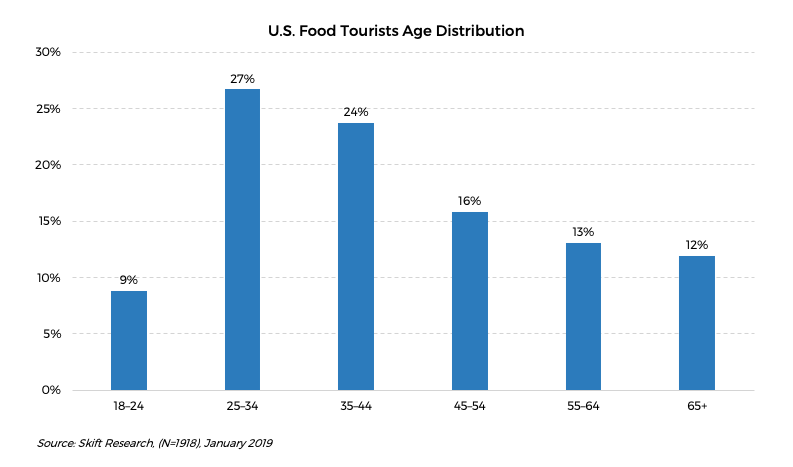
Today’s Food Tourists Are Curious and Crave Unique Experiences
Throughout our interviews with food tourism stakeholders, we heard the theme that food tourists are curious people who desire unique experiences that revolve around food. Camille Rumani is the COO and co-founder of Eatwith, a peer-to-peer app that connects travelers and locals around food experiences in 130 countries. She describes the guests who use Eatwith as “People who, for example … want to get off the beaten path, I would say, do something that is a bit different, but also have the feeling, they don’t want to be a tourist. … they will also value the fact that it’s not the same thing that they’re doing as anyone else.”
Joanne Wolnik, tour development manager for the regional tourism office, Ontario’s Southwest, echoed these sentiments when describing the typical food tourists in her region: “It’s people that are curious, people that have an appetite to learn new things. This is the same whether they’re coming for a tasting experience or their coming to make chocolate truffles, it’s people that want to learn.”
Today’s Food Tourists Aren’t All “Foodies” or “Gourmets”
It is easy to make the mistake of conflating food tourists with foodies, but today, these two groups don’t fully overlap. A study by Fogelson & Co. , a food brand strategy and marketing agency, articulated the larger trend of moving away from using “foodie” to describe people who have a deep connection to food. The study explains that “foodie” used to depict a niche minority, but a deep interest in food is now mainstream. Further, it argues that a “foodie” is often thought of as being a person who is in “some sort of exclusive gourmand group of hyper-passionate food people,” when in fact, this is not the case for many consumers who feel connected to food.
To compensate for this disconnect, Fogelson & Co. recommends a new consumer category: the “food connected consumer.” This group views cooking and eating as fun experiences and as opportunities to explore. In fact, 63% of these surveyed consumers reported that they love to travel.
This distinction between the traditional “foodie” group and the new “food-connected consumer” is important when thinking about building and promoting food tourism. Trevor Jonas Benson, director of food tourism innovation and lead consultant for Grow Food Tourism at the Culinary Tourism Alliance, explained that he has observed the success of destinations that look beyond foodies. “No longer are destinations concentrating on a very small percentage, hyper-niche market of foodies and gastronomic interested people … but they’re starting to understand that any and all experiences can often be enhanced through food and drink.”
Our survey results further illustrate this point. We asked respondents which category of food and/or drink related activity is most appealing to them when traveling. The results show that the often more casual categories of “Markets, festivals, and speciality grocers” was selected the most, followed by the also casual category of “Gastropubs, burgers, and beer,” while “Gourmet, upscale, classic” falls to the fifth position among all respondents.
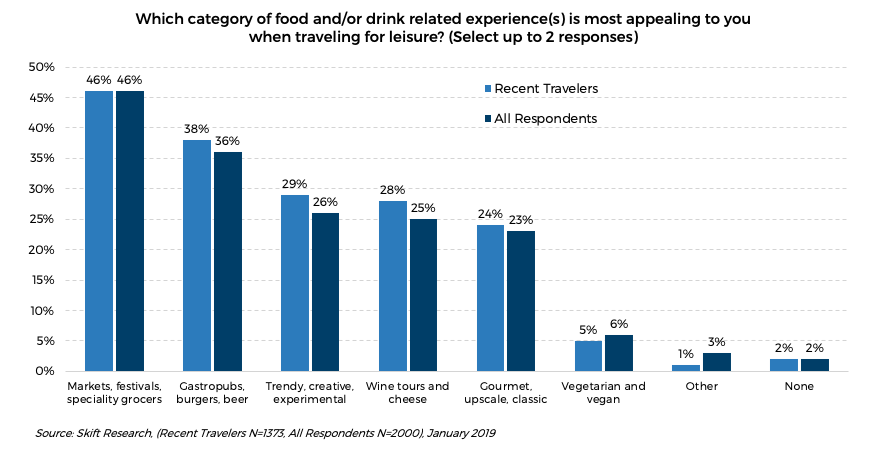
We asked a variation of this question for our 2016 report, Food Tourism Strategies to Drive Destination Spending , and similar trends were observed. However, “Gastropubs, burgers, beer” took the top spot then, and “Gourmet, upscale, classic” ranked one spot higher (please note, however, that respondents were not given “Other” or “None” options in 2016).
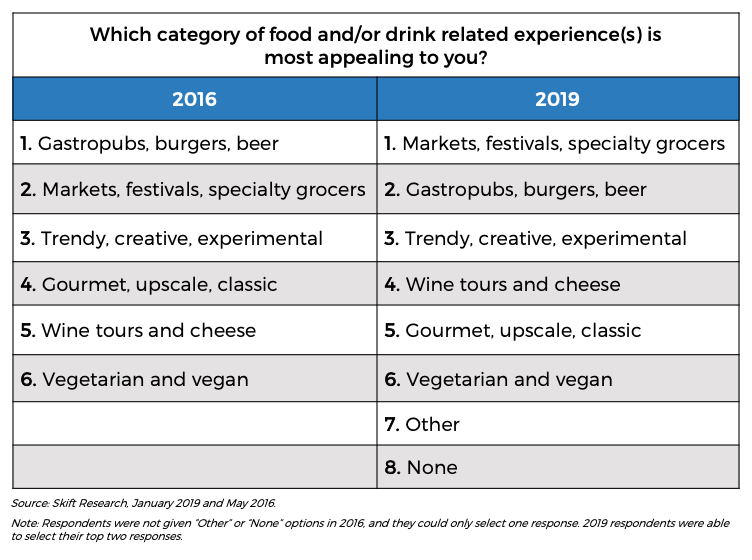
Still, the point remains, that while food tourism can be upscale and gourmet, it doesn’t have to be. In fact, more people prefer more casual types of experiences.
Today’s Food Tourists Can Be Divided into Two Main Groups: Deliberate and Incidental
A common way to segment food tourists is based on whether food and/or drink related experiences are their main motivation for travel or not. These groups are often referred to as “deliberate food tourists” and “incidental food tourists.” Skift Research spoke with Helena and Robert Williams, Ph.D.’s, researchers and academics with expertise in food tourism. They have researched the differences between deliberate and incidental food tourists extensively. Helena explained that deliberate food tourists will plan out their trips for weeks to include as many food experiences as possible, or a few of the most interesting ones: “They’re thinking about the food related experiences, not what restaurant they’ll eat in but can they go to a cooking class, can they go to a plantation, can they go to a winery, will there be some other cultural experiential thing they’ll learn about.”
Incidental food tourists, on the other hand, would still likely fall into the “food connected consumer” group we discussed above, but they are traveling for another reason, such as to visit friends or family, go to a conference, etc. Because they still appreciate food though, they will look for any free time they have to fit in food and/or drink related experiences.
Distinguishing between deliberate and incidental groups is important for food tourism stakeholders looking to develop and promote themselves to “food tourists” because they are likely to be interested in slightly different kinds of experiences and also need to be targeted in different ways and at different times in their journey.
The data below (which we discussed as Exhibit 4 above), for example, shows that the most common food and/or drink related travel experiences are those that have the option to be planned well in advance, but are also commonly done spontaneously (dining out at a restaurant that serves local food and visiting a local food retailer). In other words, these are experiences that are appealing to both deliberate and incidental food tourists. Those that require more pre-planning tend to fall toward the bottom of the list (cooking class, food tour).
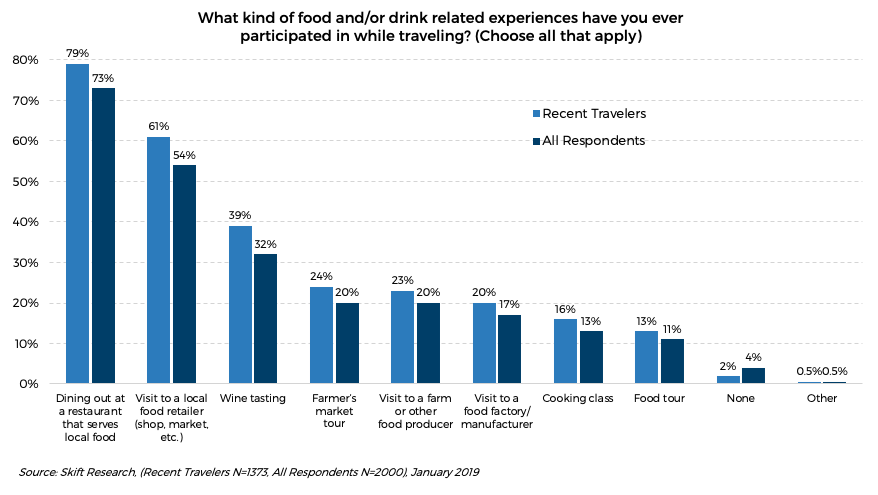
The popularity of these experience types changes when we look at those that were the main purpose of a vacation. Wine tasting moves to the top spot and food tours is the fourth-most common experience type that travelers have planned trips for specifically.
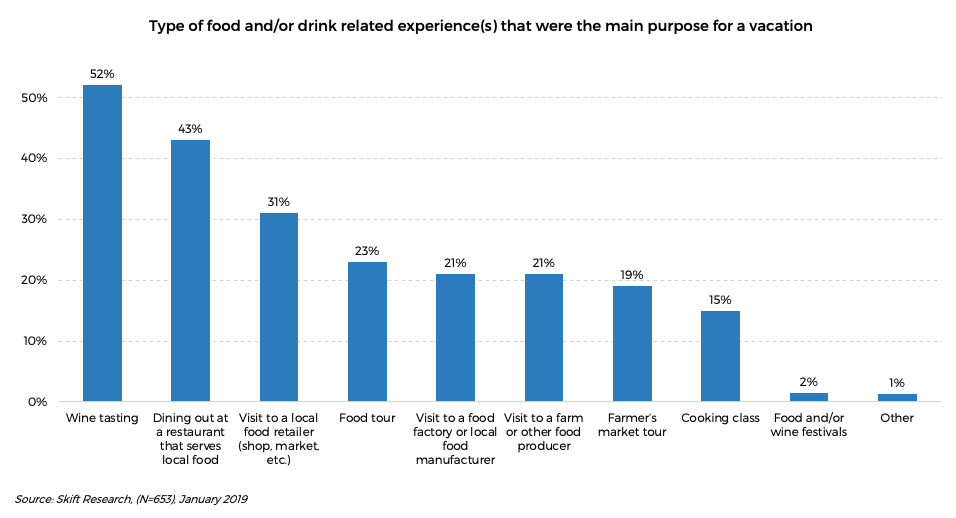
Joanne Wolnik of Ontario’s Southwest described how her organization uses this type of distinction when developing food tourism in the region. She explained that her team not only works to make sure that there are local, exciting options for tourists who are looking to dine out, but also that there are plenty of reasons for deliberate food tourists to make a trip to the region as well. “This is the side that we are really trying to grow. We’ve got awesome people that are here already doing really cool things … so we are building reasons for people to travel for food specifically.”

Today’s Food Tourists Often Plan Their Trips Around Food
Whether they’re incidental or deliberate, food tourists today are more commonly choosing destinations at least in part because of their food offerings, even if this is not the main purpose of a trip. They are also often planning other parts of their trips around food and drink experiences. As Camille Rumani of Eatwith explained, unique food offerings used to be a “nice to have. Now they [destinations] need to have that. People are really looking for it, and they also choose destinations more and more based on the food offerings.” Javier Perez-Palencia, CEO and chair of the board for the international food tourism festival FIBEGA Miami, summed this up by saying “Gastronomy is an attraction.”
Skift Research also spoke with Michael Ellis, Jumeirah Group’s chief culinary officer and former global director at Michelin Restaurant and Hotel Guides. From his experience in both roles, he has observed the emerging trend of travelers basically going on “gastronomic pilgrimages,” where they choose a destination like Copenhagen specifically to eat at Noma, or Madrid to eat at DiverXO. Even for incidental food tourists, it’s common for them to use the food experiences they do incorporate as starting points to plan their other activities. “Everything else will come from there,” he explained, “whether it’s shopping, or cultural, or sporting events, whatever they want to do. That will be organized around where they have their lunch or dinner reservations.”
An area’s food offerings are also an essential component food tourists consider when choosing accommodations. Robert Williams explained that it’s important for hotels to realize that this is becoming more common. “What hotels are beginning to do is instead of trying to be all inclusive, they realize that … some of their customers look for the food experience first … versus the other way where you pick the hotel in the location and then see what you can do while you’re there.”
Interestingly, the total trip expenditure of incidental food tourists might not vary that much from that of deliberate food tourists, despite their varying levels of motivation by food. This was something that Helena and Robert Williams found through their extensive research on the subject, a finding that Helena refers to as “one of the most profound things to come out of my research.” She explained that the spending by these two groups is pretty comparable, and that the spending of incidental food tourists, “if not equal, it’s more than the deliberate traveler because they’re already there for some other reason and their time is more compressed, but they still want these wonderful experiences.” In a 2018 paper they published in the Journal of Gastronomy and Tourism with Jingxue (Jessica) Yuan, two surveys of self-identified food tourists revealed that 60% spent the most money on a deliberate food tourism trip, while 40% reported that it was an incidental trip. This research further emphasizes why both groups of food tourists are important to target and attract.
Defining the New Era of Food Tourism
Now that we have a better picture of who food tourists are today, we will focus on what food tourism is today beyond the general definition we discussed at the beginning of the report. It’s impossible for food tourism to remain static, as cultures, the environment, and consumer demands are in constant flux. Drawing mainly from our interviews with expert stakeholders, we’ve identified five key components that define the new era of food tourism. For each component, we’ve included relevant perspectives from stakeholders and case studies.
Food Tourism Is About More Than the Food Itself
The types of experiences that define the new era of food tourism are about more than just food or beverages. Our interviewees brought this up repeatedly in multiple ways. This is the biggest part of the new definition of food tourism and is multifaceted. Today, the food tourism experiences that best exemplify what food tourists want meet at least one of the following criteria: they overlap with other types of tourism (such as cultural tourism, historical tourism, agritourism, etc.), they have a hands-on learning aspect, and they are social.
- DMO/RTO: Joanne Wolnik, of Ontario’s Southwest explained how her team divides experiences into three categories: culinary, waterfront, and significant events. She explained that “the main two are waterfront and culinary … but we’ve created a lens where [an experience] usually has to overlap with one of the other two. So culinary is quite a high priority.”
- Travel Agency: James Imbriani, founder of the luxury food-themed tour company Sapore Travel, told Skift Research, “Destinations have a lot of things to offer other than just food and wine. Even if we plan something more historical, if we can tie in food, we like to try.”
- Tour Platform/Operator: Camille Rumani of Eatwith explained that she has been seeing more experiences on the platform that are hosted in unique spaces, like art galleries, rooftops, and even an old London underground station. Looking forward, she foresees that people will become even interested in experiences with interest beyond food: “for example, dinner with a concert, or seeing a play at the same time, or integrating food and music. We see that becoming very, very popular.”
- Case Study: Time Out Market Time Out Market was conceived by Time Out Group, best known for its city-specific online and print magazines that cover entertainment, events, and culture in global cities. The first market opened in Lisbon in 2014 and includes a selection of the best food and drink the city has to offer curated by Time Out editors and presented in a food hall type style. A repeated marketing message of the Time Out Market, however, is “this is more than just a food hall.” In addition to food vendors, the space also includes an academy where cooking classes are taught and a large studio space where concerts and other shows, fairs, conferences, and more are specially curated to represent the city as best as possible. “The magazine is all about food, beverage, chefs, art, culture, music, exhibitions, what’s hot in town now. So we’re bringing the magazine to life physically” said Didier Souillat, CEO of Time Out Market. With this strategy, Time Out Market Lisbon has become the number one tourist destination in the Portugal, and attracts locals as well. Beginning this year, new Time Out Markets will begin opening in other cities around the world and will mimic the mix of offerings in Lisbon, but with localized twists.The mix of offerings within a Time Out Market differentiates it, attracts people initially, and keeps them coming back. As a Time Out Market representative explained, “It’s not just dinner on a Thursday night. It’s dinner and a show, dinner and a reading, dinner and a cultural moment.”
- DMO/RTO: Joanne Wolnik of Ontario’s Southwest told us, “The main thing about food tourism that I’m seeing is that people want something new to them, unique, they want to learn, and they want to go home with new skills. I’m hesitant to say the word transformational again, because I know that’s a little bit trendy right now so I’m being careful, but it’s a new way from them to engage in food and with food.”
- Case Study: Ontario’s Southwest Joanne Wolnik shared some examples of food tourism experiences in Ontario’s Southwest region that illustrate this part of our definition perfectly. One experience is called The Sweetest Smell on Earth, which is run by a maple syrup harvester. The experience, which is offered a limited number of times, begins with a trip on a tractor to maple trees, where participants learn how to tap the tree, collect sap, and are taught historical information about the process. They then are taught how to make their own maple candies and they get to keep a bottle of their own syrup. Next, they’re served a meal by a local chef who incorporates maple into each dish.Wolnik explains that the hands-on, educational parts of this experience make it really resonate with participants: “ … they have bragging rights because they have their own bottle of maple syrup that they bottled themselves, they know how to use the product beyond just putting it on pancakes and waffles, and it really empowers them to use the product. So not only are they learning something new, but now when they go home, it’s changing their behaviors and their habits. So there is a transformational piece to it.”
- Tour Platform/Operator: Social interaction is a key component of the peer-to-peer experiences available on Eatwith. Camille Rumani told us that this was one of the main motivators for starting the company. “We saw that because usually you’re a tourist when you’re traveling, it’s such a paradox to travel so easily nowadays in cities where millions of people are living, but you don’t actually meet anyone when you’re traveling to Barcelona and to New York. You’re usually wondering what’s behind the closed doors, and we wanted to facilitate this experience.”
- Benjamin Ozsanay, CEO and co-founder of the cooking class platform Cookly, expressed similar sentiments: “Over time, we realized that our users and partners were looking for a connection. … This human connection was something we think is missing in ‘food tourism’ as it commonly perceived. We think it is much more than just trying the local street food or visiting the hottest new restaurant. It is about making a human connection across cultures … the essence of travel”
- Case Study: TripAdvisor’s 2018 Travelers’ Choice Awards Top Experience in the World As we mentioned earlier in the report, the top experience in the world according TripAdvisor’s 2018 Travelers Choice Awards was a food-based experience called “Cooking Class and Lunch at a Tuscan Farmhouse with Local Market Tour from Florence.” The description of this experience on TripAdvisor gets right to the core of this part of our food tourism definition. It is described as a “hands-on experience,” where travelers can “explore cuisine in more depth than you would by simply eating in restaurants.” Traveler reviews praise the experience as “interactive,” “educational,” and “social.” They lauded that they “met some lovely people” and enjoyed “hearing about the history in addition to tasting the food.”
Food Tourism Emphasizes the Story Behind the Food
This part of the definition is very closely related to the previous point, in that food tourism experiences today shouldn’t be about just tasting food or beverages, but should go deeper. This aspect of food tourism is about cultures and communities authentically telling their stories through food as a way to attract and interact with tourists. As Trevor Jonas Benson of the Culinary Tourism Alliance described, “we’re seeing a return to the use of language such as ‘authenticity,’ which is really indicative of destinations and communities starting to reclaim what it is that makes them special.”
Food is perhaps one of the easiest ways for people to share something that reflects themselves, their city or region, or their culture. In the words of Camille Rumani of Eatwith “food really reflects the DNA and the soul, I would say of a culture, and basically of people.”
The importance of this aspect of food tourism today is obvious just by looking at the ways food tourism companies describe themselves. Among our interviewees, for example, Benjamin Ozsanay of Cookly described the company this way: “We cultivate a community of users with a love of food, who want to learn about different cultures through local recipes and cooking traditions.” James Imbriani of Sapore Travel also emphasized that his company creates “meaningful, cultural exchanges through food and gastronomy,” and that this is what food tourism should be at its essence.
- Case Study: Cookly In addition to incorporating more of the story behind the food into food and drink related experiences, this part of our definition can also be translated through marketing and branding. Cookly, a platform that connects food loving travelers with food professionals for cooking classes serves as a case study of this. The platform recently changed its logo from a chef’s hat to a mortar and pestle. While the company’s founders originally envisioned connecting travelers with cooking schools, CEO & Co-Founder Bejamin Ozsanay explained, “over time, we realized that our users were looking for more of a connection with the food, culture, and local traditions of a place. The mission was not just about taking a cooking class on your trip, but immersing yourself in the local community and sharing knowledge about the world. Our new mortar and pestle logo reflects our brand’s evolution.”
Food Tourism Is Conscious and Thoughtful
Conscious consumption is permeating throughout many industries, and travel and food tourism aren’t immune. In fact, the new era of food tourism is defined by its conscious and thoughtful nature. The best food and drink experiences for travelers today consider environmental sustainability as well as community and economic impact. This is especially important in developing destinations with fragile ecosystems. Sharing culture and interacting with travelers is beneficial to locals, but without care for the environment and a direct economic impact, these things are meaningless.
- Travel Agency: James Imbriani of Sapore Travel explained how conscious consumption has impacted food tourism: “Also we’ve seen the shift in mindset, even when it comes to the food you’re cooking and eating at home, where people care a little bit more about where their food came from, the processes behind them, how they’re made, the care and love producers put into their products, as opposed to just blindly consuming things. We’ve seen that people are more willing to travel to find these things out, and for me that’s exciting.”
- DMO/RTO: Joanne Wolnik and her team at Ontario’s Southwest aim for economic, social, and environmental benefit as a result of food tourism experiences in the region: “We don’t want to devalue what our operators and artisans and all of our partners are bringing to the table, because ultimately, the whole point of tourism should be the benefit that the travelers bring to the local community both economically and socially, and we strive for environmentally as well.”
- Hotel: Michael Ellis of Jumeirah Group is highly aware of the desire food connected travelers have for local products: “People want to, wherever they are, they want to eat like locals, they want to have a local experience. They want to have locally grown products. They want to have ingredients that, if possible, come from not too far away from where they’re being consumed.” The challenge here is that most of Jumeirah’s hotels are in desert environments, like Dubai. “… there’s not a whole lot that’s produced here. Most things are imported,” he explained. Even so, Ellis sees this as a challenge worth overcoming. “But, having said that, we are in the process now of identifying local producers for a wide variety of products including organically grown vegetables and poultry and eggs. … we are really excited about our ability to bring locally, organically produced, sustainably developed products into our restaurants.”
- Ensuring that food and drink travel experiences — whether it’s a food tour, a meal at a hotel, etc. — are conscious and thoughtful about the local environment and communities might present some initial challenges. But, in the end, they can be the deciding factor for food connected travelers, especially those who are millennials and younger. Research by tour operator Intrepid Traveler found that 90% of millennials consider a travel company’s ethical commitments when booking, and Gen Z is already showing signs of being conscious consumers. A study by McKinsey found that 65% of Gen Zers try to learn the origins of anything they buy and 80% won’t buy products from companies that have been involved in scandals. As these groups continue to become a larger share of the travel market, we can anticipate that this part of food tourism will grow in importance.
- Case Study: Feast On by Culinary Tourism Alliance The Feast On certification program was launched by the Culinary Tourism Alliance in 2015. Skift Research discussed the program in our 2016 report . Its growth and success since then warrant us to revisit it as a case study now. The program works mostly with restaurants, and also commodity groups and local producers, to verify that they are buying and celebrating food local to the Ontario area.
- Participants who meet the stated criteria pay a small fee and in return “we celebrate them through many different ways: through communication, through events, etc.” explained Trevor Jonas Benson who helped create the program. This program is one example of how food and beverage businesses can convey to locals and tourists alike that they approach food with their communities in mind. As the program’s website expresses: “Supporting our local economy and Ontario’s farmers is important; especially for the food service industry. It builds our local food identity, it puts dollars back into our communities and it limits our environmental impact.”
- As of September 30, 2018 the program has certified 137 restaurants, up from the 120 cited in our 2016 report. Perhaps the best way to measure the success of the program is by the expenditure of its participants on local Ontario food purchases, which all are required to report. In 2018, this number totaled $25,140,000 up from the approximately $15,000,000 cited in 2016. This is all money that is staying in the local region and going directly into the communities these businesses are a part of.
Food Tourism Can Promote Exploration Outside of Main Areas and Attractions
One way for food tourism experiences to be conscious and thoughtful to the environment and local communities is to encourage exploration outside of main areas and attractions in a destination. This is something that food tourism is already doing and we expect it will become an even more important part of these experiences in the future.
The size of the current and potential food tourism market is a bit of a double-edged sword. Erik Wolf, CEO of the World Food Travel Association explained, “This can be great news to destinations that are willing to plan carefully for success, but it also can add fuel to the overtourism fire in popular food-centric cities like Portland, Oregon and Barcelona, Spain.”
Encouraging tourists to get outside of the main areas of a destination doesn’t only benefit the local community, it’s also something that more and more food tourists are desiring. Benjamin Ozsanay of Cookly attributes this to the “exploding popularity of travel-culture-food shows like No Reservations, Parts Unknown, and Salt Fat Acid Heat [that] has thrust culinary tourism into the mainstream and we have seen increasing numbers of travelers across all markets searching for similar experiences.”
- Travel Agency: Getting tourists outside of main areas and attractions has benefits beyond easing overtourism. These are the types of experiences food travelers want and they can also be a benefit businesswise. At Sapore Travel, James Imbriani and his team like “to focus on destinations that are a little less typical when it comes what you generally think about in culinary tourism. … even focusing on different regions, like Sicily instead of mainland Italy. These are the kind of places we like to feature, and from a business perspective, these are the kind of places where expertise is a bit more valuable as well.”
- Tour Platform/Operator: For Benjamin Ozsanay’s team at Cookly, local partnerships are key to forming relationships in more remote regions so they can get their guests off the beaten path. “Local partnerships are very helpful for us to connect with the smaller local communities that are often left off the tourist map.” One such partnership is with the Tourism Authority of Thailand (TAT). He explained, “By working together with TAT we can discover more small communities and in exchange we are able to help them grow their local economy as well. Anyone can join Cookly, as long as they are able to provide a well planned out class with equipment and a passion to share their food knowledge and culture.”
- Case Study: Benvingutas a Pagés (Welcome to the Farm) Welcome to the Farm is an annual event in the Catalonia region of Spain. During one weekend of the summer, hundreds of farms and other food producers (olive oil producers, wineries, cava makers, honey producers, etc.) throughout the region open to visitors to offer the opportunity to taste and learn about the local food. Restaurants and accommodation providers throughout the region also participate and promote the use of local products.
- An interactive website for the event provides multiple ways for participants to plan their farm visits. A map shows all of the participating producers within districts of Catalonia, producers are divided by category for those looking to explore just one or a couple in depth, and a number of pre-planned routes have been created by the event’s organizers. Each mapped out route is targeted toward different groups (like foodies, cultural tourists, photography/nature lovers, families, etc.) and they take about three days for visitors to get through. This event and the resources available to participants encourage them — and make it easy — to explore beyond Barcelona, where they will then have the opportunity to connect with local communities and learn the stories behind the region’s famous cuisine.
Food Tourism Doesn’t Mean Just One Thing
After everything we’ve discussed already, this part of our food tourism definition is probably not surprising: Food tourism isn’t just one thing. It’s not all about gourmet experiences, just like it doesn’t have to be about eating street food, or going on a designated food tour. Experiences of all kinds can encompass the new definition of food tourism that we’ve laid out, giving the food tourists of today more options than ever before. Even within one destination, an authentic, meaningful experience can take many forms, be it a trip to a local farm or a meal at a restaurant that celebrates local produce. Our interviewees expressed this in their own ways.
- Travel Agency: Just because Sapore Travel focuses on luxury food travel experiences for a higher-end clientele, it doesn’t mean that they limit the activities throughout a trip to the high-end of things. “I think people are more willing to get outside of their comfort zone these days. Even in the luxury market, people are more willing to,” Imbriani explained. Later, he added “In a place like Mexico City, for example, you can have a Michelin-Starred, fine-dining meal at a place like Pujol, or similar, but you can also eat in a market and have just as memorable of an experience.”
- Hotel: Michael Ellis of Jumeirah Group brought up the point that “authentic” and “local” don’t necessarily mean eating at a hole-in-the-wall restaurant in the middle of nowhere. It all depends on the destination, and most have many facets of what makes them unique. “The gourmet, high-end, if you’re in Paris, that’s very much of a local experience. … People go to Paris for that experience. But you know, people don’t necessarily go to Bangkok, or Dubai, or Kuala Lumpur, or Miami for that experience.”He continued to explain how a luxury hotel group like Jumeirah can take advantage of the many kinds of “authenticity” that exist in the destinations where its properties are located: “I think that’s the most important thing is that you can be a luxury hotel group and offer something for everybody, but the important thing is to make sure whatever you’re offering is of the highest quality, whether it’s a street food experience or a gastronomic experience, it’s got to be authentic and it’s got to be at the best quality level.”
Best Practices in Food Tourism
We identified 10 best practices for stakeholders looking to develop, promote, and/or participate in their region’s food tourism scene. In this section, we will briefly discuss each one (in no particular order), providing perspective from stakeholder interviews, case studies, and additional research throughout.
There is no one-size-fits-all approach
Build the infrastructure that’s needed to support food tourism.
Before a region, or any stakeholders within it, can expect food tourists, they can all play a part in ensuring that the area has the infrastructure necessary to support them. In a 2019 article by Helena and Robert Williams and Jingxue (Jessica) Yuan published in the Journal of Hospitality & Tourism Research, a pyramid is used to illustrate the infrastructure that is needed in order for memorable food tourism experiences to be developed and marketed successfully. The foundation of the pyramid is health and safety, which includes things like clean water and proper sanitation practices and systems. Above that is transportation and lodging, meaning safe accommodations near and transport to and from food tourism experiences. Once those two elements are in place, communication should be the focus. This can mean ensuring internet access in order to reach travelers, and also from a strategic standpoint, how they are communicating their offerings.
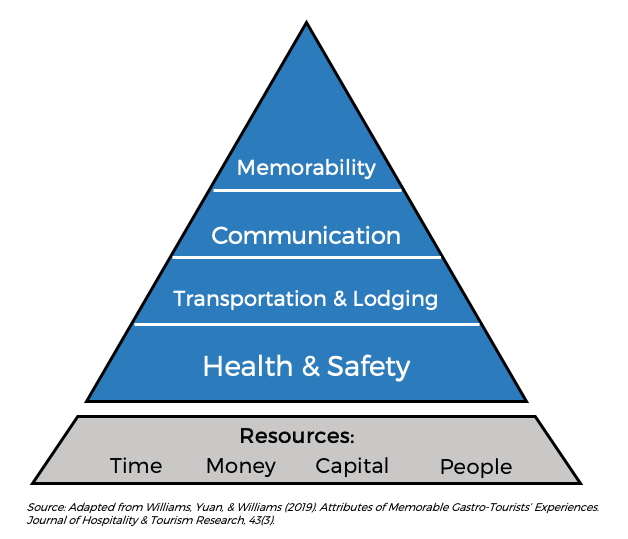
Everyone has a role to play
Developing and promoting food tourism is often regarded as responsibilities of tourism boards. As we have seen throughout this report, however, many kinds of businesses are stakeholders in this space, and therefore should have an active role in it. We will discuss partnerships and collaboration more a bit later, but here we want to focus on one type of stakeholder that is often omitted from the food tourism conversation: hotels.
Through our research and interviews, we have identified two different ways that hotels can get involved in the new era of food tourism: They can bring the community and its cuisine into their properties, or they can facilitate opportunities for their guests to have food tourism experiences in the communities they’re part of.
One way hotels approach the first method is to focus on creating the type of experiences that food tourists desire in the food and beverage offerings at their properties. Michael Ellis of Jumeirah Group thinks that hotels are increasingly becoming food tourism destinations in their own right: “The line between independently owned and run restaurants and restaurants in hotels is more and more blurred. … people want to be able to not just stay in a hotel, but they also want to have great F&B [food and beverage] offerings … You now have restaurants in hotels that are attracting locals and you see this all over the world.”
In addition to focusing their food and beverage offerings in this manner, hotels can also bring unique and local food experiences into their properties in other ways, like offering cooking classes for guests or retail opportunities for local food manufacturers.
Local partnerships are key
For all types of food tourism stakeholders, local partnerships and collaboration are key. Partnerships are key from two different perspectives. Organizations like DMOs, RTOs, and consultancies or associations that focus on developing food tourism have the ability to foster collaboration among local stakeholders that might not otherwise do so themselves. Joanne Wolnik of Ontario’s Southwest explained how her team does this: “Our region is big, geographically, so people three hours away generally don’t know each other, but if they’re doing the same thing or they’re doing similar things, or we know that they could partner to accomplish things together, we always love putting them together and making that introduction.”
Trevor Jonas Benson and his team at the Culinary Tourism Alliance also emphasize the importance of collaborating with the local stakeholders in their client destinations: “The development of the work itself, of the projects, is a collaborative process,” he stressed, “It’s got to be the people who are going to be ultimately benefiting from it and producing those outcomes that have got to be involved in the process from start to finish.”
From another perspective, we have tour operators, booking platforms, and travel agencies that essentially take tourists into many different locations for food tourism experiences. Local partnerships are also essential for these types of companies, even though they may take more work to establish. We already mentioned how Cookly, the cooking class platform, has partnered with the Tourism Authority of Thailand in order to gain access and form further relationships within the country’s more remote regions.
Focus on what makes you and your destination unique
For food tourism operators and businesses, it’s important to focus on what makes the experience unique, as well as what makes the cuisine of the destination unique. When developing food tourism products, Joanne Wolnik recommends considering “how are you making sure that your itinerary is truly an experience and not just a tour, how are you taking it one step further?” She explained, “The idea behind that is that we know that in tourism, your competition is whoever is doing the same thing as you but closer to the traveler’s home. So by being completely different, we open ourselves up to a totally different market.”
Imbriani echoed this when we talked to him about how a food tourism company like Sapore Travel can continue to stand out in the market as it becomes more crowded over time. “I think the biggest thing is offering experiences that are a little bit differentiated from the rest of the market. Less focus on these just kind of generic cooking classes and restaurant reservations, and more focus on meeting with producers, and things like that. The biggest thing is being able to offer a unique product.”
Erik Wolf, CEO of the World Food Travel Association emphasized the importance of focusing on what makes an area’s cuisine unique in order to attract food tourists: “We also see entrepreneurs, and their destination marketing offices implicitly endorsing, giving tourists everything they could possibly want rather than focus on an area’s specialty.” He gave the example of tourists in Barcelona who look for an opportunity to eat paella “which is actually a dish originating in the province of Valencia, three hours south. They leave seemingly satisfied after having found paella, but it may only be a shadow of what an authentic paella experience would be.” When food businesses focus on their destination’s true, unique specialities, it encourages exploration into less commonly visited places, like Valencia rather than Barcelona.
- Case Study: Communicating Unique Cuisine Through Marketing Focusing on what makes a region’s cuisine unique is crucial. Making sure that potential food tourists are aware of this is just as important. One way to do this is through marketing and branding messages. Time Out Market, for example, is opening a location in Brooklyn this spring. Didier Souillat, CEO, explained how one of the main marketing messages that will be used to attract tourists and locals to the location is “New York on a plate.” The idea that this message gets across — that a visitor can literally get a taste of a whole city with one experience — is powerful and attractive.
- Visit Sweden has recently launched a food tourism experience that follows this same idea (plus many others that we have discussed in the report). The experience is called The Edible Country . Created and hosted by four Michelin Star Swedish chefs, the experience takes participants into the wilderness in seven distinct regions of the country where they prepare a nine course meal made from things they catch and forage from nature around them. In addition to incorporating the hands-on, educational, and local aspects that we’ve discussed throughout this report, the way it is marketed and branded communicate Sweden as a destination that can be meaningfully experienced through this food-based activity.
Figure out what “authentic” means for you
As we discussed earlier in the report, food tourism isn’t just one thing, and a big part of this has to do with the many meanings of “authentic” across and within destinations. Because of this, it’s important for food tourism stakeholders to figure out what “authentic” means to them. What part of the region’s cuisine should you focus on? How can you take advantage of locally produced food and drinks? This is something that Time Out Market is approaching smartly in its upcoming Brooklyn location. This location will be the only Time Out Market location of those slated to open in the coming years to feature a Kosher vendor. According to Didier Souillat, “We’re about being local, so you can’t be more local than that.”
Nurture existing food resources to become parts of food tourism
This is one things that stakeholders can do to help develop the food tourism space in their destinations to positively benefit the community. Stakeholders of all kinds can examine what already exists in a region: local restaurants, producers, manufacturers, and even food-passionate individuals who aren’t currently making money this way. They can then come up with ways to nurture these resources to help them have a more active role in the space.
Helena Williams explained how restaurants can do this. By adding a chef’s table, a periodic cooking class, or more specifically, something like “a fish restaurant that will let you go to the dock early in the morning and show you how they select their fish, and then you select the fish and come back later for dinner, and that chef has prepared that fish that you selected.” The restaurant itself may already be a culinary attraction, but “Those are the kinds of things that could easily be added to an existing wonderful experience,” making it more memorable and encouraging travel specifically for the experience itself.
Stakeholders can also help food-passionate individuals enter food tourism, which will benefit them and also their communities. Williams also provided an example of how this could transpire: Maybe there’s a woman in a community who makes the best dumplings, from her kitchen or another unofficial space, but her food wouldn’t necessarily be available to tourists. In a case like this, other stakeholders can help connect her with a network that can help provide support to expand her passion into a business within the food tourism space in her community. Whether it’s the tourism board helping to promote her as a food business or a hotel bringing her to teach cooking classes or sell her dumplings, she can become a part of food tourism with the support of other stakeholders for the benefit of everyone.
Peer-to-peer platforms like Eatwith can also help everyday people who are passionate about their food and cultures play a role in food tourism. Rumani of Eatwith explained that when it comes to the platform’s hosts, “Most of them, I would say 98% of them are amateurs, like me. I do host sometimes as well, and it’s like people who love to cook, are super proud of their culture and story, family story.”
- Case Study: Ontario’s Southwest The maple syrup experience case study from Ontario’s Southwest that we shared earlier in the report is not the only one from the region worthy of discussing. Another example shared with us by Joanne Wolnik is an experience called Tree to Table: A Canadian Conversation. This experience is a great illustration of this best practice category because it shows how even a region’s non-food-specific resources can be nurtured to play a role in food tourism.
- This experience is hosted by a charcuterie board maker in Oxford County in Ontario, which is considered the dairy capital of Canada. Four at a time, participants come to his property, where he shows them how he sustainably sources wood from the indigenous forest for his craft. Participants then design their own board with his artist wife, and then he teaches them how to make their own board in his workshop. Throughout the experience, participants get to try locally foraged teas and some other local recipes made from regional products. Following the boardmaking portion, the group enjoys an outdoor feast that Wolnik describes as being “filled with local jams … local cheeses from different artisan cheesemakers, meat from sustainable meat producers. So everything you’re eating is local. Even the chives and pansies that are in the butter, local breads made from locally milled grains.”
- By hosting this experience, this artisan is able to expand his business and customer base while also sharing his region’s culture and history. Participants get to learn a new skill, understand the region through its food specialities, and bring home a souvenir they made themselves.
Food tourism should be collaborative, not competitive
We have already talked about how important local partnerships are for stakeholders interested playing a role in food tourism. That best practice especially focused on how organizations of different kinds can come together toward the common goal. Now, we turn our attention to how collaboration between stakeholders more generally can make a region a real destination for food tourism. If our focus on every stakeholder having a role to play hasn’t made it clear, food tourism should be collaborative, not competitive, even for similar types of businesses in a region.
Helena and Robert Williams have supported this statement through their research. In an article published in the 2018 Journal of Gastronomy and Tourism authored with Jingxue (Jessica) Yuan, they present results from surveys of food tourists. From the results of the surveys, they present what they call the 6+ Gastro-Cluster Destination Development Model. This model proposes that if at least six food tourism attractions in a two hour radius co-market themselves under a single brand image, it increases the likelihood that food tourists will consider the area worthy of a trip: The study concludes that “to attract serious, overnight, self-identified gastro-tourists, which results in sustainable economic development, 6+ clusters are needed.”
- Case Study: Food tourism trails Food tourism trails (or culinary trails, or beverage trails) are an example of how this “cluster” idea can play out in real life. We talked specifically about beverage trails in our 2016 report, where we mentioned the examples of the Denver Beer Trail, the Austrian Schnapps Trail, the Columbus Coffee Trail, and the Santa Fe Margarita Trail. Trails like this are made up of food or beverage businesses that fall within a specific culinary category all within fairly close proximity to one another.Joanne Wolnik explained that the culinary trails in Ontario’s Southwest show “the critical mass of operators, experiences, and offers that are there for people to do. It’s just a more cohesive message than to go out and say ‘We’ve got 35 wineries’ or ‘We’ve got two distilleries, 20 breweries, and 18 wineries.’ We just try to package it up so it’s more exciting.” She explained how trails in the region, like the Oxford County Cheese Trail , act as attractants for tourists to visit the area and support it in other ways: “They have to be doing more than that [just eating cheese] the entire time they’re there. We know that the Cheese Trail is the reason they came, but while they’re there, they’re also doing A, B, and C, and benefiting the local community in those ways as well.”
Think beyond tourists
Hopefully, the importance of thinking beyond tourists is obvious at this point. Food tourism requires input and collaboration from all kinds of stakeholders, who can all play a part and benefit from it. Even when developing food tourism experiences, the focus shouldn’t only be on tourists. In most destinations, tourism ebbs and flows, so tourists are not always going to be a steady stream of customers for food and drink businesses and experiences. Locals and domestic travelers need to be considered as well.
When Skift Research asked Didier Souillat of Time Out Market whether he and his team focus more on tourists or locals as its target audience, he responded, “It can’t be only one. Tourists won’t go to places where locals are not because they think it’s too touristy for me. The locals won’t go if there’s too many tourists.” Even with the Lisbon Market, where 70% of visitors are tourists, he says most of the advertising is directed at the local community.
Cater to specific niches
Once the infrastructure is in place to support food tourism and food tourism experiences have been developed that follow the guidelines we’ve presented in this report, stakeholders can start thinking about catering to specific niches of food tourists. This could include niches of dietary restrictions/preferences, like vegetarians or vegans, or special interest groups. In November 2018, Skift reported on vegetarian and vegan tours being the “next wave of food tourism,” as the major tour operator Intrepid Travel plans to launch fully vegan tours in Italy, India, and Thailand this year. In destinations like these, vegan cuisine is already common, so creating products with this segment in mind can still maintain regional authenticity while also being a key selling point for these specific groups.
Endnotes and Further Reading
- BeverageDaily.com, “Brewers Association: Microbreweries and taprooms are ‘clearly the growth engine of craft,” May 2018.
- Bisnow, “U.S. Food Hall Market Expected To Triple By 2020,” April 2018.
- Booking.com, “Going Local is the essential ingredient for an unforgettable foodie adventure,” June 2018.
- Business Wire, “Move Over Foodies … Make Room for the Food Connected,” October 2018.
- FoodNavigator-USA.com, “Soup-To-Nuts Podcast: ‘Food connected consumers’ could have broader reach than ‘foodies,’” October 2018.
- New York Times, Eating and Drinking Your Way Through A Trip, and Learning Something in the Process, May 2018.
- Scottish Tourism Alliance, “New plan to increase food and drink tourism,” 2018.
- Skift, “Chefs as Destination Ambassadors Appeal to Travelers’ Foodie Obsessions,” January 2018.
- Skift, “Vegans Find New Options as Part of Next Wave of Food Tourism,” November 2018.
- Skift Table, “The Next Generation of Food Hall Design,” December 2018.
- TripAdvisor, “2018 Travel Trends Report: Experiences, Tours & Activities,” 2018.
- TripAdvisor, “Top 25 Experiences — World,” 2018.
- UNWTO, Second Global Report on Gastronomy Tourism, 2017.
- World Food Travel Association
UN Tourism | Bringing the world closer
- All Regions
UNWTO AM Report Vol. 4 'Global Report on Food Tourism'

For many of the world’s billions of tourists, returning to familiar destinations to enjoy tried and tested recipes or travelling further afield in search of new and special cuisine, gastronomy has become a central part of the tourism experience.
Against this background, food tourism has gained increasing attention over the past years. Tourists are attracted to local produce and many destinations are centring their product development and marketing accordingly. With food so deeply connected to its origin, this focus allows destinations to market themselves as truly unique and appealing to those travellers who look to feel part of their destination through its flavours.
The report analyses the current situation of Food Tourism, through a survey of the UNWTO Affiliate Members as well as the reflections of professionals with extensive experience in international organizations, destination management, tourism companies and the training schools.
The Affiliate Members Programme is grateful to all the UNWTO Member States, Affiliate Members and other organizations who have contributed to this report.
For more information, please contact: [email protected] or tel: +34 915678167
share this content
- Share this article on facebook
- Share this article on twitter
- Share this article on linkedin
Related Content
Am news | vol. 64 may 2024, africa news issue 23, un tourism news 82: sustainable development of tourism, am news | vol. 63 april 2024.
- Search Menu
- Browse content in Arts and Humanities
- Browse content in Archaeology
- Anglo-Saxon and Medieval Archaeology
- Archaeological Methodology and Techniques
- Archaeology by Region
- Archaeology of Religion
- Archaeology of Trade and Exchange
- Biblical Archaeology
- Contemporary and Public Archaeology
- Environmental Archaeology
- Historical Archaeology
- History and Theory of Archaeology
- Industrial Archaeology
- Landscape Archaeology
- Mortuary Archaeology
- Prehistoric Archaeology
- Underwater Archaeology
- Urban Archaeology
- Zooarchaeology
- Browse content in Architecture
- Architectural Structure and Design
- History of Architecture
- Residential and Domestic Buildings
- Theory of Architecture
- Browse content in Art
- Art Subjects and Themes
- History of Art
- Industrial and Commercial Art
- Theory of Art
- Biographical Studies
- Byzantine Studies
- Browse content in Classical Studies
- Classical History
- Classical Philosophy
- Classical Mythology
- Classical Literature
- Classical Reception
- Classical Art and Architecture
- Classical Oratory and Rhetoric
- Greek and Roman Epigraphy
- Greek and Roman Law
- Greek and Roman Archaeology
- Greek and Roman Papyrology
- Late Antiquity
- Religion in the Ancient World
- Digital Humanities
- Browse content in History
- Colonialism and Imperialism
- Diplomatic History
- Environmental History
- Genealogy, Heraldry, Names, and Honours
- Genocide and Ethnic Cleansing
- Historical Geography
- History by Period
- History of Agriculture
- History of Education
- History of Emotions
- History of Gender and Sexuality
- Industrial History
- Intellectual History
- International History
- Labour History
- Legal and Constitutional History
- Local and Family History
- Maritime History
- Military History
- National Liberation and Post-Colonialism
- Oral History
- Political History
- Public History
- Regional and National History
- Revolutions and Rebellions
- Slavery and Abolition of Slavery
- Social and Cultural History
- Theory, Methods, and Historiography
- Urban History
- World History
- Browse content in Language Teaching and Learning
- Language Learning (Specific Skills)
- Language Teaching Theory and Methods
- Browse content in Linguistics
- Applied Linguistics
- Cognitive Linguistics
- Computational Linguistics
- Forensic Linguistics
- Grammar, Syntax and Morphology
- Historical and Diachronic Linguistics
- History of English
- Language Acquisition
- Language Variation
- Language Families
- Language Evolution
- Language Reference
- Lexicography
- Linguistic Theories
- Linguistic Typology
- Linguistic Anthropology
- Phonetics and Phonology
- Psycholinguistics
- Sociolinguistics
- Translation and Interpretation
- Writing Systems
- Browse content in Literature
Bibliography
- Children's Literature Studies
- Literary Studies (Asian)
- Literary Studies (European)
- Literary Studies (Eco-criticism)
- Literary Studies (Modernism)
- Literary Studies (Romanticism)
- Literary Studies (American)
- Literary Studies - World
- Literary Studies (1500 to 1800)
- Literary Studies (19th Century)
- Literary Studies (20th Century onwards)
- Literary Studies (African American Literature)
- Literary Studies (British and Irish)
- Literary Studies (Early and Medieval)
- Literary Studies (Fiction, Novelists, and Prose Writers)
- Literary Studies (Gender Studies)
- Literary Studies (Graphic Novels)
- Literary Studies (History of the Book)
- Literary Studies (Plays and Playwrights)
- Literary Studies (Poetry and Poets)
- Literary Studies (Postcolonial Literature)
- Literary Studies (Queer Studies)
- Literary Studies (Science Fiction)
- Literary Studies (Travel Literature)
- Literary Studies (War Literature)
- Literary Studies (Women's Writing)
- Literary Theory and Cultural Studies
- Mythology and Folklore
- Shakespeare Studies and Criticism
- Browse content in Media Studies
- Browse content in Music
- Applied Music
- Dance and Music
- Ethics in Music
- Ethnomusicology
- Gender and Sexuality in Music
- Medicine and Music
- Music Cultures
- Music and Religion
- Music and Culture
- Music and Media
- Music Education and Pedagogy
- Music Theory and Analysis
- Musical Scores, Lyrics, and Libretti
- Musical Structures, Styles, and Techniques
- Musicology and Music History
- Performance Practice and Studies
- Race and Ethnicity in Music
- Sound Studies
- Browse content in Performing Arts
- Browse content in Philosophy
- Aesthetics and Philosophy of Art
- Epistemology
- Feminist Philosophy
- History of Western Philosophy
- Metaphysics
- Moral Philosophy
- Non-Western Philosophy
- Philosophy of Science
- Philosophy of Action
- Philosophy of Law
- Philosophy of Religion
- Philosophy of Language
- Philosophy of Mind
- Philosophy of Perception
- Philosophy of Mathematics and Logic
- Practical Ethics
- Social and Political Philosophy
- Browse content in Religion
- Biblical Studies
- Christianity
- East Asian Religions
- History of Religion
- Judaism and Jewish Studies
- Qumran Studies
- Religion and Education
- Religion and Health
- Religion and Politics
- Religion and Science
- Religion and Law
- Religion and Art, Literature, and Music
- Religious Studies
- Browse content in Society and Culture
- Cookery, Food, and Drink
- Cultural Studies
- Customs and Traditions
- Ethical Issues and Debates
- Hobbies, Games, Arts and Crafts
- Lifestyle, Home, and Garden
- Natural world, Country Life, and Pets
- Popular Beliefs and Controversial Knowledge
- Sports and Outdoor Recreation
- Technology and Society
- Travel and Holiday
- Visual Culture
- Browse content in Law
- Arbitration
- Browse content in Company and Commercial Law
- Commercial Law
- Company Law
- Browse content in Comparative Law
- Systems of Law
- Competition Law
- Browse content in Constitutional and Administrative Law
- Government Powers
- Judicial Review
- Local Government Law
- Military and Defence Law
- Parliamentary and Legislative Practice
- Construction Law
- Contract Law
- Browse content in Criminal Law
- Criminal Procedure
- Criminal Evidence Law
- Sentencing and Punishment
- Employment and Labour Law
- Environment and Energy Law
- Browse content in Financial Law
- Banking Law
- Insolvency Law
- History of Law
- Human Rights and Immigration
- Intellectual Property Law
- Browse content in International Law
- Private International Law and Conflict of Laws
- Public International Law
- IT and Communications Law
- Jurisprudence and Philosophy of Law
- Law and Politics
- Law and Society
- Browse content in Legal System and Practice
- Courts and Procedure
- Legal Skills and Practice
- Primary Sources of Law
- Regulation of Legal Profession
- Medical and Healthcare Law
- Browse content in Policing
- Criminal Investigation and Detection
- Police and Security Services
- Police Procedure and Law
- Police Regional Planning
- Browse content in Property Law
- Personal Property Law
- Study and Revision
- Terrorism and National Security Law
- Browse content in Trusts Law
- Wills and Probate or Succession
- Browse content in Medicine and Health
- Browse content in Allied Health Professions
- Arts Therapies
- Clinical Science
- Dietetics and Nutrition
- Occupational Therapy
- Operating Department Practice
- Physiotherapy
- Radiography
- Speech and Language Therapy
- Browse content in Anaesthetics
- General Anaesthesia
- Neuroanaesthesia
- Browse content in Clinical Medicine
- Acute Medicine
- Cardiovascular Medicine
- Clinical Genetics
- Clinical Pharmacology and Therapeutics
- Dermatology
- Endocrinology and Diabetes
- Gastroenterology
- Genito-urinary Medicine
- Geriatric Medicine
- Infectious Diseases
- Medical Oncology
- Medical Toxicology
- Pain Medicine
- Palliative Medicine
- Rehabilitation Medicine
- Respiratory Medicine and Pulmonology
- Rheumatology
- Sleep Medicine
- Sports and Exercise Medicine
- Clinical Neuroscience
- Community Medical Services
- Critical Care
- Emergency Medicine
- Forensic Medicine
- Haematology
- History of Medicine
- Browse content in Medical Dentistry
- Oral and Maxillofacial Surgery
- Paediatric Dentistry
- Restorative Dentistry and Orthodontics
- Surgical Dentistry
- Medical Ethics
- Browse content in Medical Skills
- Clinical Skills
- Communication Skills
- Nursing Skills
- Surgical Skills
- Medical Statistics and Methodology
- Browse content in Neurology
- Clinical Neurophysiology
- Neuropathology
- Nursing Studies
- Browse content in Obstetrics and Gynaecology
- Gynaecology
- Occupational Medicine
- Ophthalmology
- Otolaryngology (ENT)
- Browse content in Paediatrics
- Neonatology
- Browse content in Pathology
- Chemical Pathology
- Clinical Cytogenetics and Molecular Genetics
- Histopathology
- Medical Microbiology and Virology
- Patient Education and Information
- Browse content in Pharmacology
- Psychopharmacology
- Browse content in Popular Health
- Caring for Others
- Complementary and Alternative Medicine
- Self-help and Personal Development
- Browse content in Preclinical Medicine
- Cell Biology
- Molecular Biology and Genetics
- Reproduction, Growth and Development
- Primary Care
- Professional Development in Medicine
- Browse content in Psychiatry
- Addiction Medicine
- Child and Adolescent Psychiatry
- Forensic Psychiatry
- Learning Disabilities
- Old Age Psychiatry
- Psychotherapy
- Browse content in Public Health and Epidemiology
- Epidemiology
- Public Health
- Browse content in Radiology
- Clinical Radiology
- Interventional Radiology
- Nuclear Medicine
- Radiation Oncology
- Reproductive Medicine
- Browse content in Surgery
- Cardiothoracic Surgery
- Gastro-intestinal and Colorectal Surgery
- General Surgery
- Neurosurgery
- Paediatric Surgery
- Peri-operative Care
- Plastic and Reconstructive Surgery
- Surgical Oncology
- Transplant Surgery
- Trauma and Orthopaedic Surgery
- Vascular Surgery
- Browse content in Science and Mathematics
- Browse content in Biological Sciences
- Aquatic Biology
- Biochemistry
- Bioinformatics and Computational Biology
- Developmental Biology
- Ecology and Conservation
- Evolutionary Biology
- Genetics and Genomics
- Microbiology
- Molecular and Cell Biology
- Natural History
- Plant Sciences and Forestry
- Research Methods in Life Sciences
- Structural Biology
- Systems Biology
- Zoology and Animal Sciences
- Browse content in Chemistry
- Analytical Chemistry
- Computational Chemistry
- Crystallography
- Environmental Chemistry
- Industrial Chemistry
- Inorganic Chemistry
- Materials Chemistry
- Medicinal Chemistry
- Mineralogy and Gems
- Organic Chemistry
- Physical Chemistry
- Polymer Chemistry
- Study and Communication Skills in Chemistry
- Theoretical Chemistry
- Browse content in Computer Science
- Artificial Intelligence
- Computer Architecture and Logic Design
- Game Studies
- Human-Computer Interaction
- Mathematical Theory of Computation
- Programming Languages
- Software Engineering
- Systems Analysis and Design
- Virtual Reality
- Browse content in Computing
- Business Applications
- Computer Security
- Computer Games
- Computer Networking and Communications
- Digital Lifestyle
- Graphical and Digital Media Applications
- Operating Systems
- Browse content in Earth Sciences and Geography
- Atmospheric Sciences
- Environmental Geography
- Geology and the Lithosphere
- Maps and Map-making
- Meteorology and Climatology
- Oceanography and Hydrology
- Palaeontology
- Physical Geography and Topography
- Regional Geography
- Soil Science
- Urban Geography
- Browse content in Engineering and Technology
- Agriculture and Farming
- Biological Engineering
- Civil Engineering, Surveying, and Building
- Electronics and Communications Engineering
- Energy Technology
- Engineering (General)
- Environmental Science, Engineering, and Technology
- History of Engineering and Technology
- Mechanical Engineering and Materials
- Technology of Industrial Chemistry
- Transport Technology and Trades
- Browse content in Environmental Science
- Applied Ecology (Environmental Science)
- Conservation of the Environment (Environmental Science)
- Environmental Sustainability
- Environmentalist Thought and Ideology (Environmental Science)
- Management of Land and Natural Resources (Environmental Science)
- Natural Disasters (Environmental Science)
- Nuclear Issues (Environmental Science)
- Pollution and Threats to the Environment (Environmental Science)
- Social Impact of Environmental Issues (Environmental Science)
- History of Science and Technology
- Browse content in Materials Science
- Ceramics and Glasses
- Composite Materials
- Metals, Alloying, and Corrosion
- Nanotechnology
- Browse content in Mathematics
- Applied Mathematics
- Biomathematics and Statistics
- History of Mathematics
- Mathematical Education
- Mathematical Finance
- Mathematical Analysis
- Numerical and Computational Mathematics
- Probability and Statistics
- Pure Mathematics
- Browse content in Neuroscience
- Cognition and Behavioural Neuroscience
- Development of the Nervous System
- Disorders of the Nervous System
- History of Neuroscience
- Invertebrate Neurobiology
- Molecular and Cellular Systems
- Neuroendocrinology and Autonomic Nervous System
- Neuroscientific Techniques
- Sensory and Motor Systems
- Browse content in Physics
- Astronomy and Astrophysics
- Atomic, Molecular, and Optical Physics
- Biological and Medical Physics
- Classical Mechanics
- Computational Physics
- Condensed Matter Physics
- Electromagnetism, Optics, and Acoustics
- History of Physics
- Mathematical and Statistical Physics
- Measurement Science
- Nuclear Physics
- Particles and Fields
- Plasma Physics
- Quantum Physics
- Relativity and Gravitation
- Semiconductor and Mesoscopic Physics
- Browse content in Psychology
- Affective Sciences
- Clinical Psychology
- Cognitive Neuroscience
- Cognitive Psychology
- Criminal and Forensic Psychology
- Developmental Psychology
- Educational Psychology
- Evolutionary Psychology
- Health Psychology
- History and Systems in Psychology
- Music Psychology
- Neuropsychology
- Organizational Psychology
- Psychological Assessment and Testing
- Psychology of Human-Technology Interaction
- Psychology Professional Development and Training
- Research Methods in Psychology
- Social Psychology
- Browse content in Social Sciences
- Browse content in Anthropology
- Anthropology of Religion
- Human Evolution
- Medical Anthropology
- Physical Anthropology
- Regional Anthropology
- Social and Cultural Anthropology
- Theory and Practice of Anthropology
- Browse content in Business and Management
- Business Strategy
- Business History
- Business Ethics
- Business and Government
- Business and Technology
- Business and the Environment
- Comparative Management
- Corporate Governance
- Corporate Social Responsibility
- Entrepreneurship
- Health Management
- Human Resource Management
- Industrial and Employment Relations
- Industry Studies
- Information and Communication Technologies
- International Business
- Knowledge Management
- Management and Management Techniques
- Operations Management
- Organizational Theory and Behaviour
- Pensions and Pension Management
- Public and Nonprofit Management
- Strategic Management
- Supply Chain Management
- Browse content in Criminology and Criminal Justice
- Criminal Justice
- Criminology
- Forms of Crime
- International and Comparative Criminology
- Youth Violence and Juvenile Justice
- Development Studies
- Browse content in Economics
- Agricultural, Environmental, and Natural Resource Economics
- Asian Economics
- Behavioural Finance
- Behavioural Economics and Neuroeconomics
- Econometrics and Mathematical Economics
- Economic Systems
- Economic Methodology
- Economic History
- Economic Development and Growth
- Financial Markets
- Financial Institutions and Services
- General Economics and Teaching
- Health, Education, and Welfare
- History of Economic Thought
- International Economics
- Labour and Demographic Economics
- Law and Economics
- Macroeconomics and Monetary Economics
- Microeconomics
- Public Economics
- Urban, Rural, and Regional Economics
- Welfare Economics
- Browse content in Education
- Adult Education and Continuous Learning
- Care and Counselling of Students
- Early Childhood and Elementary Education
- Educational Equipment and Technology
- Educational Strategies and Policy
- Higher and Further Education
- Organization and Management of Education
- Philosophy and Theory of Education
- Schools Studies
- Secondary Education
- Teaching of a Specific Subject
- Teaching of Specific Groups and Special Educational Needs
- Teaching Skills and Techniques
- Browse content in Environment
- Applied Ecology (Social Science)
- Climate Change
- Conservation of the Environment (Social Science)
- Environmentalist Thought and Ideology (Social Science)
- Natural Disasters (Environment)
- Social Impact of Environmental Issues (Social Science)
- Browse content in Human Geography
- Cultural Geography
- Economic Geography
- Political Geography
- Browse content in Interdisciplinary Studies
- Communication Studies
- Museums, Libraries, and Information Sciences
- Browse content in Politics
- African Politics
- Asian Politics
- Chinese Politics
- Comparative Politics
- Conflict Politics
- Elections and Electoral Studies
- Environmental Politics
- European Union
- Foreign Policy
- Gender and Politics
- Human Rights and Politics
- Indian Politics
- International Relations
- International Organization (Politics)
- International Political Economy
- Irish Politics
- Latin American Politics
- Middle Eastern Politics
- Political Methodology
- Political Communication
- Political Philosophy
- Political Sociology
- Political Theory
- Political Behaviour
- Political Economy
- Political Institutions
- Politics and Law
- Public Administration
- Public Policy
- Quantitative Political Methodology
- Regional Political Studies
- Russian Politics
- Security Studies
- State and Local Government
- UK Politics
- US Politics
- Browse content in Regional and Area Studies
- African Studies
- Asian Studies
- East Asian Studies
- Japanese Studies
- Latin American Studies
- Middle Eastern Studies
- Native American Studies
- Scottish Studies
- Browse content in Research and Information
- Research Methods
- Browse content in Social Work
- Addictions and Substance Misuse
- Adoption and Fostering
- Care of the Elderly
- Child and Adolescent Social Work
- Couple and Family Social Work
- Developmental and Physical Disabilities Social Work
- Direct Practice and Clinical Social Work
- Emergency Services
- Human Behaviour and the Social Environment
- International and Global Issues in Social Work
- Mental and Behavioural Health
- Social Justice and Human Rights
- Social Policy and Advocacy
- Social Work and Crime and Justice
- Social Work Macro Practice
- Social Work Practice Settings
- Social Work Research and Evidence-based Practice
- Welfare and Benefit Systems
- Browse content in Sociology
- Childhood Studies
- Community Development
- Comparative and Historical Sociology
- Economic Sociology
- Gender and Sexuality
- Gerontology and Ageing
- Health, Illness, and Medicine
- Marriage and the Family
- Migration Studies
- Occupations, Professions, and Work
- Organizations
- Population and Demography
- Race and Ethnicity
- Social Theory
- Social Movements and Social Change
- Social Research and Statistics
- Social Stratification, Inequality, and Mobility
- Sociology of Religion
- Sociology of Education
- Sport and Leisure
- Urban and Rural Studies
- Browse content in Warfare and Defence
- Defence Strategy, Planning, and Research
- Land Forces and Warfare
- Military Administration
- Military Life and Institutions
- Naval Forces and Warfare
- Other Warfare and Defence Issues
- Peace Studies and Conflict Resolution
- Weapons and Equipment

- < Previous chapter
- Next chapter >
22 Culinary Tourism
Lucy M. Long (Ph.D., Folklore, University of Pennsylvania) runs a nonprofit Center for Food and Culture and teaches food studies at Bowling Green State University in the tourism and American culture studies programs. She is the author of Culinary Tourism: Eating and Otherness (2003) and Regional American Food Culture (2009) and has published on a wide range of topics connected to food, ranging from Appalachian food and music to Irish soda bread to Korean restaurants.
- Published: 21 November 2012
- Cite Icon Cite
- Permissions Icon Permissions
A product of both world history and contemporary mass culture, culinary tourism is a scholarly field of study that is emerging as an important part of the tourism industry. Also known as gastronomic tourism, tasting tourism, and simply food tourism, culinary tourism refers to adventurous eating, eating out of curiosity, exploring other cultures through food, intentionally participating in the foodways of an Other, and the development of food as a tourist destination and attraction. In culinary tourism, the primary motivation for travel is to experience a specific food. Culinary tourism parallels the globalization of food production and consumption and reflects issues inherent in tourism. It has the potential to address some of the controversial issues in tourism in general, such as questions of authenticity, commodification of tradition, identity construction, intellectual property and intangible heritage, as well as the ecological, economic, and cultural sustainability of food cultures in response to tourism.
Culinary tourism is both a scholarly field of study and a growing trend within the tourism industry. It is defined as adventurous eating, eating out of curiosity, exploring other cultures through food, intentionally participating in the foodways of an “other,” and developing food as tourist destination and attraction. 1 Also referred to as gastronomic tourism, tasting tourism, and simply food tourism, it is seen as tourism in which experiencing a specific food is the primary motivation for travel. 2
This essay offers an overview of these perspectives, using a folkloristic framework for understanding tourist behaviors as a way a balancing the exotic and the familiar. A product of both world history and contemporary mass culture, culinary tourism reflects the globalization of food production and consumption as well as issues surrounding tourism in general. Questions of authenticity, commodification of tradition, identity construction, intellectual property, and intangible heritage, and the ecological, economic, and cultural sustainability of food cultures in response to tourism are hotly debated. In some minds, culinary tourism offers solutions to some of these issues by suggesting a framework for exploring other people’s connections to food, as well as offering strategies to insure cultural, economic, and ecological sustainability. 3
Origins of Culinary Tourism: Eating out of Curiosity
People have always eaten food out of curiosity, both for sustenance and to explore new tastes. Food scholar Fabio Parasecoli quotes sociologist Claude Fischler and psychologist Paul Rozin in describing two conflicting impulses that have propelled the development of new foods and new cuisines: neophilia , “the curiosity to try new food, based in humans’ omnivorous nature,” and neophobia , “the concurrent fear of being poisoned.” 4 Such curiosity has been a driving force in the history of food, introducing new ingredients, recipes, preparation methods, and cooking styles. Culinary tourism suggests the process by which novelty is incorporated into a food culture by the movement from exotic to edible to familiar and finally to palatable. New foods are perceived as strange and different (exotic) and possibly not edible. Once they are perceived as an item that can be eaten (familiar), then evaluations of its tastiness can be made. Chinese food in the United States, for example, was initially seen as too exotic to be considered food when first experienced by California gold rush miners in the mid-1800s. Once Americans got used to the idea of eating it, it became a part of their familiar “culinary universe,” and taste preferences might then determine their choice of consuming it, rather than fear that it was too unknown. Similarly, restaurant owners might then add something exotic in order to stir curiosity again. This may explain the common pattern seen in the United States in which Cantonese-style Chinese restaurants are first accepted, then are followed in some areas by restaurants offering various regional styles of Chinese food. Donna Gabaccia makes cross-ethnic dining central to her interpretation of American food in We Are What We Eat (1998). 5
World historian Felipe Fernández-Armesto suggests a similarly long view of culinary tourism in his book Near a Thousand Tables: A History of Food (2002). He identifies eight “revolutions,” or paradigmatic shifts in the ways humans use and think about food, including the rise of agriculture and herding, the development of cooking and manners, and long-distance trade and industrialization. These transitions are not successive chronological periods, but tend to overlap, survive in pockets of populations, and leave behind vestiges of each stage. His history suggests that “eating out of curiosity/exploratory eating” has always occurred but in different manners and with different meanings. In the eighth and final phase, the postindustrial, Fernández-Armesto helps to explain the emergence of culinary tourism as an intentional exploration of the “other” for the purpose of pleasure and satisfying curiosity. This phase is characterized by “the internationalization of the palate and the rise of fusion cookery reflect[ing] multiculturalism.” 6
The industrial world offered new mobility to people to cross cultural boundaries—both voluntarily for pleasure, education, or commerce and involuntarily for safety, health, lifestyle, or occupational opportunities. This has literally brought together individuals from different backgrounds to living in close proximity and sharing their everyday lives, including their foodways. We smell our neighbors’ dinner cooking; we see new vegetables in the supermarkets; we visit restaurants serving cuisines completely foreign to us—these all make us curious about things we might not have known even existed before. Geographer David Harvey characterizes the state of the modern world, particularly since the 1950s, as one of “space-time compression.” 7 Food cultures are also compressed in the sense that many of us (particularly in the United States) now have access to ingredients, dishes, cooking styles, and food philosophies from across the world. Although literature and travel writing might have piqued our curiosity before, we can now actually satisfy that curiosity and experience these new foods. This intentional mixing of ingredients and styles has created numerous fusion dishes and even cuisines. Simultaneously, hybrid dishes have emerged from expediency (cost, availability, ease of preparation) that then may become the focus of curiosity. Reactions against industrialization could also encourage culinary experimentation, particularly with foods that were seen as more authentic and natural. The countercultural revolutions of the 1960s and 1970s saw an openness to new cultures and new experiences as well as a celebration of diversity and nonconformity, all of which helped open up peoples’ palates to new tastes. 8
Eating out of curiosity now occurs in a wide variety of forms—commercial and public as well as informal and private. They also include educational explorations into other cultures and places as well as pleasurable excursions into new tastes. Contemporary global culture encourages adventurous eating, and numerous new products featuring “exotic” foods are being marketing in grocery stores and restaurants.
Cookbooks and other culinary literature could perhaps be seen as the first virtual media for culinary tourism, offering readers a window into other people’s food. Although these were originally meant to function as primers for cooking skills and housewifery, they also offered vicarious eating, enabling readers to imagine new tastes. Many cookbooks today include portraits of the culture surrounding the recipes, giving histories, biographies, maps, and luscious photographs that whet the appetite. Cookbooks featuring regional food traditions are particularly popular throughout the United States and Europe. Even though many of these present gourmet updates of traditional recipes or innovative recipes using local ingredients, they also reflect a shift toward looking inward to explore the complexities within a nation, as well as a concern with place as significant to human experience. Food writing moved in the early 1990s from reviewing restaurants to exploring the pleasures of new foods and new cuisines, as well as accounts of travels for and with food. Today, food periodicals frequently feature exotic (or at least, new) foods and ingredients, along with new ways of cooking and serving food. For example, the cover of the January 2007 issue of Food and Wine heralds “100 tastes you must try in 2007.” Even non–food-centered periodicals often include foods or eating experiences based on culinary curiosity. During the 2008 Beijing Olympics, a major fashion magazine included an article in which the author describes how “after a few wrong turns, [he] finds his way to some of China’s most delicious, authentic, and innovative cuisine—and the perfect roast duck.” 9
New media have also been primary venues for satisfying one’s curiosity about food. Televised cooking shows, like cookery books, opened new culinary worlds for thousands of people who would never be able to travel to experience those foods. Julia Child, though not the first television chef, broke new ground in 1963 with the premier of her program, The French Chef , in which she showed American housewives how to “tame” gourmet French cooking. Cooking shows, though popular, tended to remain the domain of day-time programming for stay-at-home adults (wives, particularly) until the Food Network was established in 1993. This brought new foods and cuisines into the home and helped transform the perception of cooking from a domestic chore into a culinary art. By 2004, cooking shows were wildly popular among all ages and genders, and the Food Network created shows dedicated to exploring new and exotic foods. One of the most popular culinary adventure shows was Anthony Bourdain’s A Cook’s Tour , which aired in 2001 and 2002, and visited locales ranging from Tokyo and Southeast Asia, to Portugal and the Basque region of Spain, Mexico, Kansas City, Brazil, and Australia.
Films, like television, have always included food and eating as part of the setting for action and as metaphors for characters’ emotions and relationships. My Dinner with Andre (1981), for example, consisted entirely of two characters talking over a meal. Films that focused on food preparation and consumption, though, tended to be rare, and even in the 2010, there are a limited number that actually center action and character development around food. Babette’s Feast , (1987), about a woman who cooks for a Danish community of ascetics, has inspired adventuresome home cooks to recreate her nineteenth-century Parisian banquet. Another film that uses eating our of curiosity as a theme is Sideways (2004), an American comedy in which two middle-aged men travel through California’s wine country, exploring possibilities in their own lives as they explore wine and fine dining. Numerous other films have stirred audiences’ curiosity about food and cooking, most notably, Big Night (1996), Eat, Drink, Man, Woman (1994), and the award winning, Julie and Julia (2009).
Also riding this wave is an emerging genre of literature made up of memoirs and fiction based on exploring food. Memoirs, in particular, have become popular and usually use food as a tangible way to organize and make sense of memories. Often set as an exploration of food in a new place, this exploration is a metaphor for discovery of the self. Some of the most influential ones include, M. F. K. Fisher’s The Gastronomical Me (1989), Peter Mayle’s A Year in Provence (1991), and Ruth Reichl’s Tender at the Bone: Growing Up at the Table (1998) and Comfort Me with Apples: More Adventures at the Table (2001). Of particular relevance to culinary tourism is Jeffrey Steingarten’s The Man Who Ate Everything (1997), in which the author, food critic for Vogue magazine, sets out to taste and learn about foods that he disliked. Even though he does not acquire a liking for them, he eats them out of curiosity, a sense of adventure, and an exploration of his own culinary universe. More recently, Barbara Kingsolver’s Animal, Vegetable, Miracle (2007) explores a year of living off of locally produced food in the Virginia mountains, tapping into more recent concerns about connecting one’s food to environmental and community sustainability. A similar thread in many of these memoirs is a search for identity, family, and community through food. An excellent example is food scholar and writer Laura Schenone’s The Lost Ravioli Recipes of Hoboken: A Search for Food and Family (2008), in which a desire to learn to make ravioli like her grandmother did takes the author on a culinary tour through Italy—and a discovery of herself.
Restaurants, cooking classes, and folklife festivals also cater to the search for new culinary pleasures. Eating out in the United States has become much more common today, not just for special occasions but also for nourishment, and is a major source of entertainment. As palates become more cosmopolitan, restaurants offer more and more tastes, oftentimes adding dishes from a variety of culinary cultures to the menus. A brochure for an exclusive restaurant in the Washington, D.C. area, for example, boldly claims: “Tour the world’s finest cuisines, presented with flair and accompanied by premium spirits and wines.” As our tastes have broadened, cooking classes and “tasting” events have become popular. Classes in the United States may still focus on culinary skills drawn from French cooking, but many now focus on learning techniques and styles from cultures across the globe. These often teach iconic dishes (Chinese stir fry, Japanese sushi, Thai noodles) that have become popular through the restaurant scene so that they can be reproduced at home. Since food is a window into culture, eating out of curiosity can also be a way of exploring the culture surrounding a food. Educators, museums, and other cultural institutions and culture scholars have long used food to introduce belief systems, aesthetics, lifestyles, and traditions of other cultures. For example, the Smithsonian Institution’s annual Folklife Festival includes foodways as an integral part of every cultural group presented at the festival. Many people come because they are curious about particular foods, and leave with an understanding that food is a much more complex—and richer—topic than they realized.
Food in the Tourism Industry
The tourism industry was slow to recognize the potential of food as an attraction and destination, treating it instead as one part of “hospitality services.” This is understandable, however, if we define tourism as travel for pleasure, and realize that the hardships and dangers early travelers had to endure rarely made it a pleasurable experience. A number of cultures have traditions of people traveling to places specifically to eat the food produced there. Northern Spain, for example, is famous for the varieties of beans associated with each village, and knowledgeable eaters travel to restaurants in those regions serving specialty dishes made from those beans. Consumers insist that the beans taste differently if transported elsewhere, and that a full appreciation of them requires consuming them in situ, in the place they are grown. Wine, similarly, has attracted consumers who want to sample the wine in its place of origin and production. Such travels can perhaps more accurately be called food pilgrimages since they include an element of seeking the authentic as an almost sacred quest for knowledge and personal transformation. 10
The countries most associated with both domestic and international culinary tourism are France, Italy, and Spain. All have highly developed cuisines, as well as native populations that are knowledgeable and willing to travel within their own countries for food experiences. They also boast historical and contemporary cultures of wine consumption, often tied to strong family traditions of vineyards and vintners. Today, Australia, New Zealand, China, Thailand, and Singapore have become major food destinations. Canada and the United States are also vying for their share of the tourism market. In most cases, wine tourism is leading the way in the tourism industry bringing in tourists usually willing and able to pay for higher-priced hospitality services. This has encouraged the development of fine-dining, gourmet food establishments, and, in some instances, is forming the basis for the emergence of new cuisines—for example, the Niagara region of Canada, Southern Appalachia in the United States, and the New Global Cuisine based in Hong Kong. 11
Individual businesses within the tourism industry are developing products in response to recognizing this interest. Wineries and restaurants, for example, began promoting themselves as tourist destinations, often adding overnight accommodations for guests. In the early 2000s, travel companies began including food as a focus, offering tours to famous restaurants or to eating experiences in regions well known for their food, and in the 2000s, businesses emerged that focused on culinary tours. With names such as Culinary Adventures, The Globetrotting Gourmet, Crete’s Culinary Sanctuaries, and A Cook’s Tour, these companies are obviously focusing on food as a destination. Guidebooks and travel brochures are also emphasizing food. For example, the Lonely Planet—World Food series is specifically “for people who live to eat, drink and travel with local recipes and culinary dictionary.” 12 These include maps, photos, recipes, and cultural and historical context so that readers can explore the food culture knowledgeably and respectfully.
New Zealand, Australia, Great Britain, and Canada have led the way in establishing culinary tourism within the tourism industry, and have tied industry developments with scholarly research and assessment on the subject. Each nation has established its own organizations overseeing culinary tourism. The United States has been slower to recognize food’s potential, and has tended to focus more on the business and management side with less attention to cultural issues. For example, the International Culinary Tourism Association, based in Oregon, focuses on strategies for creating and marketing products and offers expensive certification programs for members. 13
Although tourism initiatives are becoming more aware of the potential for everyday foods to attract visitors, their emphasis is primarily on fine-dining, innovative foods that deliver satisfying taste experiences and justify tourist expenditures. Any food associated with a place, however, can become the focus of culinary tourism, for example, maple syrup in New England, beef in Argentina, lobster in Maine, crawfish in Louisiana, or grits in the Southern United States. Some cities become associated with particular foods—Cincinnati chili, Kansas City or Memphis barbecue, Boston baked beans, Philadelphia cheese steak—and are using those foods in their tourism marketing. Tourists frequently intentionally eat those foods in order to better “experience the place,” and restaurants catering to tourists frequently market the foods in that way. Iconic foods are also featured on tourist souvenirs such as clothing, key chains, and other trinkets.
Culinary tourism is closely related to other varieties of tourism. It can be included under cultural tourism, in which tourists travel to experience another culture. In these instances, food is used as a way to discover everyday life as well as to share a sense of community with members of that culture (or with the tour group). Festivals often offer sites for cultural tourism, presenting specialty dishes intentionally selected to represent a cuisine. Also closely related is agritourism, which consists of farm tours, possibly observing or participating in farm activities, such as milking cows or harvesting a crop, or tours of food processing and manufacturing establishments, such as canneries, cheese making, or factories. For obvious reasons, agritourism tends to focus on rural areas, while culinary tourism is frequently urban with access to restaurants.
Heritage tourism is also relevant to culinary tourism. Living history museums, notably Colonial Williamsburg in Virginia and Plimouth Plantation in Massachusetts, often allow for the exploration of foodways of the past with demonstrations of food preparation. Interpreters may give explanations along with such activities as cutting apples, baking bread, or working in the garden. In some venues, visitors are given the opportunity to participate or to at least taste some of the results. Extreme tourism, in which tourists test boundaries of safety or social and cultural appropriateness, sometimes includes food, involving ingredients not usually considered “normal” or edible in the tourist’s home culture. Ecotourism, in which the focus is on exploring the natural environment without damaging it, can be related to culinary tourism by including meals utilizing locally produced and organic foods. Culinary tourism is also frequently now tied to sustainable tourism, offering a way to keep money in host communities, provide employment to local residents, and teach understanding of the culture among tourists. Later I will discuss the ways it attempts to resolve the twin challenges of tourism: competitiveness and endurance of resources.
Culinary Tourism—Scholarly Literature
Scholarship on the intersection of tourism and food is surprisingly recent, with the late 1990s and early 2000s marking the publication of most foundational studies. Research initially divided into two strands. The first was humanities-based, using qualitative, ethnographic research that explored both food and tourism as socio-cultural constructions. The focus tended to be the meanings and impacts of those constructions. The second strand was an applied one, using social science, business, and marketing models with quantitative methods to clarify and resolve issues surrounding food within the tourism industry. Although these two strands still exist, sometimes in opposition to each other, tourism scholars and individuals working within the industry (particularly outside the United States, notably in Canada, Australia, New Zealand, and Great Britain) have recently recognized the need to bridge the two. Research on sustainable tourism tends to merge the two approaches.
Geographer Wilbur Zelinsky was perhaps the first scholar to discuss the concept, which he termed “gastronomic tourism.” In a 1985 article, he used a novel quantitative method of surveying telephone book listings of ethnic restaurants to map culinary regions in the United States and Canada. His research was concerned with explaining the prevalence of particular ethnic groups as restaurateurs. 14 Nevertheless, a number of scholars within the humanities picked up on the term and sought to explore the meanings of “eating the other.” 15 For example, a cultural studies dissertation by Jay Ann Cox examined Mexican foods in an Arizona folklife festival as well as the stereotypes presented in salsa advertisements. 16 Consuming Geographies: We Are Where We Eat, by David Bell and Gill Valentine, offers excellent summaries and critiques of various theories and publications. They use the phrase “kitchen table tourism” to refer to the possibilities offered by modern technology (specifically, the Internet) for vicariously experiencing other food cultures. Their chapter on the global explores numerous issues involved in culinary tourism from a cultural geography perspective. 17 Another excellent discussion of these issues is provided by cultural studies scholars Bob Ashley, Joanne Hollows, Steve Jones, and Ben Taylor in their important food studies text, Food and Cultural Studies . Among other things, they address the application of Pierre Bourdieu’s notion of social distinction as an explanation for the modern trend in acquiring knowledge of the culinary other as cultural capital to assert identity and class difference. They point out that multiple interpretations should be recognized, and that consuming the other is tied to numerous cultural processes. Their delineation of five of those offers a useful model for research: production, regulation, representation, identity, and consumption. 18
Zilenski’s work on restaurants established those institutions as significant sites for food and tourism. Numerous publications touch on this intersection without referring specifically to tourism, and my own formulation of culinary tourism grew out of research on Korean restaurants in the United States. 19 The edited volume by anthropologists David Beriss and David Sutton, The Restaurants Book: Ethnographies of Where We Eat , also uses restaurants as the “ideal postmodern institutions” for exploring the many challenges facing us today, including tourism. 20
I first used the term “culinary tourism” in 1996 conference papers at the Association for the Study of Food and Society and the American Folklore Society. The favorable reception by colleagues led to a journal article in 1998, and an edited volume, Culinary Tourism: Eating and Otherness , in which I offered a framework for broadening our understandings of both tourism and food as cultural, social, and personal constructions. My definition of culinary tourism draws from folklore, sociolinguistics, cultural anthropology, and philosophy of aesthetics: “the intentional, exploratory participation in the foodways of an other—participation including the consumption, preparation, and presentation of a food item, cuisine, meal system, or eating style considered to belong to a culinary system not one’s own.” From this perspective, culinary tourism deals with the negotiation of exotic and familiar foods by individuals—tourists as well as producers. Foods have to be different enough to elicit curiosity, but familiar enough to be considered edible. Also, exoticness or “otherness” is a matter of personal perspective involving multiple factors. Culture, ethnicity, region, time (past, future, and festive), ethos or religion, socioeconomic class, gender, and age can all offer foods that are different for an eater. For example, kosher foods might be exotic for non-Jews; alcohol for under-age teenagers; stews cooked in an iron kettle over an open fire for modern day eaters; vegetarian foods for an omnivore; quiche for “real men.”
This approach to otherness expands the possibilities of what foods are available for tourism. I adapt John Urry’s “tourist gaze” 21 as a way of seeing the potential exoticness in common, everyday foods, moving beyond gourmet dishes to recognizing the potential meaningfulness of the everyday—“exoticizing the familiar.” My model for culinary tourism also shifts the focus from food (the product that is consumed) to foodways, the total network of activities surrounding food and eating. This network includes procurement, preservation, preparation, presentation, consumption styles, contexts for eating, cleaning up, conceptualizations about food, and symbolic performances. Individuals attach different meanings to foods partly because they have different memories associated with these components. For example, a fish caught in the local river during a family vacation might be the same product as one shipped in from a commercial distributor, but it carries memories of people and events that give it different emotional weights. The model also suggests that venues for tourism extend beyond the usual sites for consumption of food to include a variety of venues, both virtual and “real”: cookbooks, cookware shops and catalogues, grocery stores, films, literature, television cooking shows, advertising, festivals, farms, classes, and so on. The folkloristic approach to culinary tourism recognizes that aesthetic and sensory memories shape individual’s responses to new experiences, and that individuals constantly reconstruct their perceptions of identity, community, and culture.
Culturally grounded food studies scholars also began addressing culinary tourism in the mid-1990s. The 11th conference on The International Commission for Ethnological Food Research held in Cyprus in 1996 focused on the role of colonization in culinary tourism as well as connections between migrations, immigrations, and the geographic distribution of particular foods and foodways. The proceedings were published in 1998, edited by Irish folklorist Patricia Lysaght, and articles provide historical as well as ethnographic perspectives. A more recent exploration of these issues can be found in a special issue of Food, Culture and Society , titled “Food Journeys: Culinary Travels in Time and Space.” Articles in this volume explore “a wider range of temporal and figurative journeys,” using travel “as a metaphor for reflection, memory, exchange and otherness.” They utilize a critical theory approach recognizing that “accounts of eating practices therefore have an intimate and intricate relationship with colonial discourse, and with differential power relations in general.” 22 In this publication, Kaori O’Connor analyzes food as not only a central tourist attraction but also a metaphor for the tourist identity that has developed around Hawaii, while Daisy Tam uses Bourdieu to develop a theory of Slow Food that actually centers the self as part of a system with responsibility to the rest of that system, a positioning that forces individuals to look outward and that holds the possibility for culinary tourism to enable positive shifts in human’s relationships to others. 23
Meanwhile, scholarship within tourism studies began addressing food as an attraction and destination in the mid-1990s. Scholars in the United Kingdom, Australia, and New Zealand defined food tourism as a particular genre of tourism having as its primary motivation “the desire to experience a particular type of food or the produce of a specific region.” 24 This definition was later expanded to include “visitation to primary and secondary food producers, food festivals, restaurants and specific locations for which food tasting and/or experiencing the attribute of specialist food production regions are the primary motivating factor for travel.” 25 Thus, a volume on wine tourism offered a cross-disciplinary perspective drawing from business, social science, and policy approaches. A 2003 work, Food Tourism Around the World , also edited by Hall and Sharples, explored motivations, models, and implications for culinary identity as well as regional economic development. The book offers management and marketing perspectives but also recognize the role of culture as a useful tool for marketing. The authors also focus on location as significant to food tourism, stating that even though it can be “exported” it still retains a spatial fixity: “The tourists must go to the location of production in order to consume the local fare and become food tourists.” 26 This conclusion differs from the humanities approach in which individuals can explore other foods through a variety of venues without actually traveling away from home.
Another influential volume, Tourism and Gastronomy (2002), edited by Anne-Mette Hjalager and Greg Richards, examines gastronomic tourism as a force for economic development and cultural transformation. Authors discuss issues such as the potential for gastronomy and tourism to serve as radical, activist disciplines, the importance of intellectual property, regional and national identities, and the connections between globalization and localization. The editors conclude by pointing out that tourism and gastronomy are both emerging disciplines with similar dichotomies in practice from small-scale, artisanal production to industrial mass production. They also call upon globalization to be interpreted as a potentially beneficial force, noting that fears of it fail to recognize the dynamic character of both gastronomy and tourism. Portugal’s protectionist stance toward globalization has, in their opinion, stifled the local food culture. By contrast, Spain’s ability to develop brand names for regional cuisines not only allows for more creativity but is also more realistic.
In another formative publication, Priscilla Boniface has sought to explain why food and drink have recently become attractions in their own right, placing the question in historical context as well as a contemporary reaction to industrialization, modernity, and globalization. She suggests that this shift represents more than just the discovery of a new niche in tourism. It is a shift in the culture of tourism itself, implying that tourism is no longer based on a separation from the quotidian, but instead a blending between holiday and the everyday. Taking a cultural perspective on “tasting tourism,” Boniface recognizes that culture drives tourism, which in turn provides a medium through which society works out issues of identity and power. Building upon the ideas of cultural critic Henri Lefebvre, who emphasized the disconnection of modern man to his modes of production and even consumption, Boniface sees food tourism as a seeking of authentic experiences through food—resulting from the peculiarities of modern life. Boniface raises the possibility, though, that this very modernity is what makes us recognize and appreciate the past, the rural, and the non-industrialized. Finally, she identifies five “driving forces” acting as motivations for food tourism: anxieties over food safety and social uncertainty; a need to show distinction, affluence and individualism; curiosity and wish for knowledge and discovery; the need to feel grounded amid globalization; and the requirement for sensory and tactile pleasure. Her work is particularly useful for humanities scholars of culinary tourism who are exploring the constructions of the meanings of culinary tourism. 27
The publications mentioned previously emphasize the positive opportunities offered by recognizing food in tourism, but a 2004 article by Erik Cohen and Nir Avieli points out that food can also be an obstacle to tourism. In this useful assessment of the state of food tourism both as an industry and a field of scholarship, they observe that unpleasant food experiences can lead to cultural misunderstandings and that the use of food as an attraction can actually have harmful effects on the host culture. 28 By 2010, scholarship in tourism recognizes culinary tourism not only as a significant industry trend but also as a subject crucial for understanding the implications of tourist productions and behaviors.
Many of the issues surrounding culinary tourism concern tourism in general. Although food presents some unique challenges, it also offers a medium for exploring these issues. Because it is so multifaceted and easily holds a variety of meanings simultaneously, food helps in understanding the complexities of tourism as both a human impulse and an industry building upon that impulse. This section first addresses some of the common criticisms of tourism and then explores the two biggest challenges facing culinary tourism in the future: competitiveness and sustainability.
One of the most fundamental criticisms is that tourism is categorically a colonialist enterprise in which individuals with power and wealth exploit other cultures for their own pleasure, entertainment, or edification. That exploitation means that individual members of other cultures are stripped of their personhood and perceived as less than the tourist. Similarly, tourism puts “others” on display, turning them into an object to be looked upon. This issue in culinary tourism translates into asking what it means to eat an “other,” a food perceived to be exotic or somehow different from one’s own food culture. Eating does not necessarily lead to understanding or respect for that culture. 29 My formulation of culinary tourism as a means of developing an experiential understanding of the humanity of others also addresses this concern. By approaching food, a basic and universal need, as a cultural, social, and personal construction, we can identify our commonalities as well as the logic behind our differences. 30
Philosopher, Lisa Heldke, addresses the colonialist issue in her book, Exotic Appetites: Ruminations of a Food Adventurer (2003). She points out that eating other cuisines poses a philosophical dilemma. On one hand, it represents imperialism in that it is only with wealth that we are able to experiment with food. But, she continues, “for me to decide to eat only foods of my own ethnicity is to close my doors, not to allow any foreign influence in. It is also a decision to impoverish my life by remaining ignorant of other cultures.” Her answer is to continually question ourselves—our motivations, our responses, our attitudes and relationships to that food and the people behind them: “we cannot eat just once and be done with it. The meanings of our actions do not remain constant, but shift and change with the changes in their context.” This consciousness allows us to become “anticolonialist food adventurers.” 31
A recent trend in culinary tourism initiatives may reflect a shift in attitude among tourists that reflects awareness Heldke encourages. Cooking classes and educational culinary tours turn tourists into students of that culture. Although these types of activities tend to be high-priced, and the knowledge these tourists gain might be for their own enhancement “back home,” they are acting in a way that reverses the typical host-tourist relationship. In this case, the host has knowledge and skills that the guests want and respect, and many individuals involved in such tourism feel that it creates a more equitable relationship than the usual tourism one. To describe this particular attitude of respect, even reverence, for the food of an “other,” I have suggested the term “food pilgrimage.” Individuals on food pilgrimages seek original contexts in which to experience a food cultural as authentically as possible. Seeing the food “in situ” offers the opportunity to understand it as a whole system connected to a specific time, place, and people. Such tours can lead to a “transcendent” experience with food, and food “pilgrims” often feel that they have undergone a positive transformation in some way.
Another major criticism of tourism is that it leads to a weakening of cultural identity, that, by putting a culture on display as part of a tourist attraction, that culture becomes a commodity, and identity becomes little more than a brand name. Proponents of tourism, however, point out that individuals frequently become more aware of their identity through tourist activities. Furthermore, if tourists are respectful of that identity and show an appreciation for it, they can actually encourage pride and a desire to preserve identity. Kevin Meethan, for example, states that tourism actually reinforces “locality, or the specificity of places and cultures.” 32 Since foodways are an expression of identity, culinary tourism offers an especially potent means of affirming that identity. George Ritzer’s work on McDonaldization asserts that globalization has often stimulated local cuisine rather than stifled it, and Richard Wilk observes that tourism in Belize has recently encouraged the development of a Belizean cuisine. 33
These positive interpretations of tourism make sense if we think of “differential identity” as identities constructed out of contrast with another identity. The differences between cultures help us identify what characterizes them, and which of those characteristics are significant. Culinary tourism plays a role in this process by emphasizing the unique foodways of a culture. This happens on a variety of levels. Regional identities based on real or imagined attachments to a geographic space can actually be recognized as well as constructed through food. Barbecue has become iconic of the American South, and scholars are now demonstrating that variations in barbecue meats and sauces reflect regional differences within that larger region. 34 Food can also offer a commonality around which individuals can feel a sense of attachment to a place, so that consuming that food becomes a symbolic means of acting upon that attachment. Clambakes in New England often serve that purpose as well as others. 35 Furthermore, food is also being used to develop a definition of a region. A new cuisine is developing in Southern Appalachia, for example, that features local produce and foods from nature—mountain trout, blackberries, morels. In order to appeal to culinary tourists, these foods are sometimes “fancied up” and removed from their cultural histories. Grits, for example, might be referred to as “Appalachia polenta,” or “traditional” foods such as fried green tomatoes and ripened tomato slices are paired with fresh mozzarella and basil leaves. 36
Ethnic identities have also been constructed and affirmed through culinary tourism. Restaurants, festivals, church fairs, and cookbooks all offer venues for culinary tourists to experience these foods. 37 Tourism also allows for ethnic identity to be situational, a highlighting of that identity rather than others also held by the hosts. For example a Middle-Eastern restaurant in Detroit where there is a large population of Lebanese-Americans, might be run by family who has lived in the United States for several generations and intermarried with non-Lebanese, but for purposes of the restaurant, they highlight their Lebanese ancestry. Similarly, since Korean food was slow to be accepted in the United States outside major cities on the east and west coasts, many Koreans highlighted their Asian heritage and opened restaurants serving Chinese or Japanese foods. There are numerous other examples of ethnic foods that were initially exotic tourist items that have become familiar and accepted within mainstream food culture and have perhaps then led to both a recognition of that ethnicity and further exploration of that cuisine—Italian pizza, Mexican tacos, Spanish tapas, Chinese chop suey and chow mein, Thai pad thai, and so on.
The adaption of foods for culinary tourism reflects another frequent criticism of tourism in general, that it manipulates cultural traditions, commodifying and “trinketizing” (turning them into trivial souvenir objects), stripping them of their original meanings and cultural power. Also, as a force in globalization, tourism is correspondingly leading to homogenization of cultural differences. Since many tourists seek familiar foods when they travel, popular restaurant chains have been established throughout the world, in some cases supplanting local food practices and spawning local imitations. Some scholars have challenged the interpretation that this leads to homogeneity. James Watson, for example, has demonstrated that McDonald’s in Asian countries are given culturally specific meanings and functions by local residents. 38
Culinary tourism can actually be a force in encouraging both globalization and the affirmation and preservation of local foods since such tourists actively seek foods different from their familiar ones. Tourists can provide practical incentives for maintaining culinary traditions by creating markets for them. This leads to “tourist cuisines or dishes,” that are either inventions of new dishes or adaptations of traditional ones in order accommodate tourist tastes and expectations. For example, restaurants in southern Appalachia now offer updated versions of traditional foods such as grits and cornbread, using organic or exotic ingredients. Similarly, chefs in Singapore have developed a new fusion cuisine specifically in response to tourists. Emphasis also tends to be on celebratory foods rather than common, everyday ones since these are often considered more distinctive, tastier, and higher priced. This can then dilute the meanings of that food. The luau in Hawaii, for example, has become a tourist production with stereotypical foods, shifting from the sacred meanings held within the community to simply a party and feast for the tourists. 39
The tendency to adapt foods for tourists raises questions about authenticity, a quality felt by some tourism scholars to be a primary motivation for many tourists. 40 Authenticity, however, presupposes that there exists an original, pure version of a food culture that has remained static and free of outside influences. Recognition of the dynamic nature of culture in general has led instead to questions concerning how to define a food culture, how to preserve it without also stifling it, and ownership of it.
Food is now recognized as intangible heritage and, as such, can be protected under international law. UNESCO includes it as part of cultural heritage. Preservation of this heritage, however, is very complex, as seen in the example of a town in Italy, Lucca, which attempted to ban all ethnic foods in restaurants in order to preserve their local specialties. Critics pointed out that the cuisine they were trying to protect had itself been developed from “foreign” foods originally (tomatoes, for example). Also, some local residents protested, saying that they wanted to be able to be innovative and creative in their food preparation and consumption. Again, the role of tourism was seen in this discussion as both an affirmation of the food heritage and a threat to it.
Food is also now recognized as intellectual property, meaning that ownership is being contested for cuisines, recipes, cooking styles, and even ingredients. Geographical indicators are used in many countries to designate the accurate origin of a food product, beginning with France, which established the Appellation d’ Origine Controllee in the early 1900s to protect cheeses and wines. This is based on the older concept of terroir (“taste of place”) and allows regions to claim certain types of produce as belonging to them. An arm of the government also sets standards by which any produce from a designated region can carry an AOC stamp of approval. Such geographical indicators directly benefit and are benefited by the culinary tourism industry in that they guarantee quality and authenticity. Tourism marketing then tends to treat them as a brand by which products can be known.
Many scholars of tourism now call for a more nuanced view of tourism that acknowledges these criticisms but also recognizes that tourism can offer both benefits and costs to all participants involved either directly or indirectly. Participants include tourists (guests), the host community, the government of the host community, the tourism suppliers or businesses connected to supply, and the natural environment. Each participant has their own perspective, so that what benefits one may be a cost or harmful to another. To further complicate matters, definitions of success might differ according to each perspective. As tourism scholar, Erve Chambers notes, tourism is complex, involving numerous players who construct their own meanings from tourist activities. 41 Although, more powerful nations and individuals have the opportunity to develop infrastructures and financial capital for a tourism industry, these “contradictions of tourism” exist regardless of who the tourist is.
These concerns are being addressed in the field of sustainable tourism, which argues that by carefully managing the resources for tourism (local economies, ecologies, and cultures) the tourism industry will not only help those resources endure but will also sustain itself. Culinary tourism offers a potentially powerful tool for sustainability. Similar to Slow Food’s vision of promoting food that is “good, clean, and fair,” it can encourage culinary “destinations” and “attractions” that are locally produced with environmentally friendly methods, and provide employment for members of the host culture. An issue arises from the culinary tourism industry’s frequent focus on gourmet ingredients or preparation methods appealing to elite, high-paying customers. In order to be competitive in the tourism marketplace, businesses need to offer something that is distinctive and unique and also has the highest margin between profit and production possible. This can mean that producers (chefs, farmers, restaurant managers) are brought in from outside the local culture, sometimes creating “leakage” (profits leave the host community) and culturally unsustainable products. For example, a gourmet restaurant in a small, culinarily conservative town, might bring in the occasional outside customer but not appeal to local eaters. Rather than creating an appreciation for local food culture, the tourism actually dismisses it. The folkloristic approach to culinary tourism attempts to counteract this possibility by promoting an understanding of the host culture’s cultural history, placing their food traditions within that history, and presenting them in ways that emphasize their local meanings. The Bowling Green Culinary Tourism Trail is a successful example of this “exoticizing the familiar.” Another approach to ensuring that culinary tourism is sustainable calls for a number of local food producers and distributers to collaborate, ideally with other public and private sectors to offer a systematically planned destination with a diversity of attractions. A cooperative of growers in Michigan provides an excellent example of such “clustering,” as it is called in the tourism industry.
As both a scholarly field of study and an initiative within the tourism industry, culinary tourism is complex and multifaceted. It also offers unique insights into not only numerous issues facing us today, but also possibilities for resolving those issues. Perhaps of utmost significance is its potential for encouraging the recognition of the power of food. It reflects our personal and cultural histories and ties us to all the external and internal forces shaping our lives. As food scholar Fabio Parasecoli points out in relation to food and tourism: “A deeper awareness of the political, non-neutral nature of semiotic processes defining codes and modalities of cultural exchange can help tourists to shift their location not only physically, but also culturally. Having a better grasp of the various signifying networks that make tourists define a phenomenon, in our case a dish or a product, as ‘typical’ or ‘local’ might help them learn how to occupy the subject position of the otherness, without losing the awareness of their own location.” 42 As such, culinary tourism offers the opportunity to explore not only other foods and cultures but also our own lives through food.
1. Respectively, Lisa M. Heldke, Exotic Appetites: Ruminations of a Food Adventurer (New York: Routledge, 2003) ; Lucy M. Long, ed., Culinary Tourism (Lexington: University Press of Kentucky, 2004) ; C. Michael Hall, et al., eds., Food Tourism Around the World: Development, Management and Markets (London: Butterworth-Heinemann, 2003) .
2. Ane-Mette Hjalager and Greg Richards, eds., Tourism and Gastronomy (London: Routledge, 2002) ; Priscilla Boniface, Tasting Tourism: Travelling for Food Drink (Aldershot: Ashgate, 2003) ; C. Michael Hall and Liz Sharples, “The Consumption of Experiences or the Experience of Consumption? An Introduction to the Tourism of Taste,” in Hall, et al., Food Tourism Around the World , 1–24 .
3. Long, Culinary Tourism , 37–44; C. Michael Hall and Liz Sharples, Food and Wine Festivals and Events Around the World (London: Butterworth-Heinemann, 2008) .
4. Fabio Parasecoli, Bite Me: Food in Popular Culture (Oxford: Berg, 2008), 142 .
5. Donna R. Gabaccia, We Are What We Eat: Ethnic Food and the Making of Americans (Cambridge, MA: Harvard University Press, 1998) .
6. Felipe Fernández-Armesto, Near a Thousand Tables: A History of Food (New York: Free Press, 2002), 223 .
7. David Harvey, The Condition of Postmodernity: An Enquiry into the Origins of Cultural Change (Oxford: Blackwell, 1989) .
8. Warren Belasco, Appetite for Change: How the Counterculture Took on the Food Industry (1989; repr., Ithaca, NY: Cornell University Press, 1993) .
9. Jeffrey Steingarten, “Lost in Beijing,” Vogue (June 2008): 178–181, 203 .
10. Lucy M. Long, “Food Pilgrimages: Seeking the Authentic and Sacred in Food” (paper presented at the annual meeting of the Association for the Study of Food and Society, Boston, MA, June 2006) .
11. David J. Telfer and Atsuko Hashioto, “Food Tourism in the Niagara Region: The Development of a Nouvelle Cuisine,” in Hall, et al., Food Tourism Around the World , 158–77 ; Lucy M. Long, “Culinary Tourism and the Emergence of an Appalachian Cuisine: Exploring the Foodscape of Asheville, NC,” North Carolina Folklore Journal 57, no. 1 (2010): 4–19 ; Rosario Scarpato, “Sustainable Gastronomy as a Tourist Product,” in Hjalager and Richards, Tourism and Gastronomy , 132–53 .
12. See, for example, Bruce Geddes, Lonely Planet World Food Mexico (Hawthorn, Australia: Lonely Planet, 2000) .
13. For more information on ICTA, see Eric Wolf, Culinary Tourism: The Hidden Harvest (Dubuque, IA: Kendall Hunt Publishing, 2006) .
14. Wilbur Zelinsky, “The Roving Palate: North America’s Ethnic Restaurant Cuisines,” Geoforum 16, no. 1 (1985): 51 .
15. Rogert Abrahams, “Equal Opportunity Eating: A Structural Excursus on Things of the Mouth,” in Ethnic and Regional Foodways in the United States: The Performance of Group Identity , ed. Linda Keller Brown and Kay Mussell (Knoxville: University of Tennessee Press, 1984), 19–36 .
16. Jay Ann Cox, “Eating the Other: Ethnicity and the Market for Authentic Mexican Food in Tucson, Arizona” (Ph.D. diss., University of Arizona, 1993) .
17. David Bell and Gill Valentine, Consuming Geographies: We Are Where We Eat (London: Routledge, 1997), 6, 185–207 .
18. Bob Ashley, et al., Food and Cultural Studies (London: Routledge, 2004), vii .
19. Brown and Mussell, Ethnic and Regional Foodways ; Lucy M. Long, “Culinary Tourism: A Folkloristic Perspective on Eating and Otherness,” Journal of Southern Folklore 55, no. 30 (1998): 181–203 .
20. David Beriss and David Sutton, eds., The Restaurants Book: Ethnographies of Where We Eat (Oxford: Berg, 2007) .
21. John Urry, The Tourist Gaze: Leisure and Travel in Contemporary Societies (London: Sage, 1990) .
22. Daisy Tam and Nicola Frost, eds., “Food Journeys: Culinary Travels in Time and Space,” Food, Culture and Society 11, no. 2 (2008): 129 .
23. Kaori O’Connor, “The Hawaiian Luau: Food as Tradition, Transgression, Transformation and Travel,” Food, Culture and Society 11, no. 2 (2008): 149–72 ; Daisy Tam, “‘Slow Journeys,” Food, Culture and Society 11, no. 2 (2008): 207–18 .
24. C. Michael Hall, “Wine Tourism in New Zealand,” in Tourism Down Under II: Towards A More Sustainable Tourism , ed. G. Kearsley (Otago: University of Otago Centre for Tourism, 1996), 109–19 .
25. C. Michael Hall and R. Mitchell, “Wine and Food Tourism,” in Special Interest Tourism: Context and Cases , ed. N. Douglas and R. Derrett (New York: Wiley, 2001), 308 .
Hall, et al., Food Tourism Around the World , 10.
Boniface, Tasting Tourism , 23–25.
28. Erik Cohen and Nir Avieli, “Food in Tourism: Attraction and Impediment,” Annals of Tourism Research 31, no. 4 (2004): 755–78 .
29. Amy Bentley, “From Culinary Other to Mainstream American: Meanings and Uses of Southwestern Cuisine,” in Long, Culinary Tourism , 209–25 ; Abrahams, “Equal Opportunity Eating,” 19–36.
Long, Culinary Tourism , 32–34.
Heldke, Exotic Appetites , 163, 172.
32. Kevin Meethan, Tourism in a Global Society: Place, Culture, Consumption (Basinstoke: Palgrave, 2001), 114 .
33. Richard Wilk, Home Cooking in the Global Village: Caribbean Food from Buccaneers to Ecotourists (Oxford: Berg, 2006), 172 ; George Ritzer, The McDonaldization of Society (Thousand Oaks, CA: Pine Forge Press, 1993) .
34. Lolis Eric Elie, ed., Cornbread Nation 2: The United States of Barbecue (Chapel Hill: University of North Carolina Press, 2009) ; Lucy M. Long, Regional American Food Culture (Santa Barbara, CA: Greenwood Press, 2009), 138–39 .
35. Kathy Neustadt, Clambake: A History and Celebration of an American Tradition (Amherst: University of Massachusetts Press, 1992) .
Long, “Culinary Tourism,” 4–19.
37. Susan Kalcik, “Ethnic Foodways in America: Symbol and the Performance of Identity,” in Brown and Mussell, Ethnic and Regional Foodways , 37–65 .
38. James L. Watson, ed., Golden Arches East: McDonald’s in East Asia (Stanford: Stanford University Press, 1997) .
O’Connor, “The Hawaiian Luau,” 149–71.
40. Dean MacCannell, The Tourist: A New Theory of the Leisure Class (New York: Schocken, 1989) .
41. Erve Chambers, Native Tours: The Anthropology of Travel and Tourism (Prospect Heights, IL: Waveland Press, 2000), 122 .
Parasecoli, Bite Me , 144–45.
Boniface Priscilla. Tasting Tourism: Travelling for Food Drink . Aldershot: Ashgate, 2003 .
Google Scholar
Google Preview
Hall, C. Michael, and Liz Sharples. Food and Wine Festivals and Events Around the World . London: Butterworth-Heinemann, 2008 .
Hall, C. Michael, et al. Wine Tourism Around the World: Development, Management and Markets . London: Butterworth Heinemann, 2002 .
Hall, C. Michael, et al. Food Tourism Around the World: Development, Management and Markets . London: Butterworth-Heinemann, 2003 .
Heldke, Lisa M. Exotic Appetites: Ruminations of a Food Adventurer . New York: Routledge, 2003 .
Hjalager, Ane-Mette, and Greg Richards, eds. Tourism and Gastronomy . London: Routledge, 2002 .
Long, Lucy M. “ Culinary Tourism: A Folkloristic Perspective on Eating and Otherness. ” Southern Folklore 55, no. 3 ( 1998 ): 181–204.
——. “ Culinary Tourism and the Emergence of an Appalachian Cuisine: Exploring the Foodscape of Asheville, NC. ” North Carolina Folklore Journal 57, no. 1 ( 2010 ): 4–19.
——, ed. Culinary Tourism . Lexington: University Press of Kentucky, 2004 .
Lysaght, Patricia, ed. Food and the Traveller: Migration, Immigration, Tourism and Ethnic Food . Cyprus: Intercollegiate Press, 1998 .
Wilk, Richard. Home Cooking in the Global Village: Caribbean Food from Buccaneers to Ecotourists . Oxford: Berg, 2006 .
Wolf, Erik. Culinary Tourism: The Hidden Harvest . Dubuque, IA: Kendall Hunt Publishing, 2006 .
- About Oxford Academic
- Publish journals with us
- University press partners
- What we publish
- New features
- Open access
- Institutional account management
- Rights and permissions
- Get help with access
- Accessibility
- Advertising
- Media enquiries
- Oxford University Press
- Oxford Languages
- University of Oxford
Oxford University Press is a department of the University of Oxford. It furthers the University's objective of excellence in research, scholarship, and education by publishing worldwide
- Copyright © 2024 Oxford University Press
- Cookie settings
- Cookie policy
- Privacy policy
- Legal notice
This Feature Is Available To Subscribers Only
Sign In or Create an Account
This PDF is available to Subscribers Only
For full access to this pdf, sign in to an existing account, or purchase an annual subscription.
Food Tourism: The Impact of Food TV Shows on Local Industries
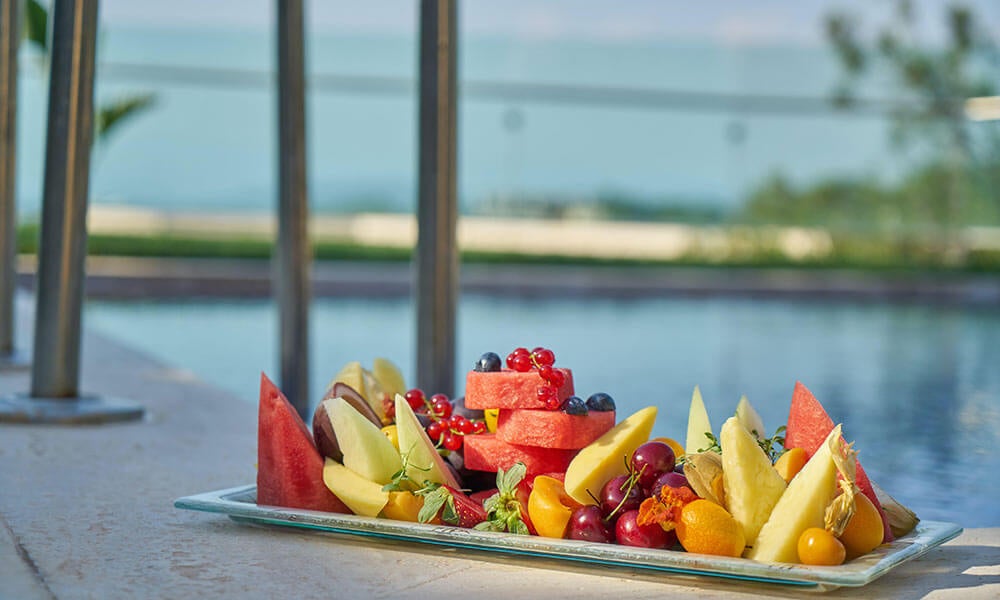
Fill out the form below and we’ll email you more information about UCF’s online hospitality programs.
- Name * First Last
- Degree * Destination Marketing and Management Event Leadership, MS Event Management Event Management, BS Financial Management for the Hospitality and Tourism Industry Hospitality and Tourism Management, MS Hospitality and Tourism Technologies Hospitality Management, BS Leadership and Strategy in Hospitality and Tourism Lifestyle Community Management, BS Lodging and Restaurant Management, BS Travel Technology and Analytics, MS
- Phone This field is for validation purposes and should be left unchanged.
Privacy Notice
The widespread popularity of food television programs and related social media have impacted local industries, and have become a catalyst for the increase in food tourism. Consequently, the demand for professionals with experience in hospitality is on the rise. This increasing demand comes from various sources, including companies in the food and beverage industry as well as local and national governments that are looking to promote food tourism.
What Is Food Tourism?
Food tourism, also referred to as culinary tourism and gastronomy tourism, is engaged in by individuals who seek out culinary experiences to broaden their understanding of a culture or lifestyle while traveling. Food tourists embark on tours that not only expand their palate, but afford them the education to identify the link between food and local customs. They search for authentic culinary experiences that expose them to new tastes, textures and traditions.
From 2012 to 2018, food tourism entered the mainstream with the help of social media platforms and food television programs featuring world-renowned chefs, restaurants and events. Food tourism evolved into an experiential industry that included festivals, wine tastings and other personalized offerings, as well as the advent of food-tourism companies.
According to Robin Back of the University of Central Florida’s Rosen College of Hospitality Management, food tourists “pursue activities where authentic culinary and other food and beverage-related activities are the primary motivator for travel. Such activities may include visits to local producers, restaurants, food festivals, markets, wineries, distilleries, and breweries” to embrace an authentic cultural experience. According to the WFTA, 63% of millennials search for restaurants that are socially responsible. The association also recognizes that a majority of food tourists want an “eclectic and authentic experience.” Moreover, 40% of tourists spend their money on food tourism according to the 2019 president, Roi Correa, of FIBEGA, an internationally recognized gastronomy tourism fair.
Social media is incredibly popular among millennials and Generation Z, and they utilize social media platforms such as Facebook, Instagram and YouTube to document their experiences. In turn, marketing departments of food and beverage companies can leverage social influencers to promote their restaurants, products or food festivals. This exposure provides a mass audience for organizations that translates into profit.
According to the WFTA, the top four food-travel activities are: eating at gourmet restaurants, dining at a famous bar/restaurant, enjoying street food, and enjoying an overall remarkable dining experience. The Journal of Gastronomy Studies reports that food tourists obtain information about gastronomic destinations mostly through television programs that feature chefs and gastronomists.
TV programs are a powerful tool that have the ability to promote destinations and can influence tourists to flock to featured restaurants. As an example, the late Anthony Bourdain’s television show Parts Unknown exposed American audiences to unfamiliar places and unique culinary experiences. His program was able to connect American audiences to a country’s culture through the lens of food tourism. Another example is the Netflix cable show Chef’s Table that exposed a global audience to food as an art form.
Top Chef on Bravo is a reality competition show that pits chefs against each other. Its season 15 premiere attracted over 2 million viewers. The show has such an influence on food tourism that the media has created the term: “Top Chef Effect.” Various cooking shows on the Food Network by world-renowned chefs such as Bobby Flay, Rachael Ray and Sandra Lee continue to contribute to food tourism.
The Impact of Food Tourism on Local Communities
The impact of food tourism can be beneficial to the growth of a local economy. However, there are downsides to food tourism that can challenge a community and destroy its cultural heritage in the search for profits.
According to Back, “A growing number of destinations are promoting their cuisine as a core tourism product. This is particularly relevant to destinations with well-known cuisines as well as wine-producing regions, where fine wine and fine food frequently go hand-in-hand.” Yet, it is important that food tourism is sustainable and retains a destination’s cultural identity. Those pursuing a career in hospitality must develop the skills and knowledge to balance the benefits of food tourism while limiting its potential negative drawbacks.
- Benefits of food tourism: According to the WFTA, food tourists spend about 25% of their travel budget on food and beverages. This can mean an increase in profits for a local community as well as the local government’s budget due to the taxes imposed on the goods purchased by tourists. This rise in revenue can afford local governments the ability to invest in marketing to tourists, which in turn can boost profits for local shops, restaurants, hotels and transportation services. An increase in culinary tourism can also instill in locals cultural pride and help ensure unemployment rates remain low, especially in rural areas with low economic activity.
- Drawbacks of food tourism: Though food tourism can have many desirable effects on a local community, in some cases the negatives may outweigh the positives. For communities that are suffering from a lack of natural resources — food, water, electricity — tourism can negatively affect the lives of those in the community. Fresh water may be re-routed to crops to sustain tourists’ demand for food, while the locals’ ability to have fresh water and food can be diminished.
Some communities can face loss of cultural identity, because the local economy has transitioned to supporting the needs of tourists. Restaurants may begin to refrain from serving local cuisine and change menus to suit the culinary needs of tourists. In some cases, the influx of tourists can drive up the prices of goods and services, which forces many locals out of their communities, thus destroying a community’s unique character.
Hospitality and Food Tourism Management
To mitigate and help avoid the negative effects of food tourism, it is crucial that local governments and businesses hire knowledgeable professionals in hospitality and management positions. Food tourists want to participate in culinary experiences that embody and celebrate the heritage of local communities. Those pursuing managerial positions in hospitality and tourism have the opportunity to educate food tourists and help them enjoy a culinary-centric vacation, while also minimizing the negative impact on local communities.
The COVID-19 pandemic has forced the food-tourism industry to discover new ways of offering innovative food-tourism experiences. Now more than ever, hospitality professionals need to ensure a safe environment for tourists to experience culinary adventures. Moreover, professionals with knowledge of technology and social media can provide food tourists with the convenience of virtually exploring wineries, distilleries and culinary destinations. As food tourism continues to change, hospitality and tourism management professionals have the unique opportunity to be a critical part of an evolving industry.
Prepare for a Career in Hospitality and Tourism
Those looking for a career in food tourism would do well to pursue a college degree. The bachelor’s online restaurant management and hospitality degree programs at the University of Central Florida are designed to help students pursue careers in restaurant and foodservice management and hospitality management. UCF offers a variety of online degree options — bachelor’s, master’s and graduate certificates — as well as multiple food-centered electives.
At the graduate level, a certificate in Event Management offers students the knowledge and skill set to effectively organize private and public events. A certificate in Destination Marketing and Management prepares students to understand the economic and socio-cultural impact that tourism has on a local community. This certificate also equips students with the skills to efficiently execute marketing campaigns.
UCF’s MS in Hospitality and Tourism Management program prepares students to pursue leadership positions throughout the industry. It also teaches the skills to analyze and implement strategic marketing and financial planning to help an organization reach its financial goals.
To highlight, UCF offers a Bachelor of Science in Restaurant and Foodservice Management that prepares students with the unique opportunity to work with professors who are skilled experts in the industry. The program teaches students the managerial and business skills essential for leadership roles in the restaurant and food-service industry. The program also offers a unique opportunity for students to get hands on experience by participating in paid internships. UCF Rosen College has entered into an exclusive partnership with LongHorn Steakhouse of Darden Restaurants to offer Restaurant and Foodservice Management students a three-semester progressive internship that encompasses kitchen-operations training, dining room operations training and manager training.
Learn more about how UCF’s online hospitality degree programs can help students pursue careers in hospitality and tourism — and become the future leaders of their industry.
Online Hospitality Degrees at UCF
- Destination Marketing and Management
- Event Leadership, MS
- Event Management
- Event Management, BS
- Financial Management for the Hospitality and Tourism Industry
- Hospitality and Tourism Management, MS
- Hospitality and Tourism Technologies
- Hospitality Management, BS
- Leadership and Strategy in Hospitality and Tourism
- Lifestyle Community Management, BS
- Lodging and Restaurant Management, BS
- Travel Technology and Analytics, MS
You May Also Enjoy


Gastronomy Tourism in a Sustainable Way
Rekindle a relationship with food! Gastronomy tourism practices allow for the tourist to foster a reconnection with food sources and information. In a society of convenience where so many have lost their connection to the sources of food, this ability to reconnect is extremely valuable.
Gastronomy tourism as defined by The Committee on Tourism and Competitiveness of World Tourism Organization (UNWTO) is a ‘type of tourism activity which is characterized by the visitor’s experience linked with food and related products and activities while travelling. Along with authentic, traditional, and/or innovative culinary experiences, Gastronomy Tourism may also involve other related activities such as visiting the local producers, participating in food festivals and attending cooking classes.’
Gastronomy tourism, or food tourism, put simply is the practice of touring for culinary, or food, experiences unique to the destination region or area. Gastronomy tourism in a sustainable way, involves the practice of actively working to avoid the depletion of natural resources while enjoying localised culinary delights.
There are several ways that the gastro tourist can engage in a sustainable way. One could consider that sustainable gastronomy tourism has a focus on the utilisation of locally grown produce which is all the better if the produce is organic or somehow otherwise made or caught locally or prepared traditionally.

Visit where the food is grown and participate in the process
Participation activities are steadily increasing in popularity. The possibility to take a village stay and participate in daily activities can include in many places, assisting with the daily tasks on tea or coffee farms. This ability to engage in local farming activities is of high value as not only a learning experience, but also to connect with the source of one’s food and the culture and history surrounding it. Most times, after a day’s helping with the farming, local food dishes will be offered by the hosting families. For the sustainable culinary tourist, this is always a delight!
Be aware that food is not always grown only on rural farms. In an effort to mitigate emissions, many localities have opted for a more immediate solution, especially in cities where the availability of vast farmland is scarce. This solution lies in rooftop gardens, microgreens and indoor solariums. A surprising amount of food can be grown, harvested and made into amazing culinary creations in these spaces. Spatial planning and growing methods have been maximised and it can be quite amazing how much can actually be generated in smaller spaces.

Eat Locally
Eating locally produced food is, of course, one of the main purposes of gastronomy tourism. Tourism destinations are full of brightly lit, intimidatingly large restaurants which cater solely to the tourism sector. As regards gastronomy tourism practices, these tourist-laden buffets would be avoided, and instead the gastro tourist would opt for a more localised approach to food. After all, foodies are said to be on the constant search for new, relevant and uniquely local cuisine.
The appeal of eating locally sourced and produced foods is multi-faceted. Not only is the traveller contributing to the community, but is able to be involved with the community. Local foods are generally acquired by visiting off-the-beaten-path establishments which are often frequented by and quite popular with the locals. Most times the traveller finds themselves immersed in conversation with their newly discovered local friends who wish to help the traveller make the best decisions for tasting the recommended dishes.
Eating locally also means that sometimes, the dish may not always be available. This is especially true with ‘catch of the day’ – meaning exactly that the protein item is what was caught that day and it is remarkably fresh, although sometimes it is possible that nothing was caught that day and therefore the sought item is not available. The travellers ability for flexibility and understanding in these circumstances and in such things as seasonal produce availability is appreciated and adds to the travellers gastronomy tourism experience and knowledge.

Incorporate the practices into one’s own lifestyle
Sustainable practices related to food, such as foraging for wild edibles, can be incorporated into one’s own lifestyle with ease. Wild edibles can range from edible weeds and wild herbs to mushroom and berry picking. Learning about these practices throughout one’s gastronomy tourism enable the traveller to live themselves a more sustainable and local food- focused lifestyle if they so choose.
Did reading this article make you hungry for more? If you would like to receive inspiration direct to your email inbox, please click here and join our newsletter!

You May Also Like

Can Grasshoppers Be a Sustainable Food Source of Protein?

5 of Africa’s Hottest Chili’s

Delicious Cuisine Tourism and its Surprising Benefits
One comment.
- eTravel.com
- Car Rentals
- Travel Inspiration
- Write For Us

What is Culinary Tourism?
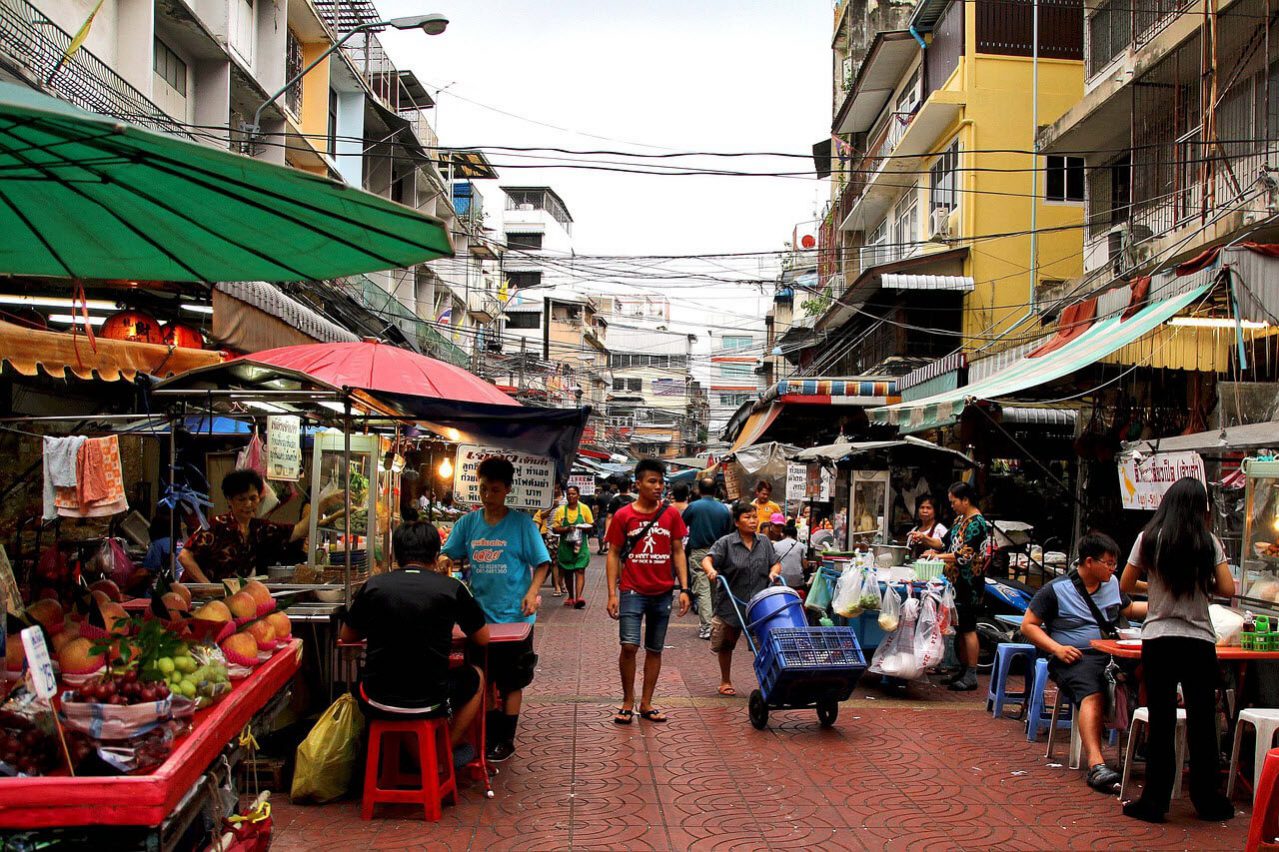
Dedicated Food Tours and Experiences
Culinary tourism coupled with cooking lessons, countries known for their fantastic offerings to food tourists.

Category: Travel Industry
Save my name, email, and website in this browser for the next time I comment.
Get the best deals and helpful tips from eTravel.com

Food Tourism: Introduction
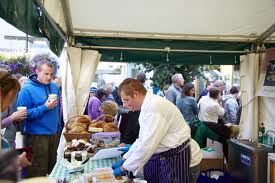
First of all, there is a consensus among the vast majority of authors the works of whom have been studied as a part of literature review that the topic of food tourism is not new. At the same time, “yet it is such an integral part of the experience that it is only in recent years that it has become a subject of study on its own right” (Hall and Sharples, 2003, p.1).
Gretzel et al (2010) link this recent rise of popularity of food tourism to technological advancement in general, and the increasing role of internet in particular, by stating that once it became easier for people to get information of various types from internet including culinary and cuisine of other nations, more and more people started to travel to other countries for the sake of trying their food.
Moreover, some authors have offered explanations about the growth of food tourism by stating the importance of the tourism destination. Specifically, it has been stated that “as the motivation to experience food and while travelling growth, destinations with appropriate levels of food and wine resources are able to develop increasingly sophisticated food and wine experiences, which may lead to the emergence of gourmet tourism” (Chen, 2009, p.165)
Among a few works that analyse the popularity of fish and chips in UK from a scientific viewpoint can be mentioned a work by Hudman and Jackson (2003). However, even this work has mainly a describing nature and lacks depth of analysis. Specifically, there are no attempts at establishing reasons of popularity of fish and chips as well as analysis of factors affecting the choice of food.
Moreover, there are some studies that evaluate the role of governments and initiatives they are proposing taking into account the economic benefits of food tourism to any destination. For instance, in case of UK it has been stated that “while state intervention in agriculture policy and the economic context for agricultural production has been long established, a new policy framework that integrates support for farming together with rural development…has became evident in food tourism initiatives across the United Kingdom” (Slocum and Everett, 2010, p.745)
- Value of Culinary Education
- Financing Your Education
- Austin Student Life
- Boulder Student Life
- Culinary & Pastry Careers
- Hospitality Careers
- Health & Wellness Careers
- Food Entrepreneurship
- Success Stories
- World of Food & Drink
- Recipes & Techniques
- Culinary Arts
- Baking & Pastry Arts
- Blog Search
- Financial Aid
- Career Services
- Online Culinary Arts Programs
- Austin Culinary Arts Programs
- Boulder Culinary Arts Programs
- Online Baking & Pastry Programs
- Austin Baking & Pastry Programs
- Boulder Baking & Pastry Programs
- Food Entrepreneurship Programs
- Plant-Based Programs
- Holistic Nutrition & Wellness Programs
- Hospitality & Restaurant Operations Management
- Enthusiast Cooking Classes
- Find Your Program
- Tuition & Fees
- Financial Aid Overview
- Federal Financial Aid Programs
- Scholarships & Grants
- GI Bill ® for Military & Veterans
- Contact Financial Aid
- New Student Checklist
- Military & Veterans
- High School Students
- International Students
- Student Stories
- Admissions Overview
- Application Process
- Open Houses & Events
- Schedule a Tour
- Student Housing
- Online Programs
- Austin, Texas Campus
- Boulder, Colorado Campus
- Our Chef Instructors
- Farm To Table ® Experience
- Accreditations
- Vision, Mission, & Core Values
- Alumni Profiles
- History & Timeline
- Request Information
- Student Login
- (855) 955-7555
- Search for:
What Is Food Tourism? A Guide to Culinary Career Opportunities
Foodie adventures and dream jobs await! Explore how you can combine culinary passion and travel with a career in food tourism.

Take the Culinary Career Survey
We’ve compiled a checklist of all of the essential questions into one handy tool: career options, culinary interest surveys, educational opportunities, and more.
Clicking the "Get the Survey Now" button constitutes your express request, and your express written consent, to be contacted by and to receive automated or pre-recorded call, texts, messages and/or emails from via phone, text, and/or emails by Auguste Escoffier School of Culinary Arts at the number(s)/email you provided, regarding furthering your education and enrolling. You understand that these calls , texts, messages and/or emails may be generated using an automated or pre-recorded technology. You are not required to agree to receive automated or pre-recorded calls, texts, messages or emails as a condition of enrolling at Escoffier. You can unsubscribe at any time or request removal of street address, phone number, email address via Escoffier website .
Listen to This Article:
Imagine your ideal vacation. Maybe you’re relaxing under a palm tree on a white sandy beach or backpacking through rugged mountains featuring breathtaking views. Or maybe you’re like a growing number of travelers who enjoy experiencing a new culture through unique dining experiences and locally sourced ingredients.
Picture unwinding in a private villa in the Napa Valley vineyards, partaking in private tastings, and indulging in local Meyer lemons and Dungeness crab. Food can serve as a powerful lens, allowing us to more fully experience new destinations, which is one reason food tourism is a growing trend.
According to some private-sector research, a majority of travelers research restaurants before heading out on vacation . But some travelers take it a step further. A recent report by the World Travel Association (WFTA) found that 34% of travelers select their destination based on food .
This growing interest in connecting travel and the culinary world raises the questions: What is food tourism and what careers exist in the industry?
What Is Food Tourism?
What are some examples of food tourism.
- Traveling to New Orleans to try authentic dishes and drinks like Creole Jambalaya, beignets, and a hurricane cocktail
- Visiting Italy, to indulge in pizza, pasta, and gelato the way it was meant to taste
- Staying in Spain, to experience heritage recipes for paella, tapas, and churros
- Venturing over to Japan, to experience sushi, ramen, and tempura made by locals
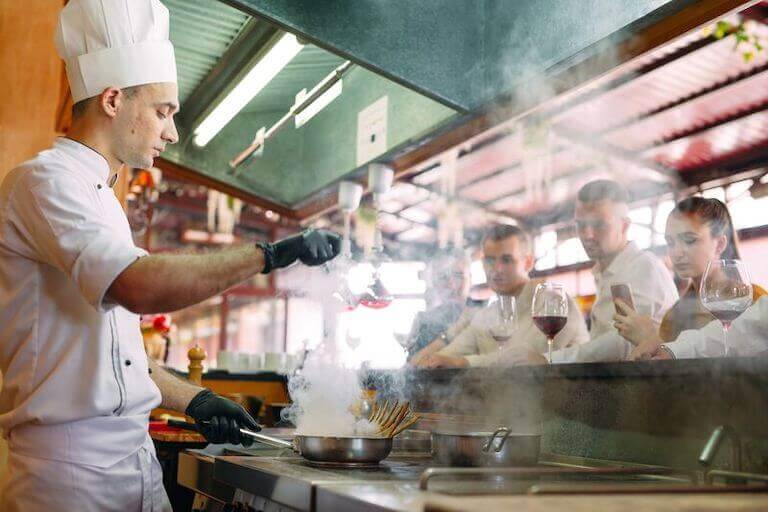
Tourists enjoy interacting with chefs as their meals are prepared.
Travelers are looking to learn more about the regions they travel to through food experiences such as farm-to-table tours and restaurants, trips through local markets, and interacting with the chef as their food is prepared. They’re looking for local flavors and specialties they can’t find anywhere else, which is creating unique opportunities for creative chefs.
Food tourism experiences can also help preserve traditional cooking methods and regional cuisines, ensuring their legacy lives on for future generations. It’s a win-win situation for locals and travelers alike.
Why Is Food Tourism so Popular?
While the term “foodie” arrived on the food scene in the 1980s, it began to gain steam in the 1990s when food television grew in popularity. The foodie community began to connect even more once the internet and social media made it easier to share and follow each others’ experiences and the works of celebrity chefs .
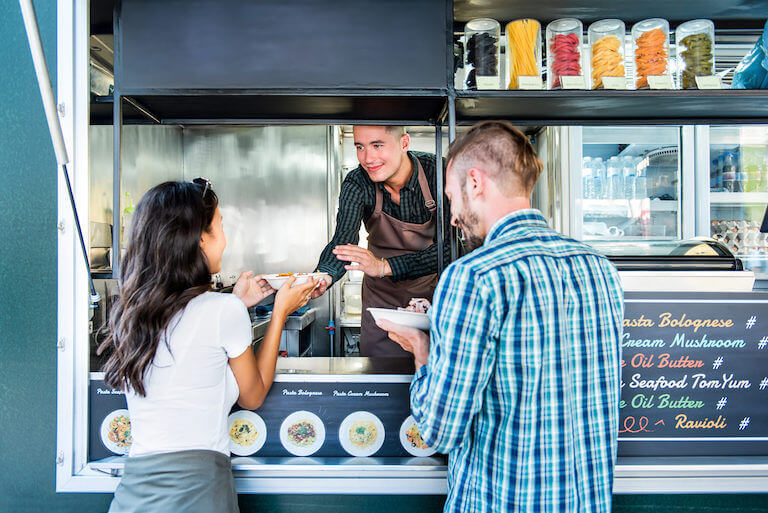
Food trucks grew in popularity along with the foodie scene.
In fact, the majority of Millennials and Gen Z would rather spend their money on experiences like traveling instead of saving for the future. In addition, they have become more interested in experiencing authentic culture as they travel instead of wanting to see landmarks or visit popular theme parks.
The younger generations want to move past sightseeing and see how the locals are living—and eating. Why visit a predictable amusement park when you could take a small catamaran to an island off the coast of Mexico where you can eat homemade tortillas prepared by the locals?
And it doesn’t appear to be a fading trend. The food tourism market is strong and expected to continue growing by 15.20% through 2033. With this in mind, it brings new and innovative opportunities for chefs looking to put a different spin on their careers.
Culinary Tourism Creates Exciting Career Opportunities
The increasing popularity of culinary tourism is creating unique opportunities for both chefs and food influencers . There are many ways you can combine your passion for food, culinary experiences, travel, or your local area into money-making opportunities.
Opportunities for Those Who Love to Travel
Do you want to see the world? Or do you have a favorite destination that you’d love to live in long-term or temporarily? There are many opportunities around the world for chefs and others passionate about cuisine in the food tourism industry. If you want to be part of it, here are some ideas for how you can combine your career and hobbies:
1. Partner with Tour Companies
You can partner with travel agencies and tour operators to create one-of-a-kind experiences for travelers. This could include taking groups to local farms and markets to purchase ingredients and educating them on the significance of the ingredients in the local culture throughout history. Escoffier’s Farm To Table Experience offers great examples of how local farming can influence culinary culture.

Food tourists are interested in learning more about the local food scene, including where to source ingredients, like the farmer’s market.
2. Cook for Guests as a Private Chef on a Yacht
Create a luxurious dining experience by working as a private chef on a yacht. You can personalize multi-course meals for private clients or charter guests while incorporating local ingredients from exotic destinations. You get the bonus of stunning ocean views day and night. Several professional organizations exist that can help you on your personal chef journey, including the United States Personal Chef Association and the American Personal & Private Chef Association (founded by friend of Escoffier Candy Wallace).
3. Join Adventure Groups as an Expedition Chef
If you enjoy trekking through the mountains, join an adventure tour company like Overland Cookery . You can prepare meals for hikers and campers throughout their journey. Or, you could prepare delicious meals for travelers to return to after an adventurous day of spotting animals on a South African safari. Get creative thinking about your favorite place to travel and how you could be a part of creating an unforgettable food experience for others.
4. Hit the Road as a Food Influencer
Professional chefs have a unique voice and experience to add to the world of food influencers. If you enjoy travel, you could spend your time traveling while learning about and sharing food experiences with others online. You can help foodies plan their next vacation by covering the best food to try and experiences to participate in throughout the world.
The Food Entrepreneurship Courses at Escoffier include classes in social media content development, food blogging, and hospitality marketing that can help you take the next step.
5. Provide Services as a Restaurant Consultant
Lend your culinary knowledge and experience to restaurants around the world. You can assist restaurants in menu development, improved food quality, and staff training. Become known as the expert in a specific culinary area and travel to teach others how they can do the same. Explore ways a degree in Hospitality and Restaurant Operations Management can help.

Opportunities for Those Who Want to Stay Local
You don’t have to travel to work in and support the world of culinary tourism if you want to stay close to home. There are plenty of opportunities, including the following, for chefs looking to stay local.
1. Host Cooking Classes
Host cooking classes to teach tourists about local culinary techniques and regional dishes. Educate participants on the differences in your local ingredients. Incorporate pieces of local history and storytelling throughout the experience to engage tourists and help them learn more about your area and culture.
2. Participate in Food Festivals
Food festivals , such as the South Beach Wine & Food Festival and Disney California Adventure Food & Wine Festival, are popular among foodies. Join a festival in your area or partner with other food experts to start a food festival to attract tourists. You can provide culinary demonstrations to showcase your skills and promote your region’s culinary heritage.
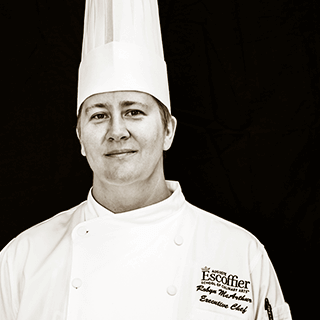
3. Work as a Private Chef
With the help of companies like Airbnb, many travelers enjoy staying at a house instead of a hotel or resort while traveling. You can help them enjoy an authentic experience by working as a private chef for their trip. You can prepare a lavish spread using local ingredients while customizing the menu for specific travelers.
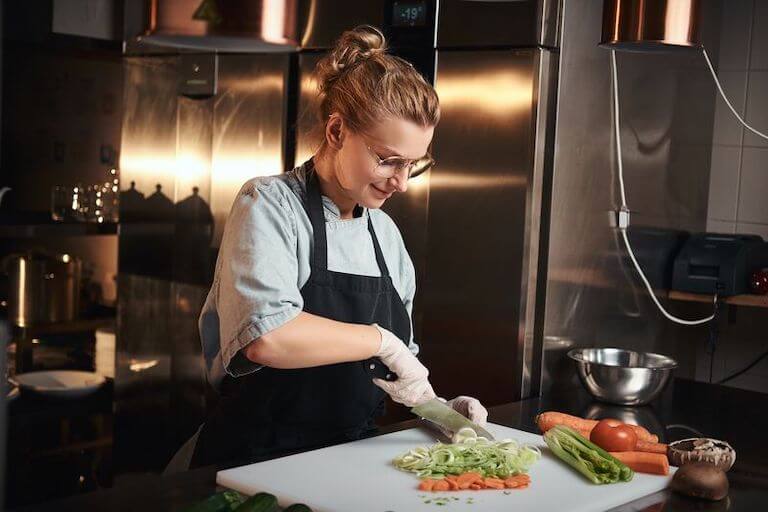
Private chefs can help tourists enjoy authentic cuisine at every meal.
4. Food Tour Guide
Help take travelers past the tourist hotspots to find the best authentic dishes and culinary experiences the locals love in your city. Lead groups to the best restaurants, sharing what dishes will meet their needs. Take them on behind-the-scenes tours of the restaurants or create experiences where they can meet the Executive Chef.
5. Develop Local Food Tourism Opportunities
With the increase in food tourism, cities are working to create new experiences to help draw tourists. There are many ways you can partner with local government and business owners to put your city on the food tourism map. Here are some ideas to get you started:
- Create themed menus for restaurants in your local area.
- Collaborate with local producers, from farmers to cheesemakers and artisanal bakers, to source fresh local ingredients for your dishes.
- Offer special tasting events featuring local ingredients and specialties.
- Work as a food tourism advocate. Connect with other local chefs, restaurants, and food businesses to bring new culinary offerings to your area.
The food tourism industry is wide open. Look for ways to pair your culinary skills with other passions to create one-of-a-kind experiences for travelers from near and far.
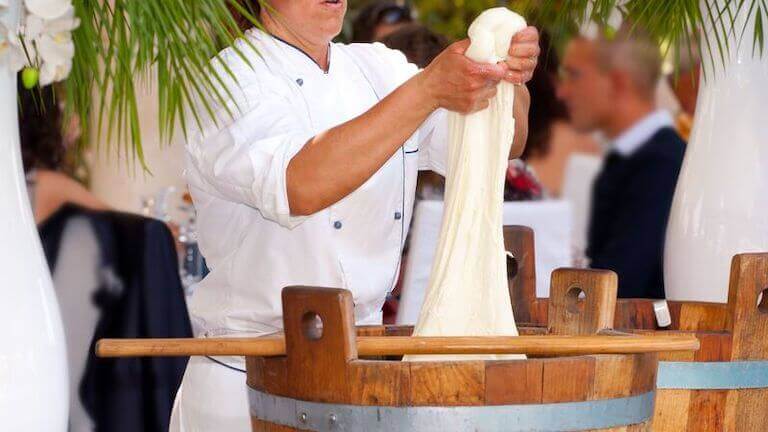
Providing unique culinary experiences and behind-the-scenes experiences can draw tourists.
If the food tourism industry is calling your name, you can set yourself apart from other chefs by developing additional skills that will help you serve in these unique career opportunities.
Non-Culinary Skills for Success in Food Tourism
Food tourism is about more than just local ingredients and cooking. Outside of your culinary skills, the following skills can help you succeed in a career in the culinary tourism industry:
- Storytelling Skills : Creating the authentic experience tourists are looking for includes good communication skills and being a captivating storyteller. Share local heritage and cultural narratives throughout the culinary experience. Engage with people to share your local knowledge and answer their questions to create a personalized experience.
- Business Acumen : Understanding business principles such as marketing and promotion can help you attract customers to your culinary experience while understanding the numbers behind the business will help you price your offerings right.
- Cultural sensitivity : Food is deeply connected with local culture, and having cultural sensitivity helps you communicate local and historical traditions in a meaningful way.
Combining these skills can help you create one-of-a-kind experiences for travelers while establishing yourself in a career that you can enjoy personally and professionally. If you’re interested in starting your own business in the food tourism industry, explore how a food entrepreneurship program can help you get started.
How to Take the Next Step for a Career in Food Tourism
Food tourism is a travel trend that is here to stay. It provides transformative experiences for travelers, allowing them to immerse themselves in unique flavors, local culture, and regional traditions.
The travel landscape continues to evolve with the changing generations, creating new and exciting opportunities in the culinary and hospitality world. If you’re passionate about food and enjoy creating unique experiences along with delicious cuisine, a career in food tourism might be right for you. Contact us to learn more about how you can combine your interests and passions with an exciting career in culinary tourism.
CHECK OUT THESE ARTICLES NEXT!
- Career Options For Culinary School Graduates
- What Skills Do You Need for a Career in Hospitality and Tourism?
- How You Can Get a Job on a Cruise Ship
*Information may not reflect every student’s experience. Results and outcomes may be based on several factors, such as geographical region or previous experience.
Latest Articles
Table setting etiquette 101: a brief guide.
The right table setting is a great way to establish ambiance for your event or restaurant. Find out the proper way to set a table for basic, casual, or formal settings.
How to Butterfly Cut Meats and Poultry
Find out what a butterfly cut is, why it’s important, and the proper technique in this butterfly cutting guide.
“See as Much as You Can”: Chef Instructor Gregory Bonath’s Lifelong Embrace of Curiosity
With the support of family and mentors, Chef Gregory left his small town behind and embarked on a unique culinary career that has culminated at Escoffier.

Subscribe to the King of Chefs Blog
Get the King of Chefs email newsletter delivered to your inbox weekly. You'll get everything you need to know about culinary & pastry careers, food entrepreneurship, financing your culinary education, and more.
The Essential Culinary School Planner & Checklist

We’ve compiled a checklist of all of the essential questions into one handy workbook: Career options, academic plans, financing your education, and more.
Clicking the "Get the Workbook Now" button constitutes your express request, and your express written consent, to be contacted by and to receive automated or pre-recorded call, texts, messages and/or emails from via phone, text, and/or emails by Auguste Escoffier School of Culinary Arts at the number(s)/email you provided, regarding furthering your education and enrolling. You understand that these calls , texts, messages and/or emails may be generated using an automated or pre-recorded technology. You are not required to agree to receive automated or pre-recorded calls, texts, messages or emails as a condition of enrolling at Escoffier. You can unsubscribe at any time or request removal of street address, phone number, email address via Escoffier website .

IMAGES
COMMENTS
FOOD TRAVEL & FOOD TOURISM. "The act of traveling for a taste of place in order to get a sense of place.". Our definition of this phrase automatically includes beverages because "food and beverage tourism" is cumbersome to say. Also, it is implied that if people are eating, they are probably drinking as well.
Food tourism is a relatively new term, but there are already several definitions to describe it. In the same context, it is also common to find the terms Culinary Tourism and Gastronomy Tourism.. At Food'n Road, we define Food Tourism as activities that provide experiences of consumption and appreciation of food and beverages, presented in such a way that values the history, the culture, and ...
Food tourism can also have a positive impact on the destination. For destinations, food tourism: Can help to promote the local cuisine and culture. Is a great way to attract visitors and boost the local economy. Can help to create jobs and support local businesses (1). Can help to improve the image of the destination.
As food tourism includes learning from different cultures, the food tourist seeks experiences on local identity and authenticity. Food tourism has a physical presence. From a cultural perspective it is the behaviour, knowledge and customs of location that combined and thus it creates a sense of place and identity.
Food tourism is a vitally important component of the travel and tourism industry as a whole. When booking a trip, people tend to consider a variety of factors - and food is high on the list of priorities. The World Food Travel Association says that money spent on food and drink while travelling accounts for 15-35% of all tourism spending.
Culinary tourism. Culinary tourism or food tourism or gastronomy tourism is the exploration of food as the purpose of tourism. [1] It is considered a vital component of the tourism experience. [2] Dining out is common among tourists and "food is believed to rank alongside climate, accommodation, and scenery " in importance to tourists.
Term. Definition. Food tourism. "The act of traveling for a taste of place to get a sense of place" (World Food Travel Association a ), i.e., traveling to a destination with either part or the whole reason for traveling being the specific purpose of trying the local foods. Ethnic food. Food with a cultural narrative and history.
As a starting point, from a definition perspective Hall and Sharples (2003, p.10) provides an excellent preliminary understanding of food in tourism which is the major motivation, describing food tourism as "visitation to primary and secondary food producers, food festivals, restaurants and specific locations for which food tasting and/or ...
Culinary tourism is the focus on food as an attraction for exploration and a destination for tourism. Although food has always been a part of hospitality services for tourists, it was not emphasized by the tourism industry until the late 1990s. It now includes a variety of formats and products - culinary trails, cooking classes, restaurants ...
In fact, the new era of food tourism is defined by its conscious and thoughtful nature. The best food and drink experiences for travelers today consider environmental sustainability as well as community and economic impact. This is especially important in developing destinations with fragile ecosystems.
Gastronomy. Gastronomy is about much more than food. It reflects the culture, heritage, traditions and sense of community of different peoples. It is a way of promoting understanding among different cultures, and of bringing people and traditions closer together. Gastronomy tourism is also emerging as an important protector of cultural heritage ...
All Regions; 7 Sep 12 UNWTO AM Report Vol. 4 'Global Report on Food Tourism' The Global Report on Food Tourism, Volume No.4 of the UNWTO Affiliate Members' series of in-depth reports explores the links between tourism and food.. For many of the world's billions of tourists, returning to familiar destinations to enjoy tried and tested recipes or travelling further afield in search of new ...
using food tourism as it is more encompassing of the offerings (e.g. farms, artisanal producers), while the culinary term "can sometimes have an exclusive or elitist ring to it" (WFTA, 2018, p. 7). The UNWTO adopted the most used definition of food tourism, as proposed by Hall & Mitchell (2001). Table 1
The study aims to study the development of research on food tourism (FT) and provide insights into key contribution, journals, authors and suggests future research actions. The study uses the Web of Science (WoS) core database to identify the articles published on the theme. The study then uses descriptive and bibliometric indicators to analyse ...
World historian Felipe Fernández-Armesto suggests a similarly long view of culinary tourism in his book Near a Thousand Tables: A History of Food (2002). He identifies eight "revolutions," or paradigmatic shifts in the ways humans use and think about food, including the rise of agriculture and herding, the development of cooking and manners, and long-distance trade and industrialization.
The compound annual growth rate for food tourism is expected to increase by 9% between the years 2019-2023 according to a recent report by Technavio, a market research company in the United Kingdom. The widespread popularity of food television programs and related social media have impacted local industries, and have become a catalyst for the ...
Gastronomy tourism, or food tourism, put simply is the practice of touring for culinary, or food, experiences unique to the destination region or area. Gastronomy tourism in a sustainable way, involves the practice of actively working to avoid the depletion of natural resources while enjoying localised culinary delights.
Culinary tourism, aka food tourism, is a new and vibrant category of specialized tourism where people go places in order to sample authentic cuisine and truly immerse in the experience of living in that place through the food. Quite often, this also includes local beverages, cheeses, chocolates, etc.
A typical definition of food tourism would is like a "visitiation to primary and secondary food producers, food festivals, restaurants and specific locations for which food tasting and/or experiencing the attributes of specialist food production regions are the primary motivating factors for travel" (Buhalis and Costa, 2006, p.137). To make ...
Food tourism has received increasing attention for its versatility to contribute to the socio-cultural and environmental aspects of tourism, and tourism studies and food tourism research have benefited greatly from this tourist perspective. ... Scope, definition and structure. N.K. Prebensen, J.S. Chen, M.S. Uysal (Eds.), Creating experience ...
Food tourists are interested in learning more about the local food scene, including where to source ingredients, like the farmer's market. 2. Cook for Guests as a Private Chef on a Yacht. Create a luxurious dining experience by working as a private chef on a yacht.
tourism, the act and process of spending time away from home in pursuit of recreation, relaxation, and pleasure, while making use of the commercial provision of services.As such, tourism is a product of modern social arrangements, beginning in western Europe in the 17th century, although it has antecedents in Classical antiquity.. Tourism is distinguished from exploration in that tourists ...
What is local food? As described in the preceding section, local food initiatives at the destination level can be viewed as a response to the economic, environmental, and social facets of tourism destinations (Hall & Gössling, Citation 2013).Indeed, their promotion has been equated with a sustainable turn in destination marketing practises, aiming not only to increase the number of tourists ...